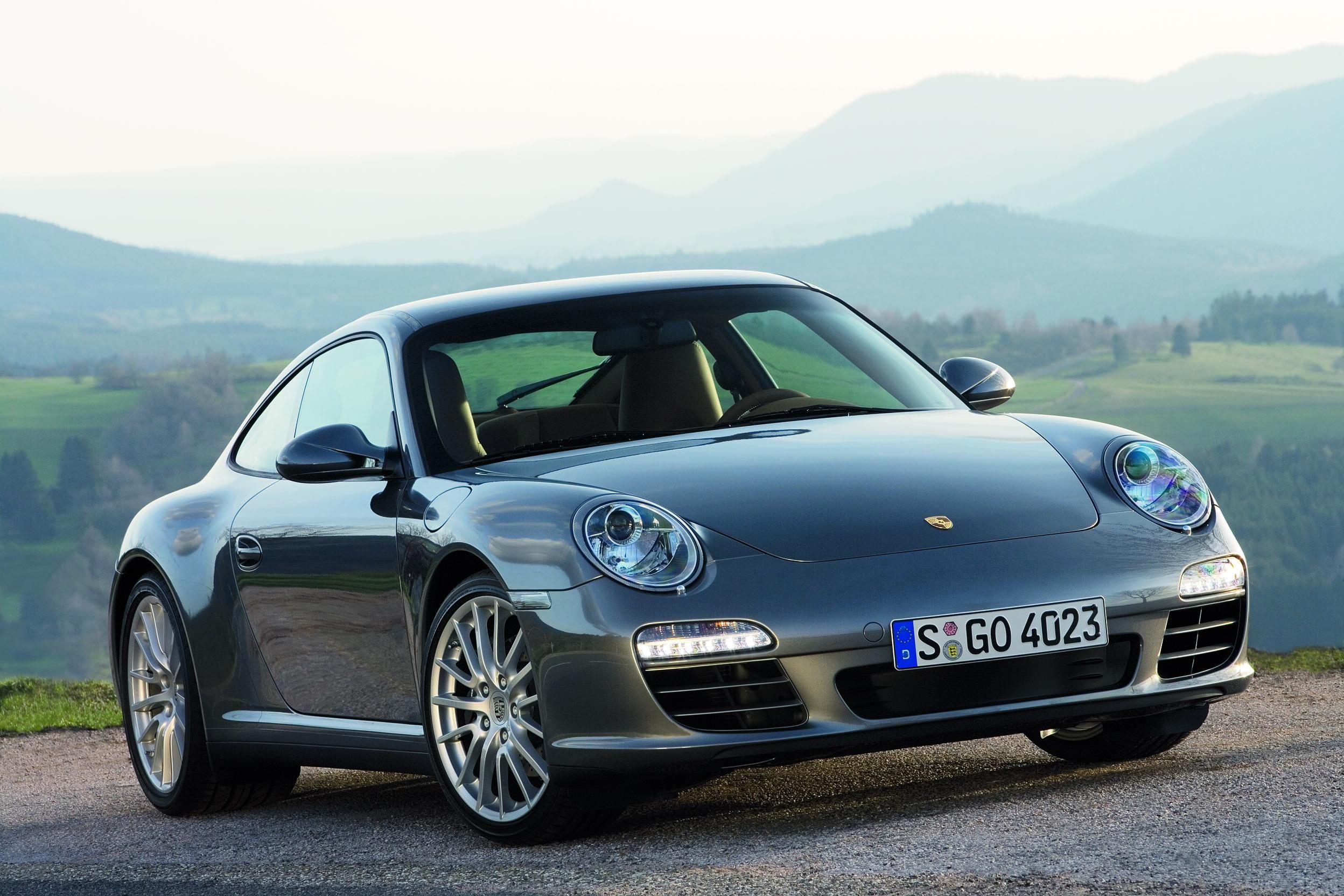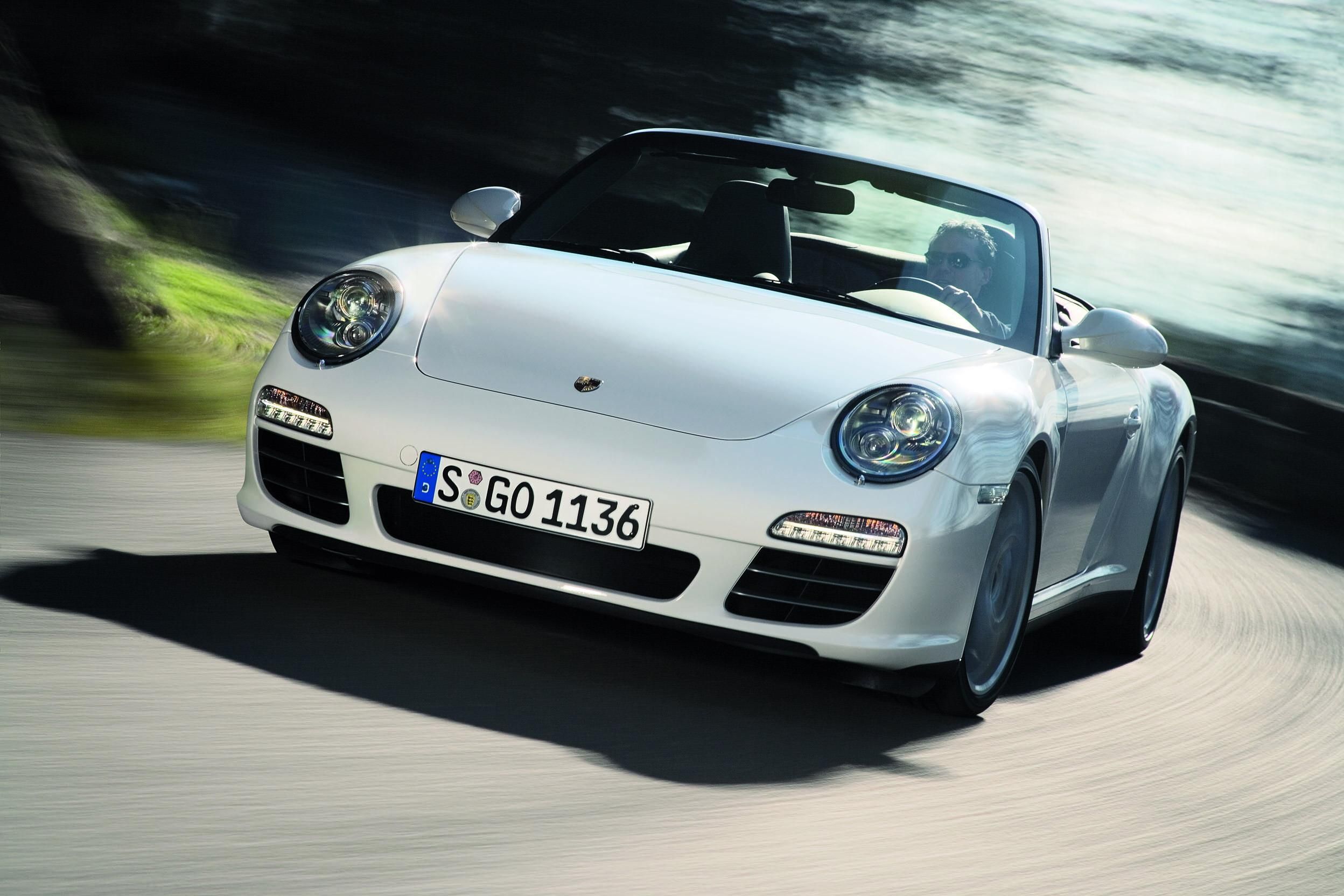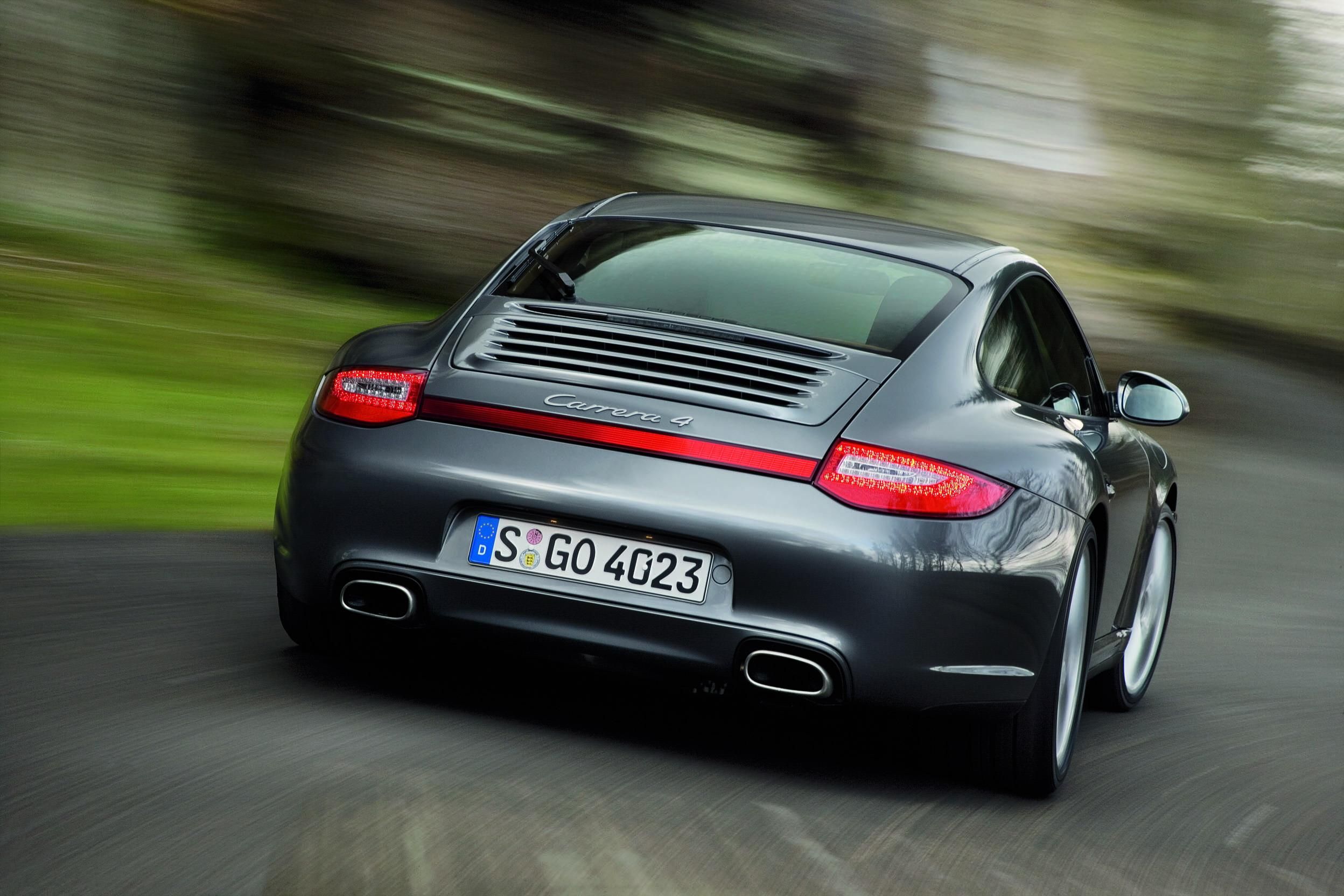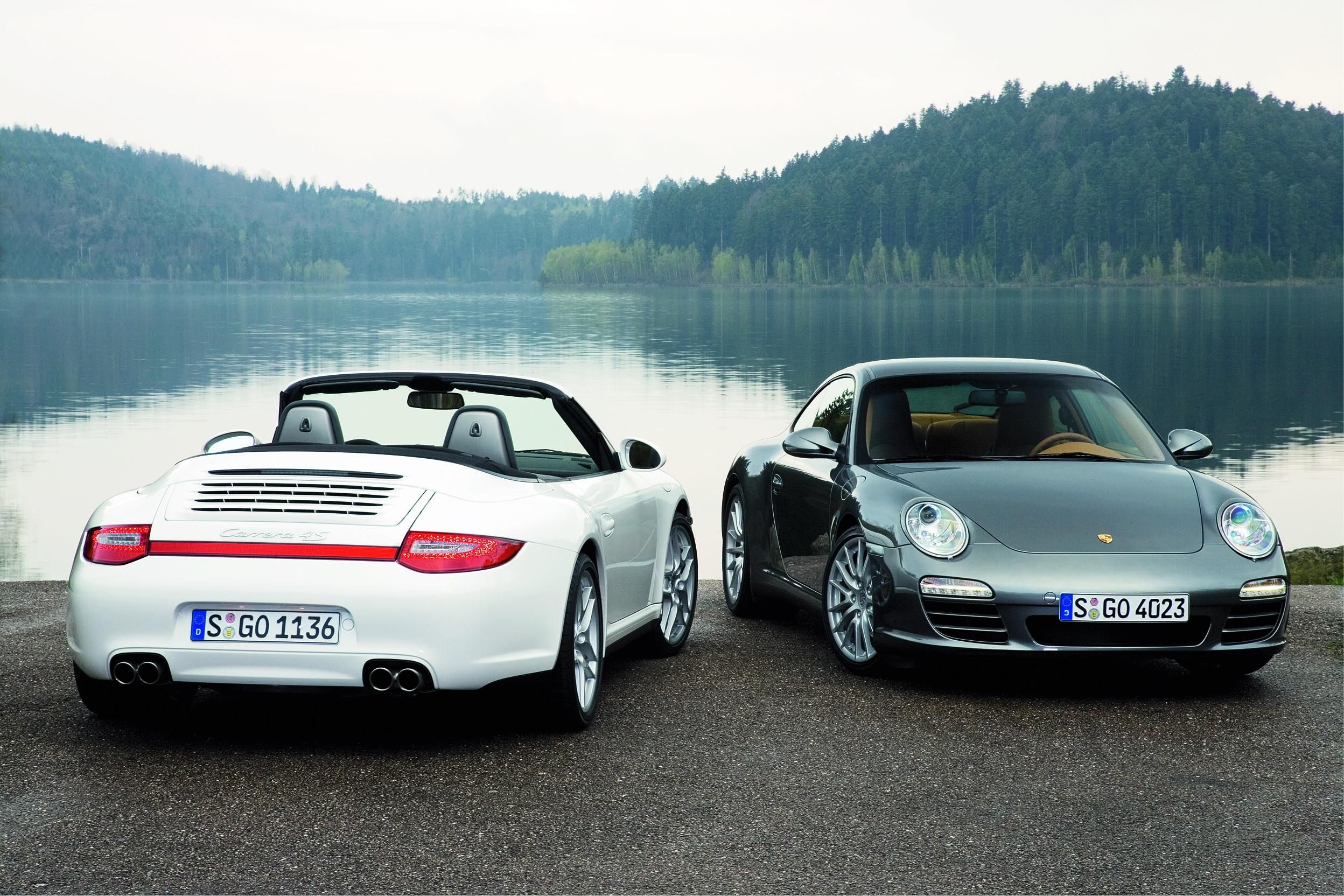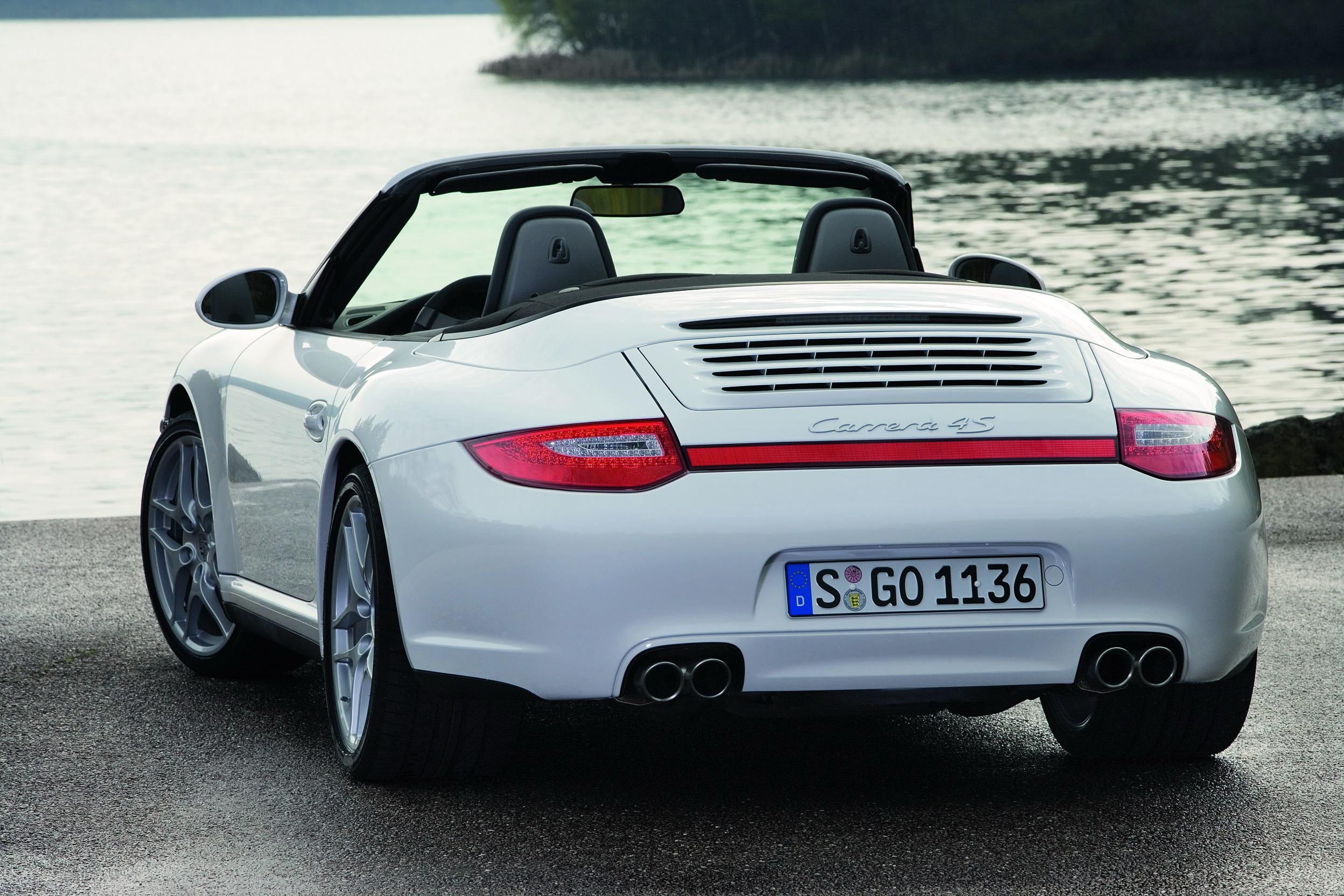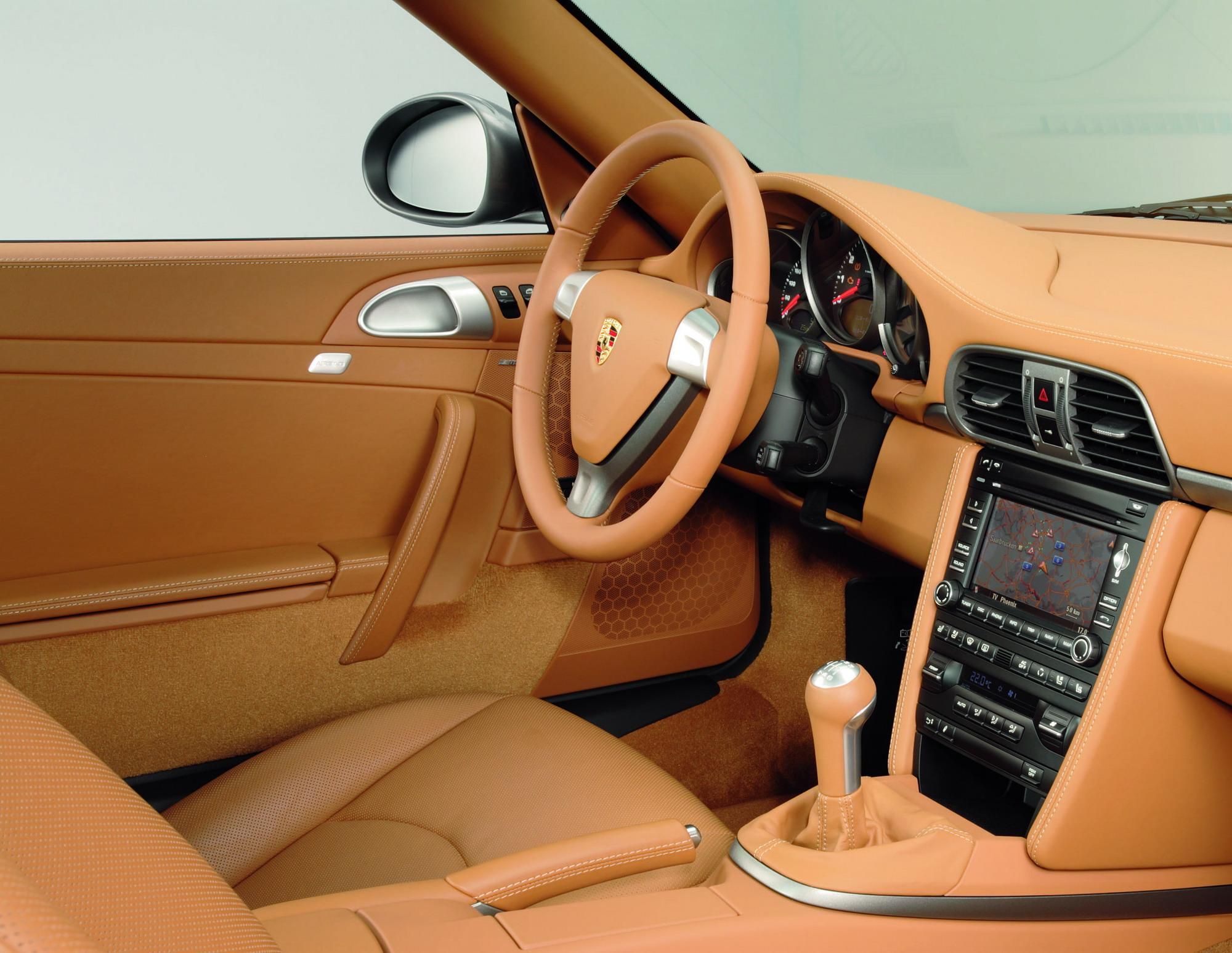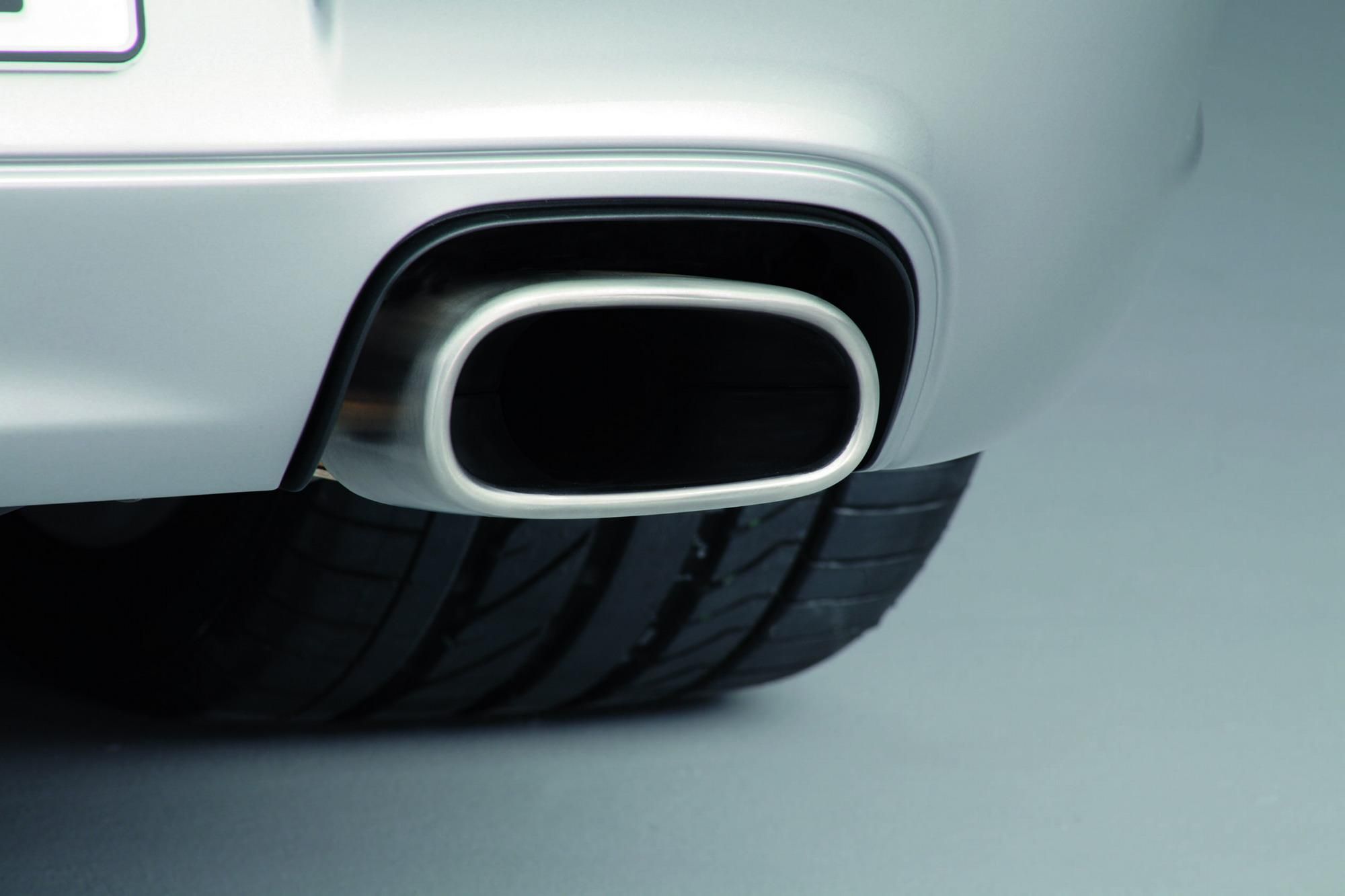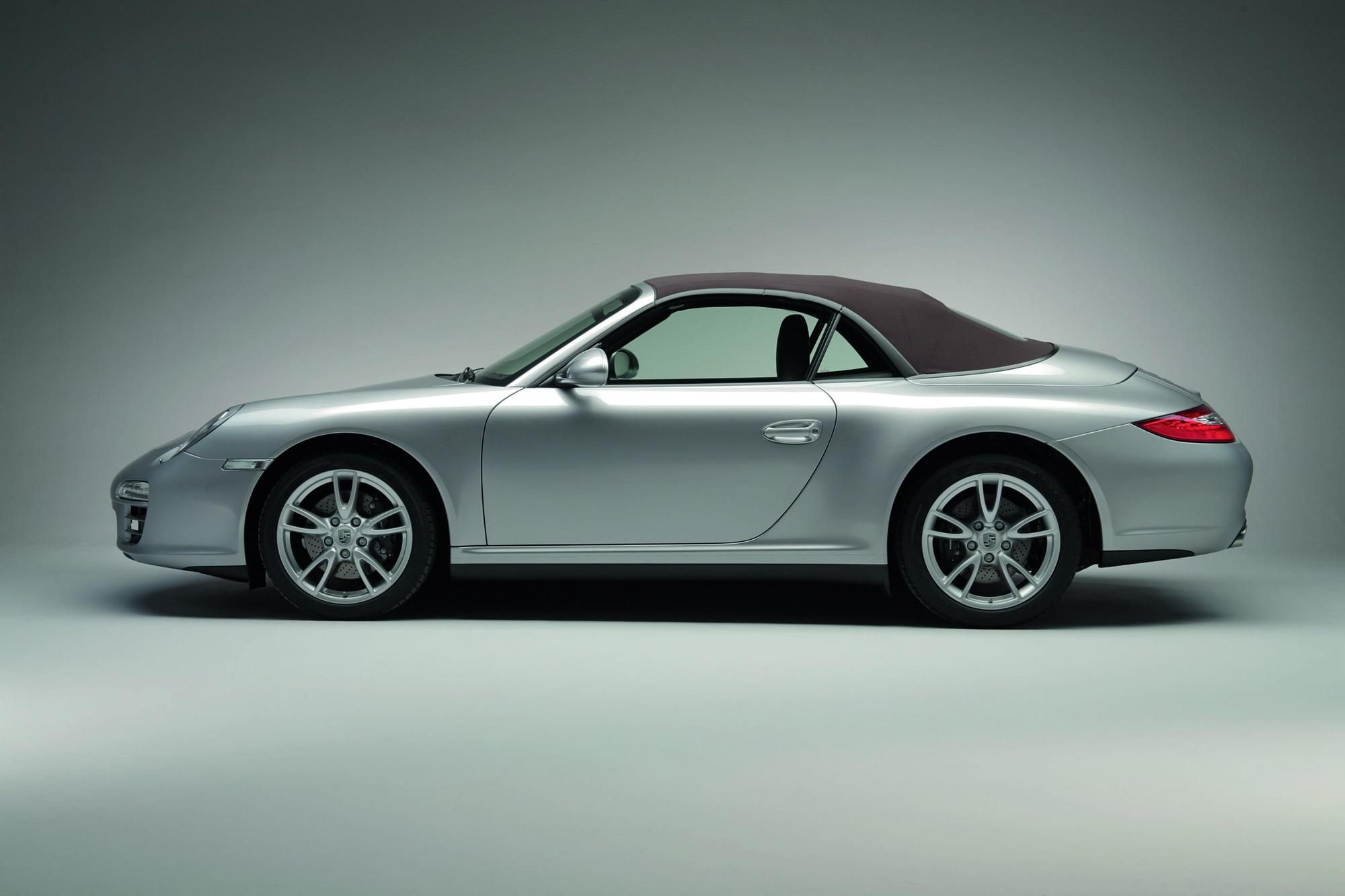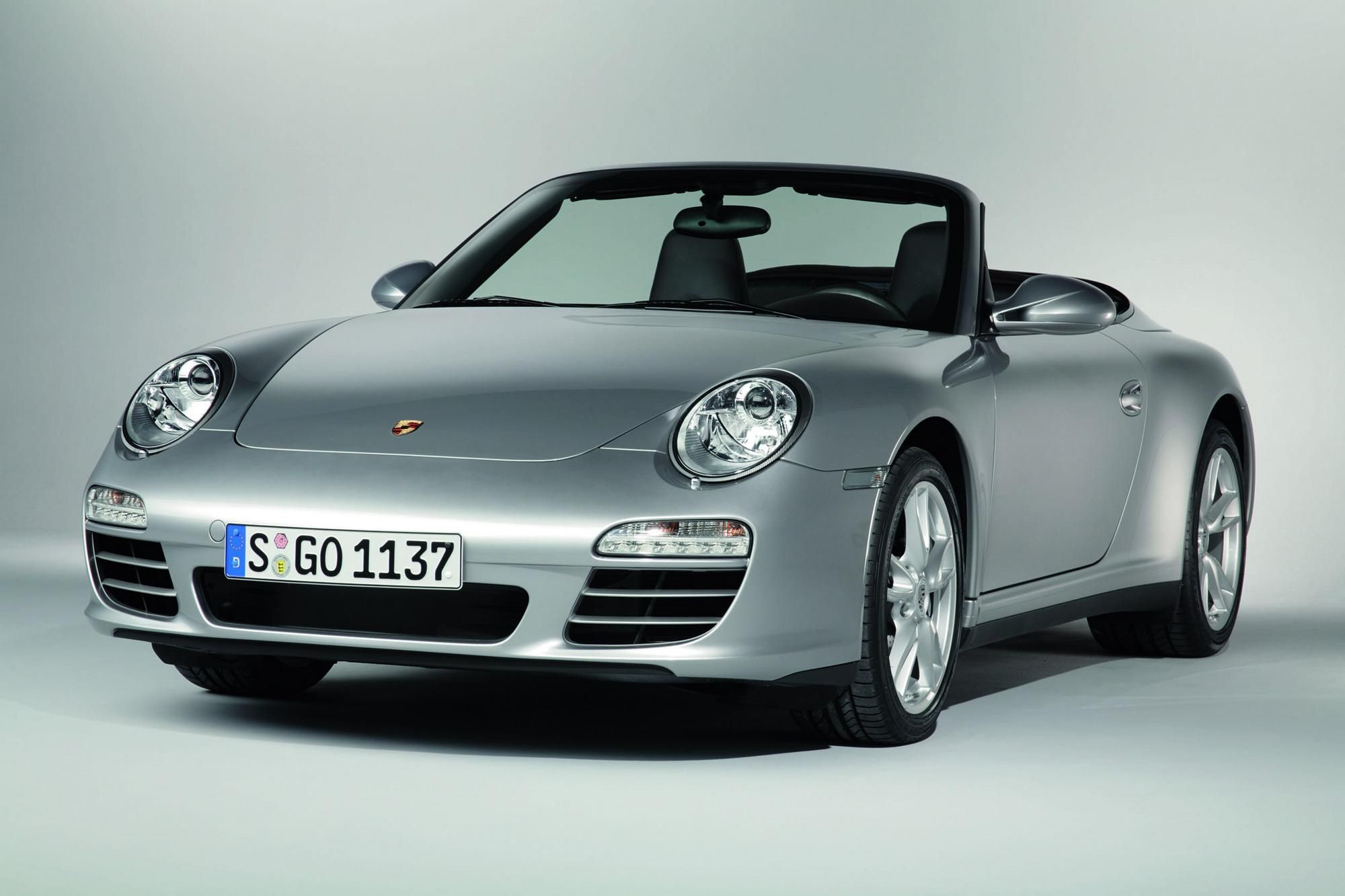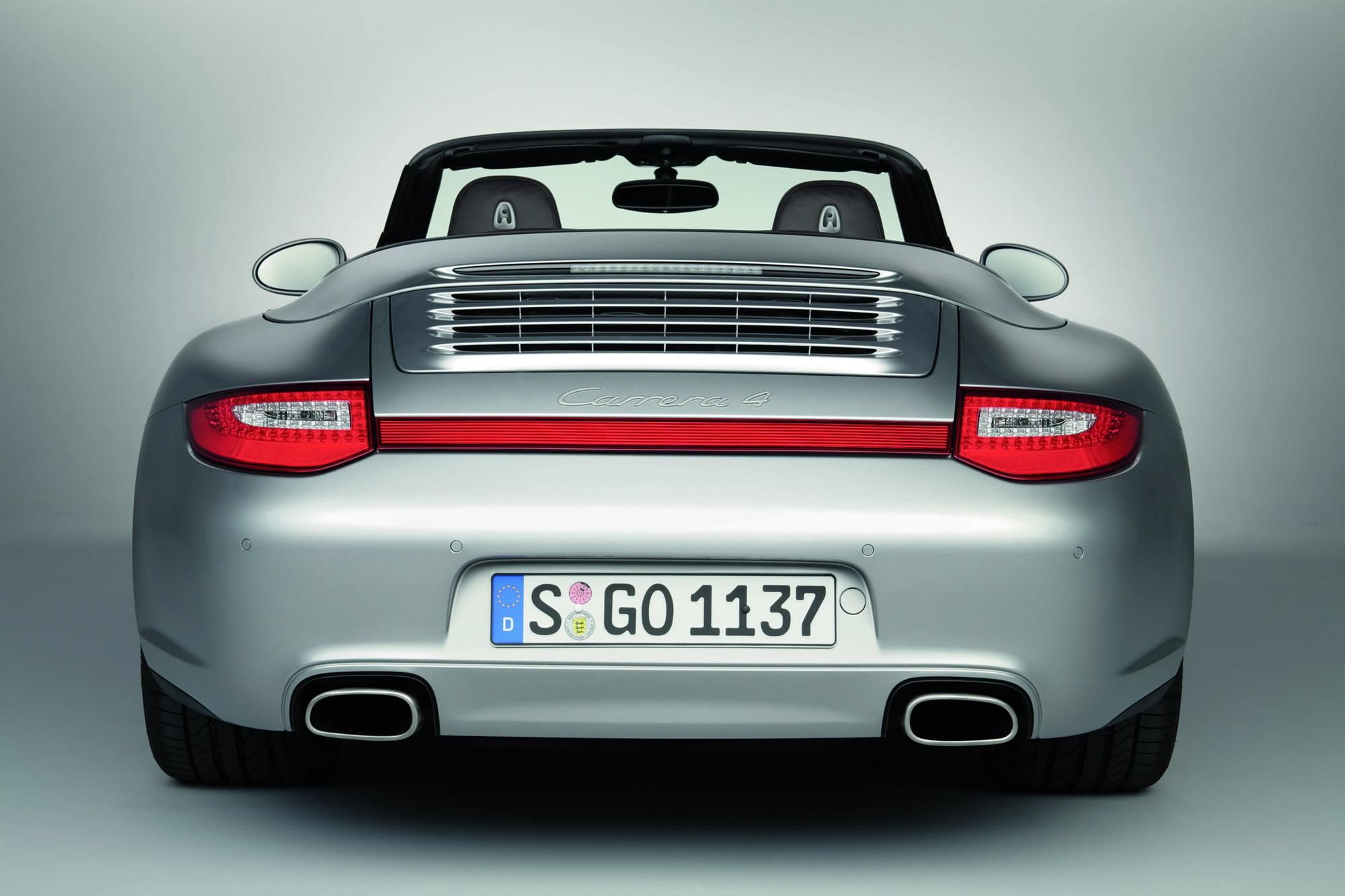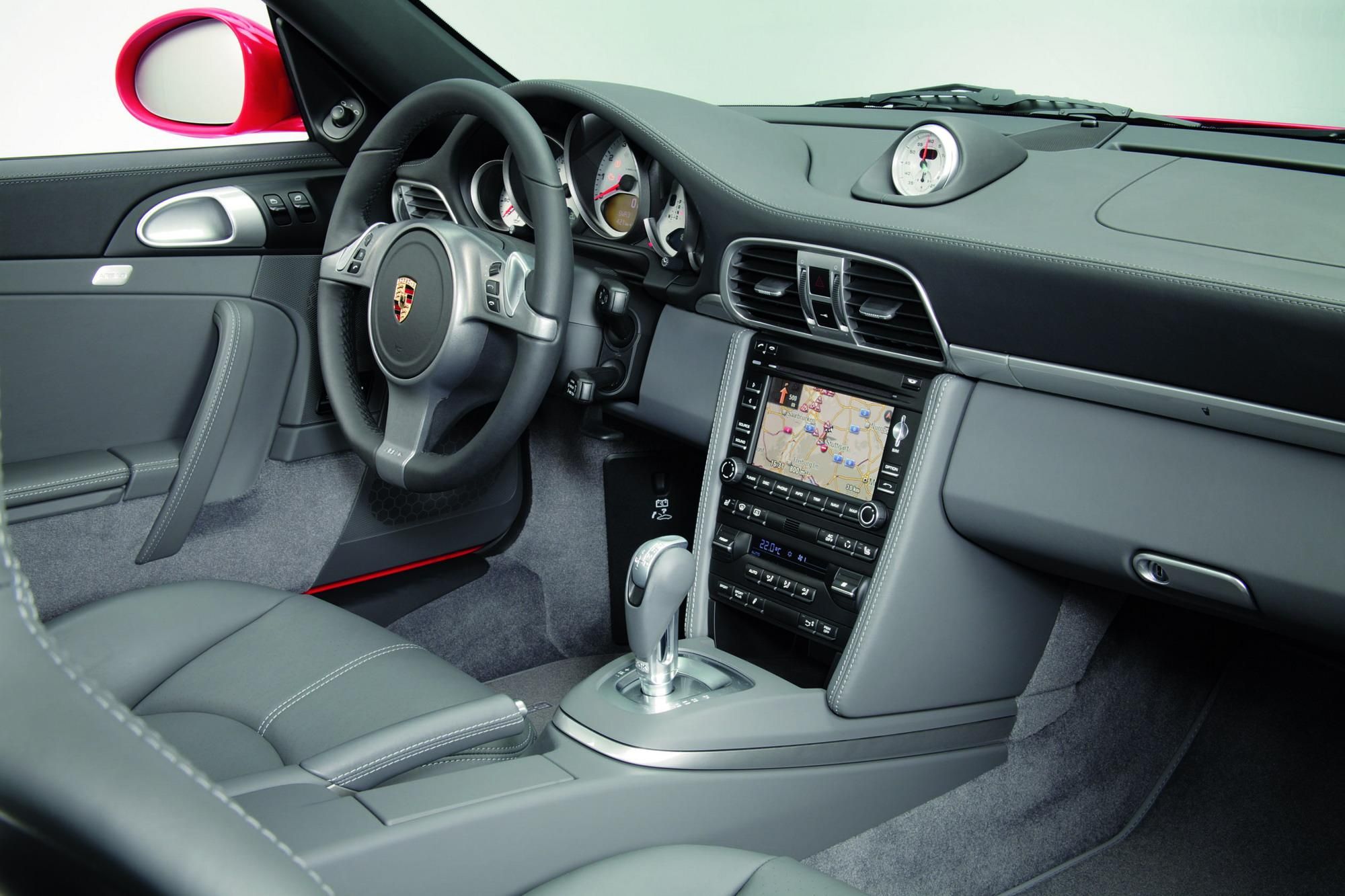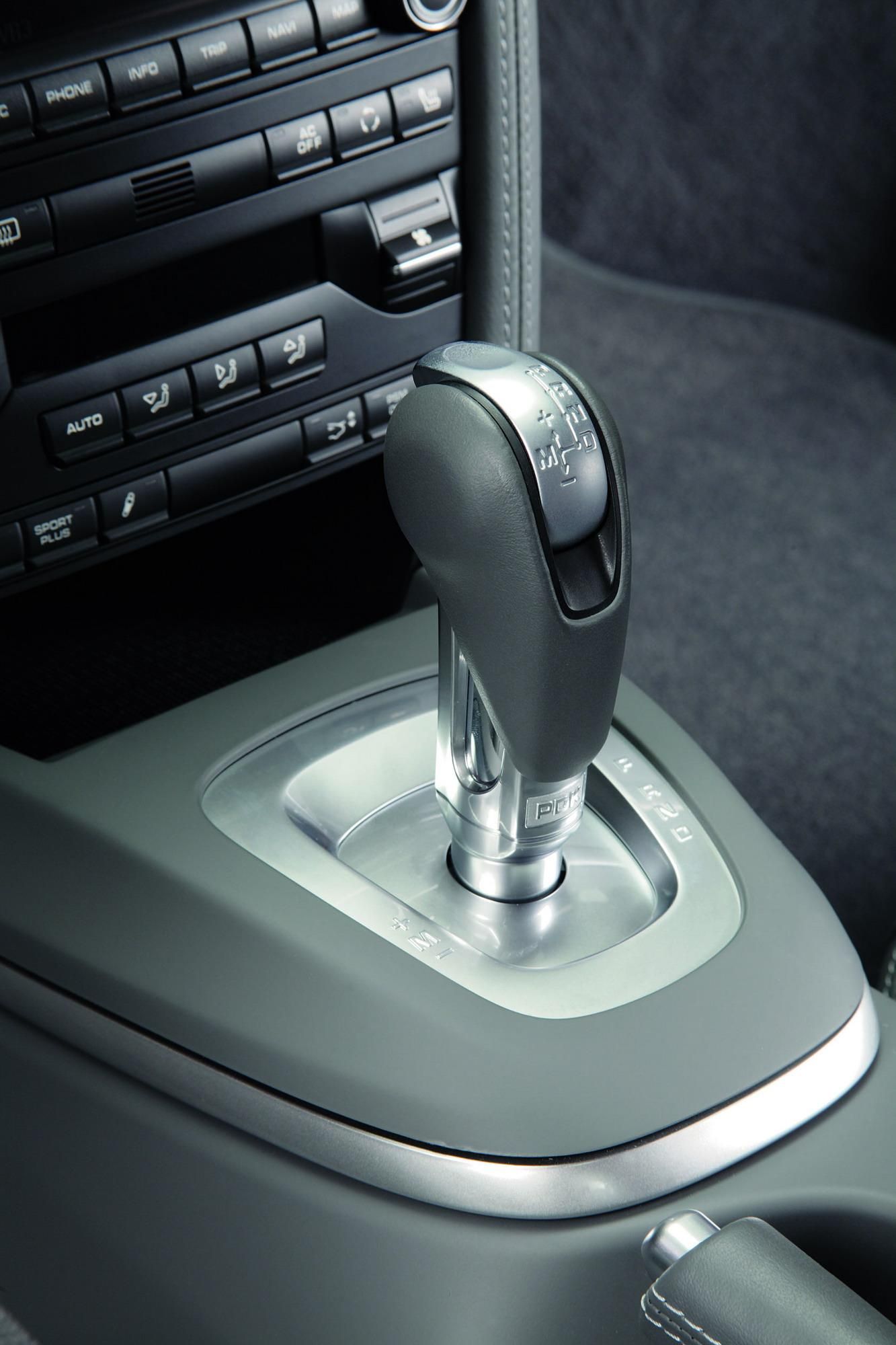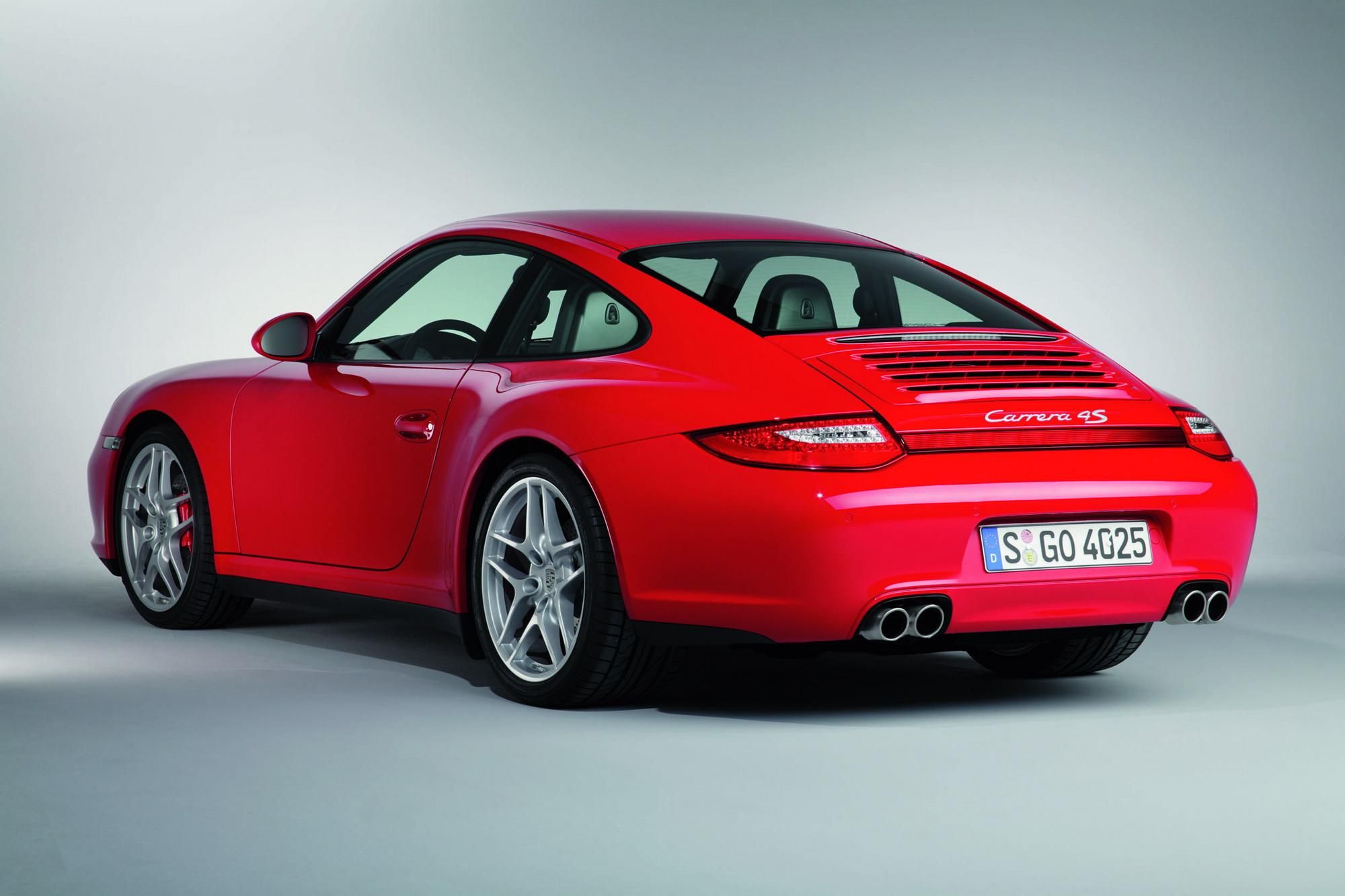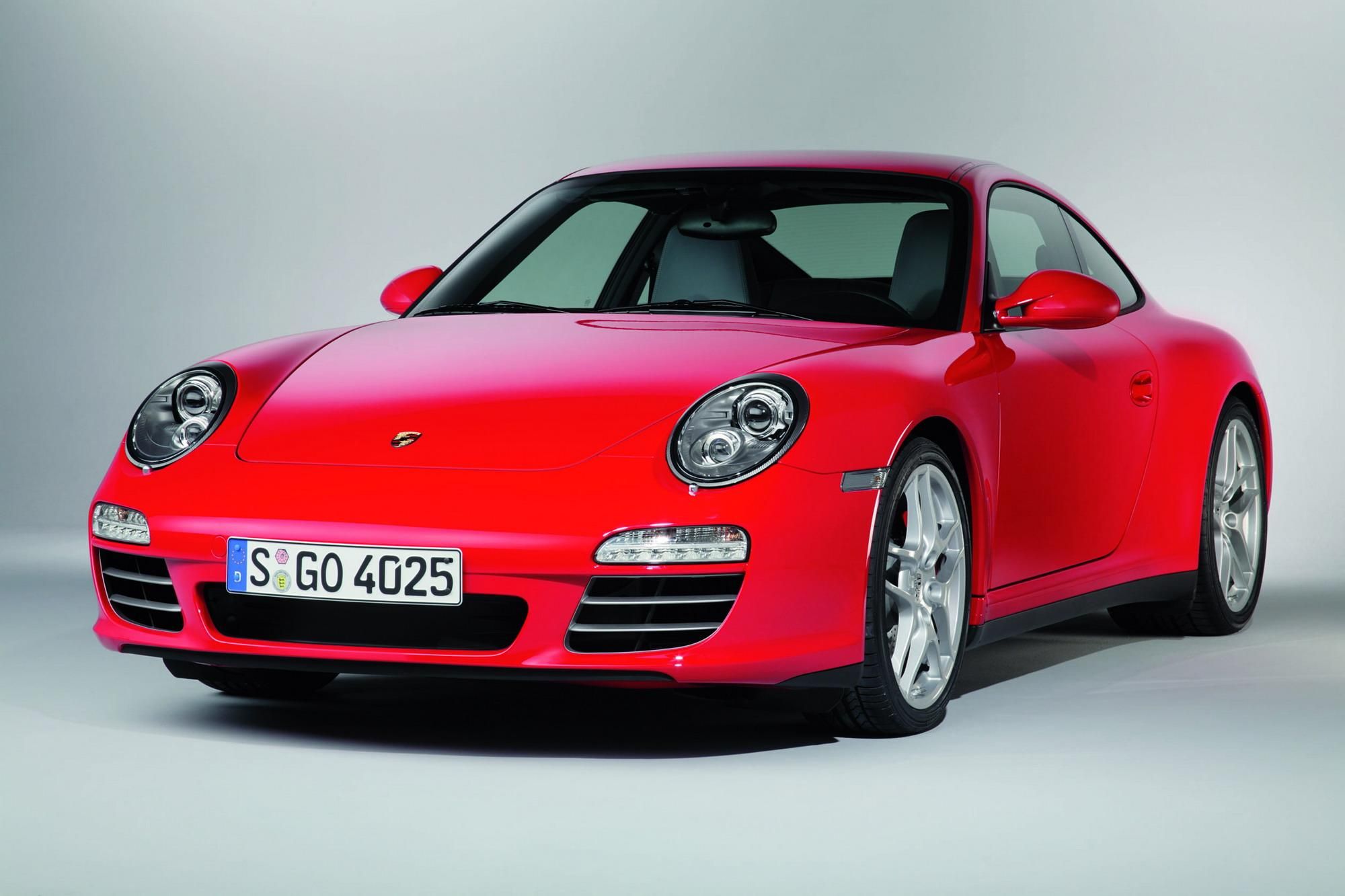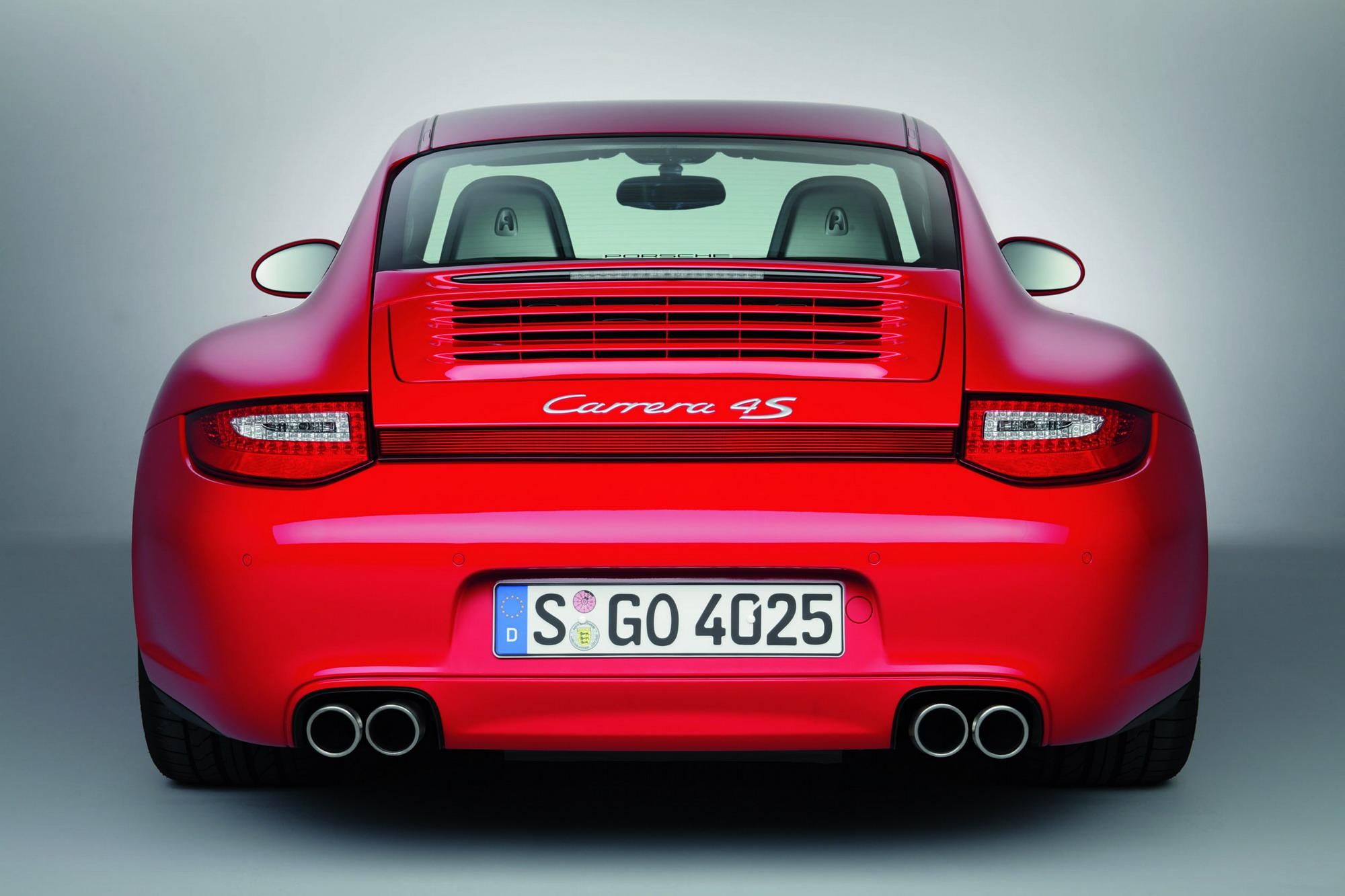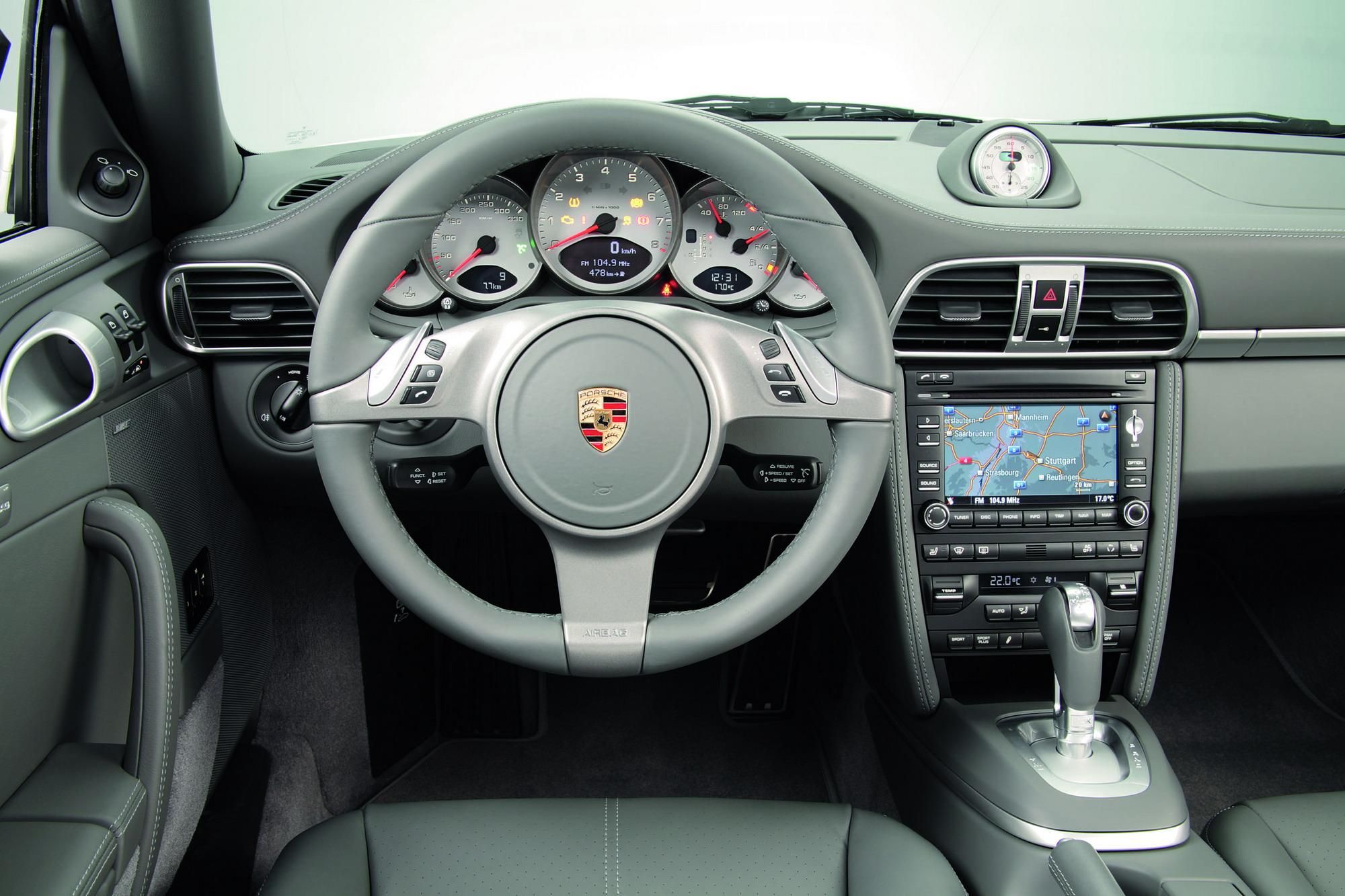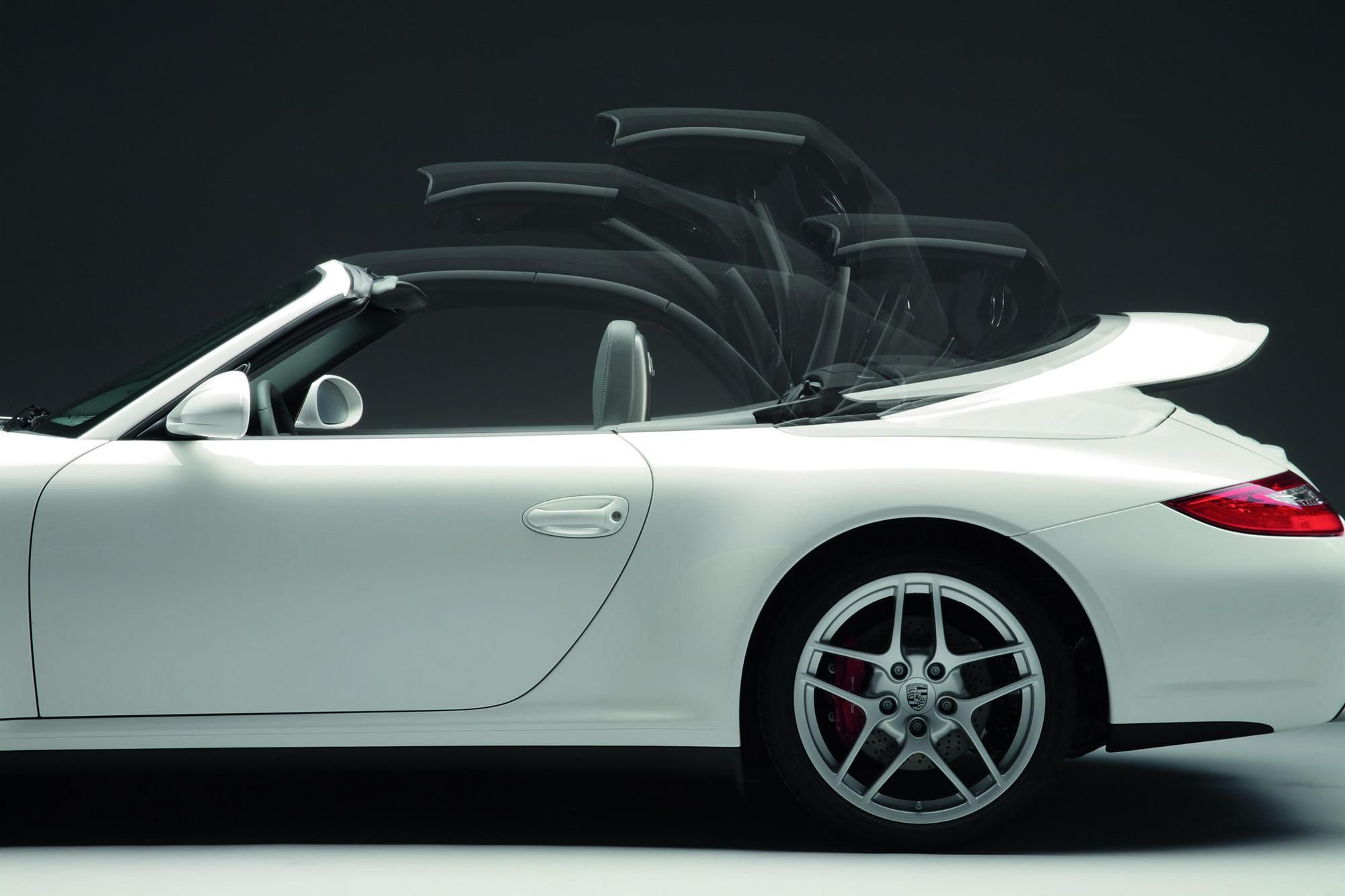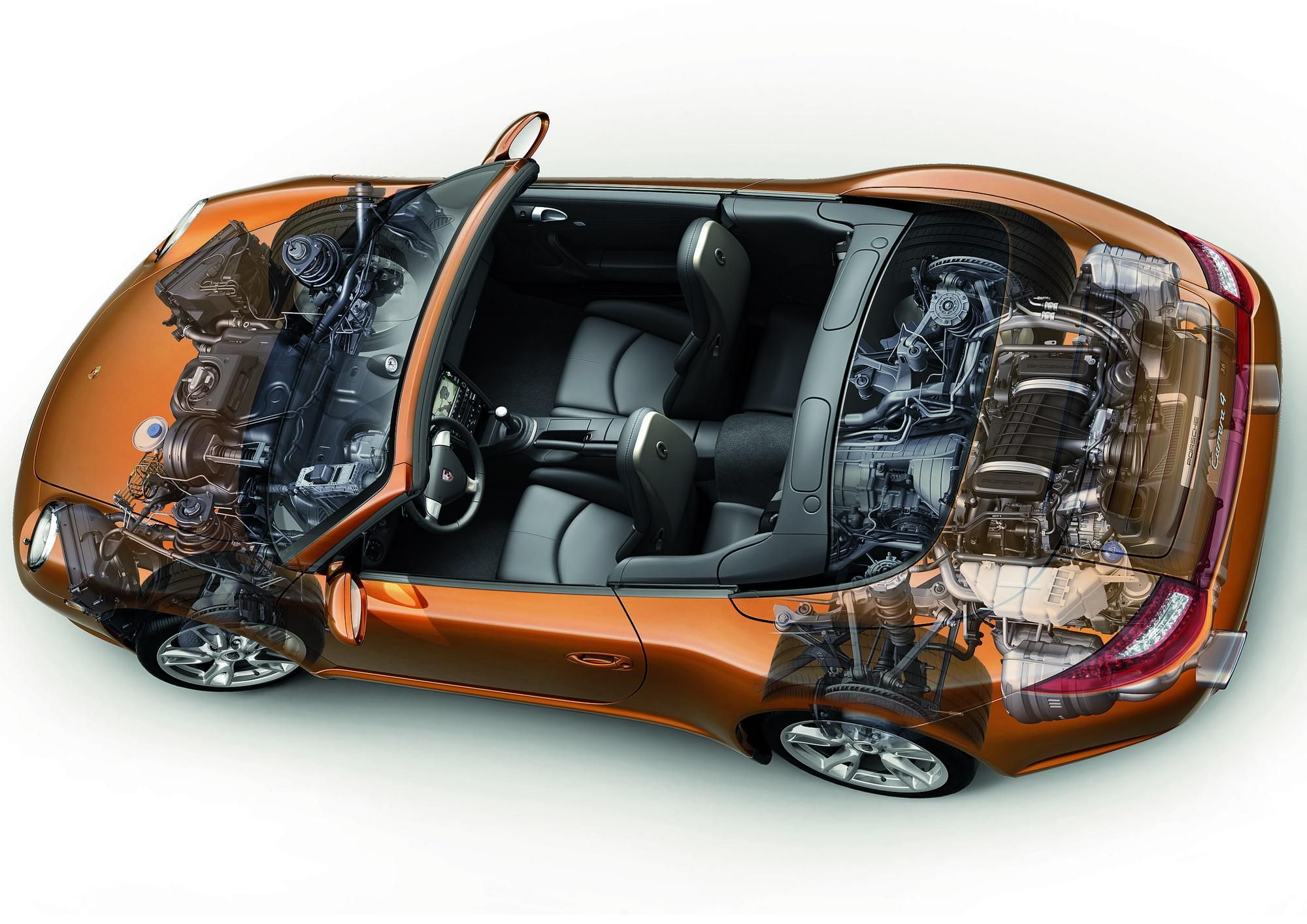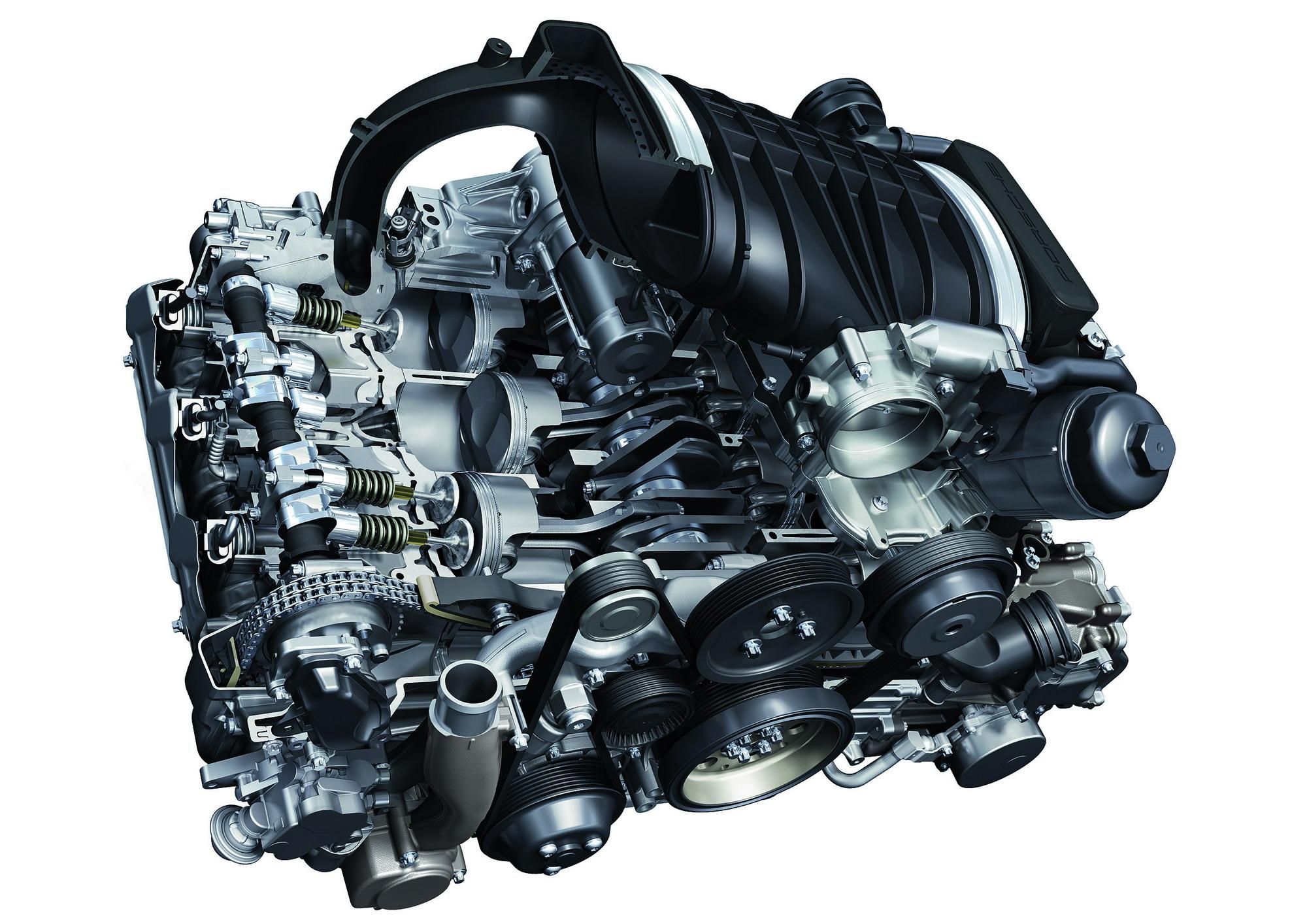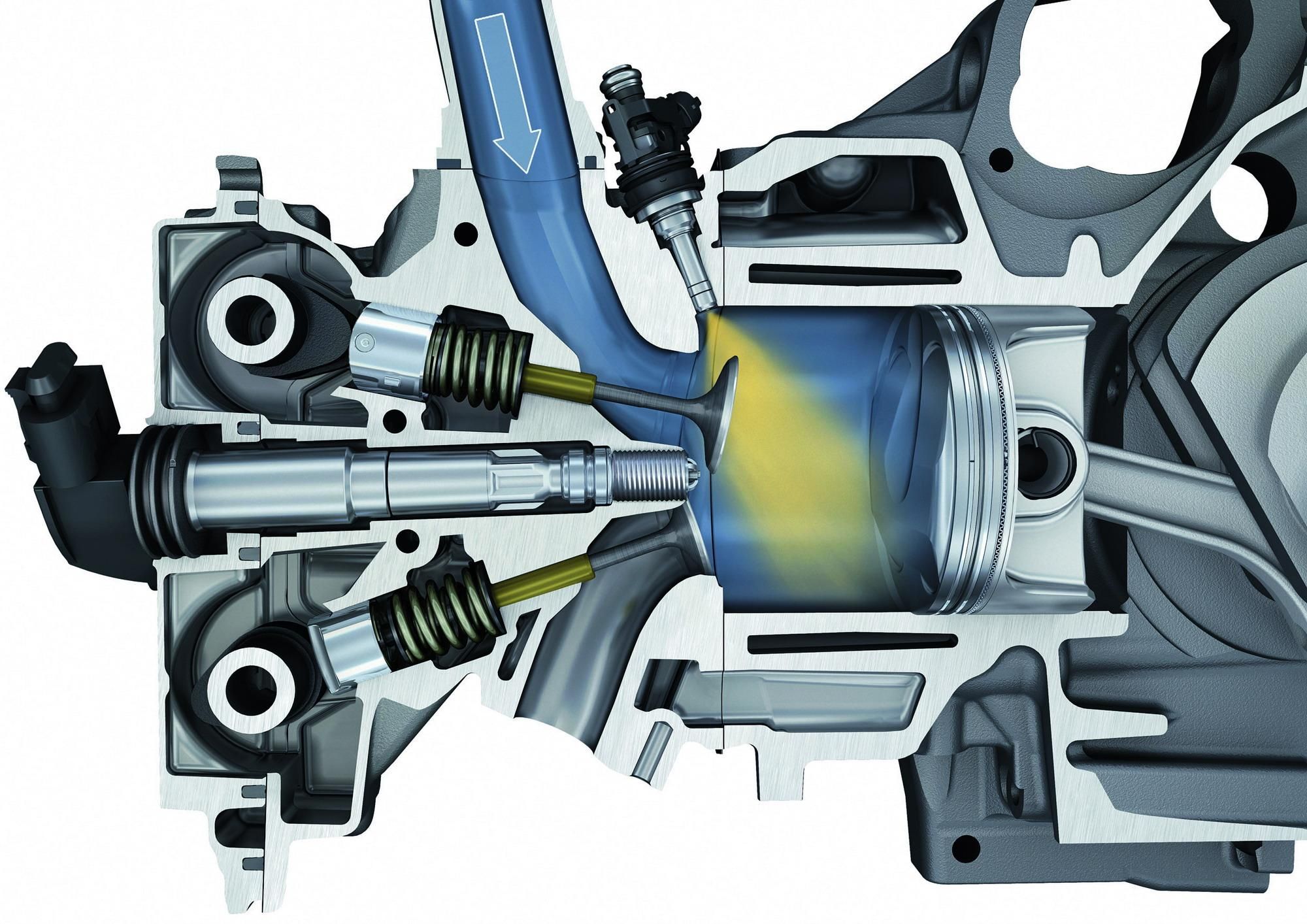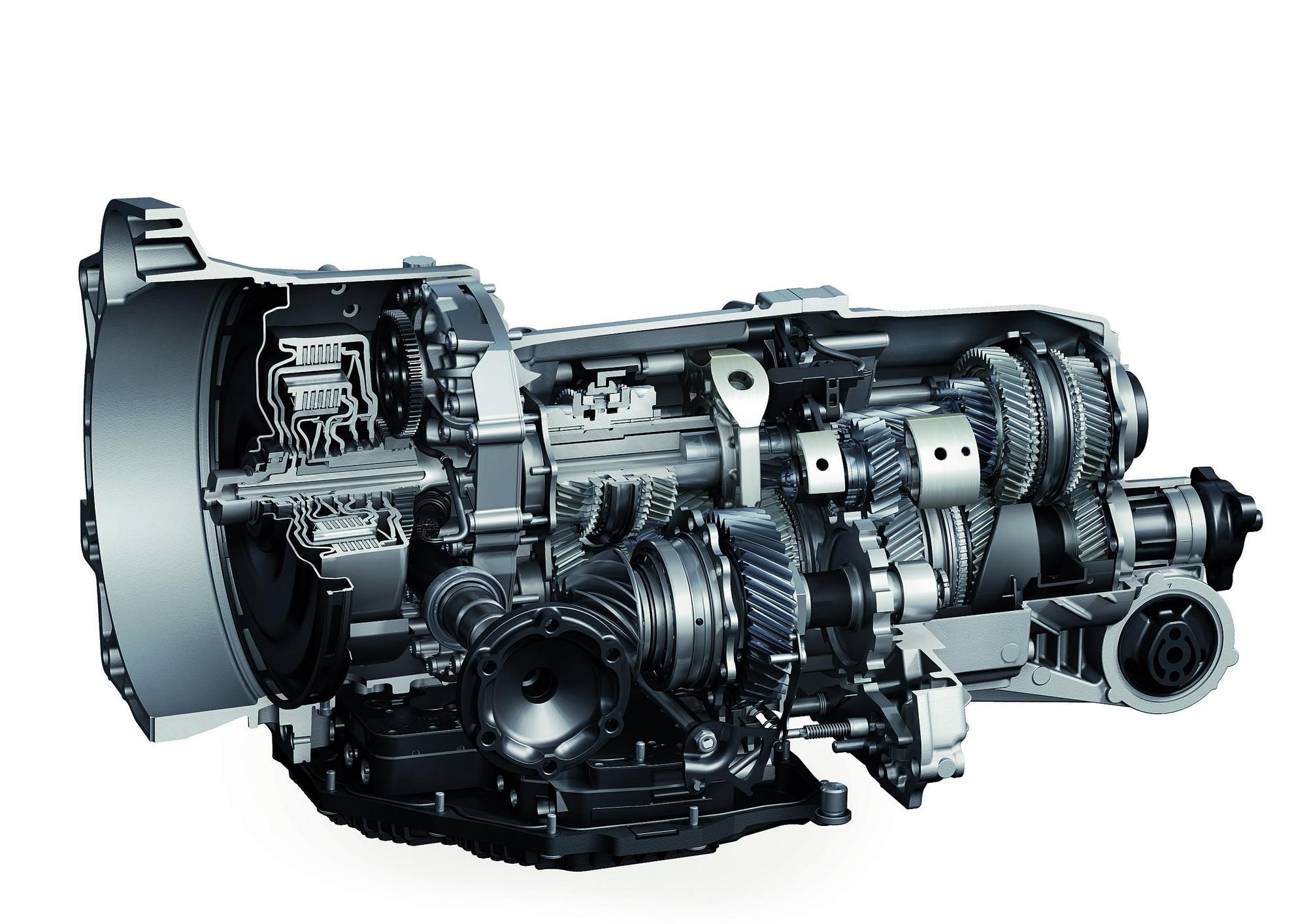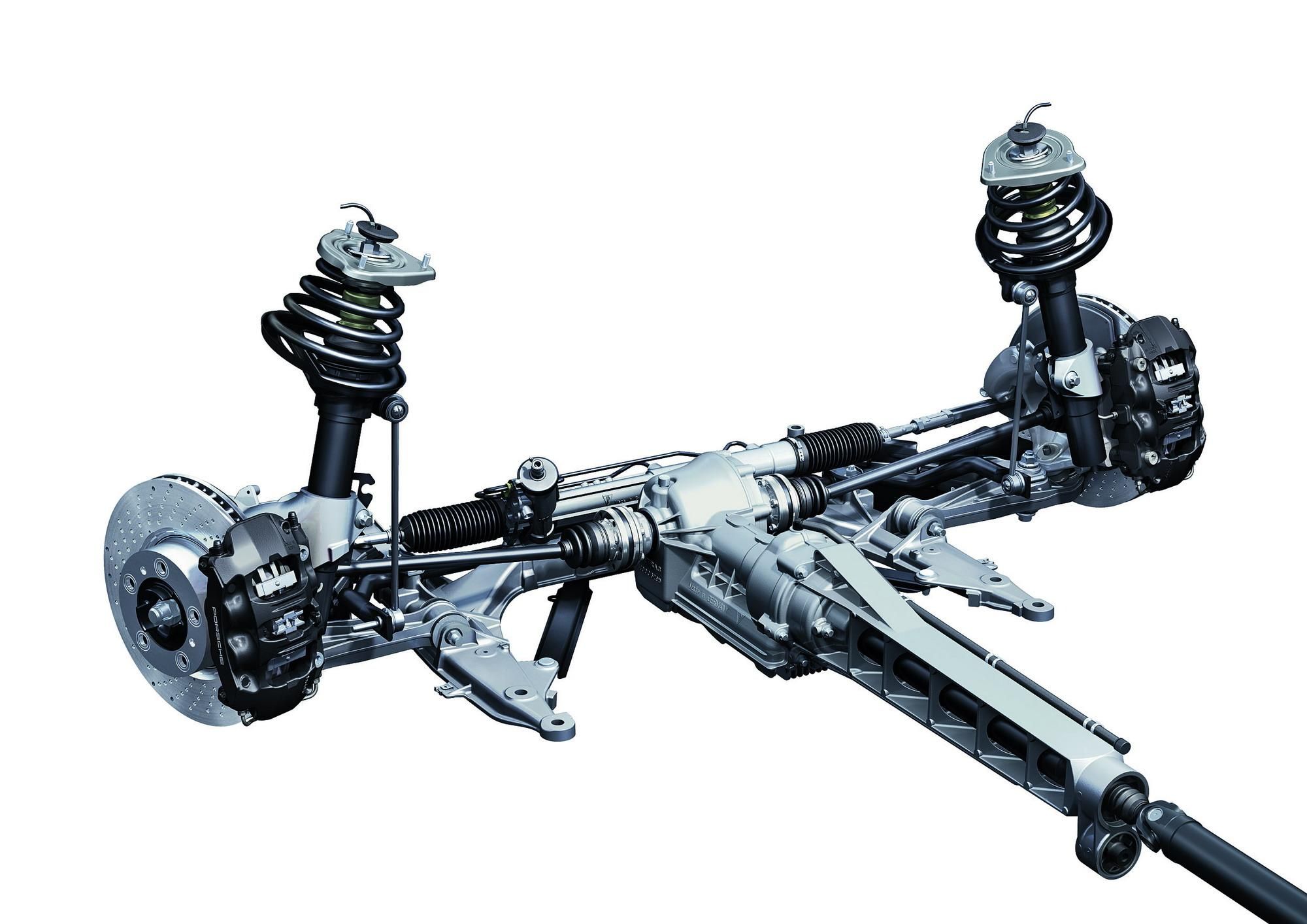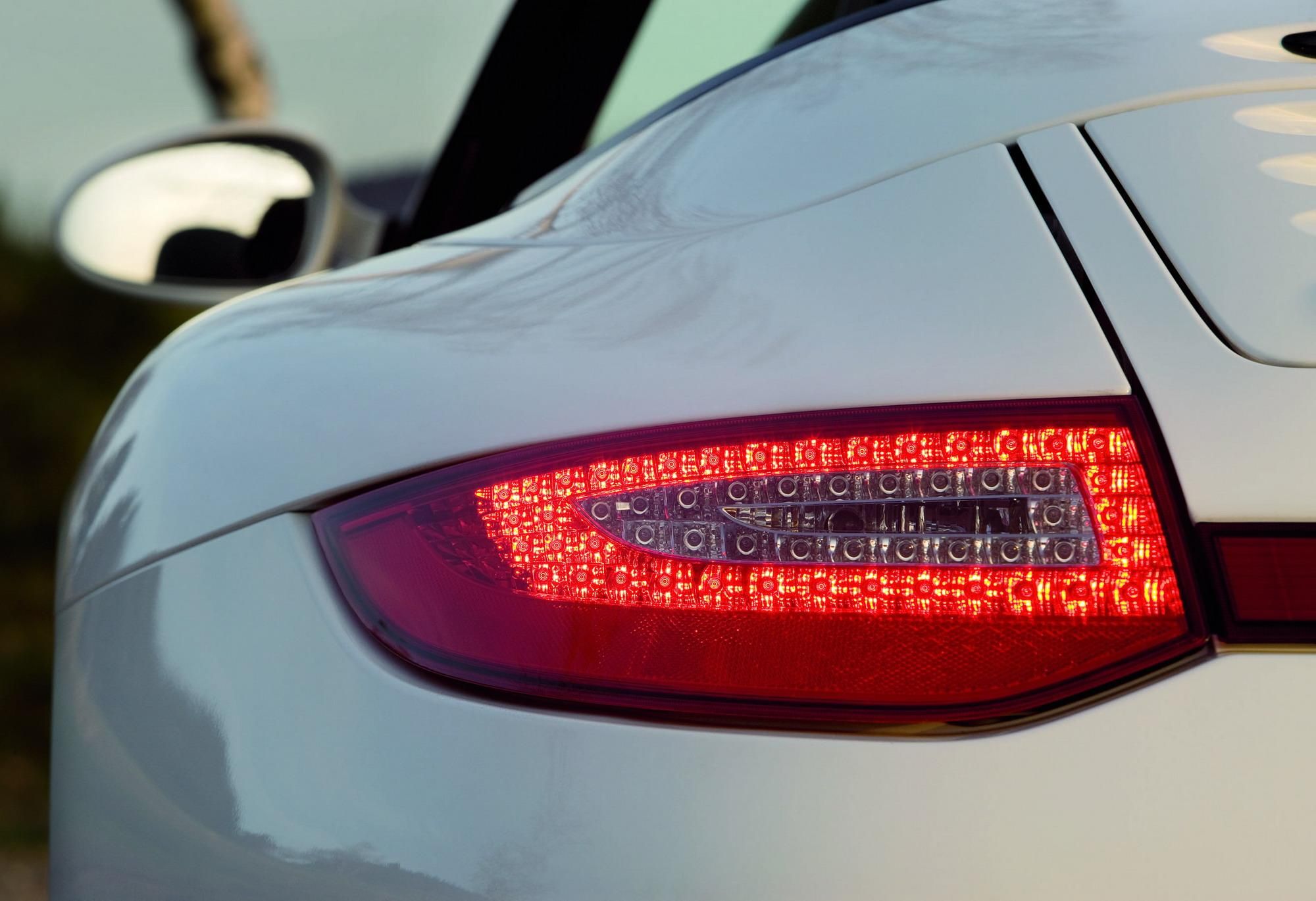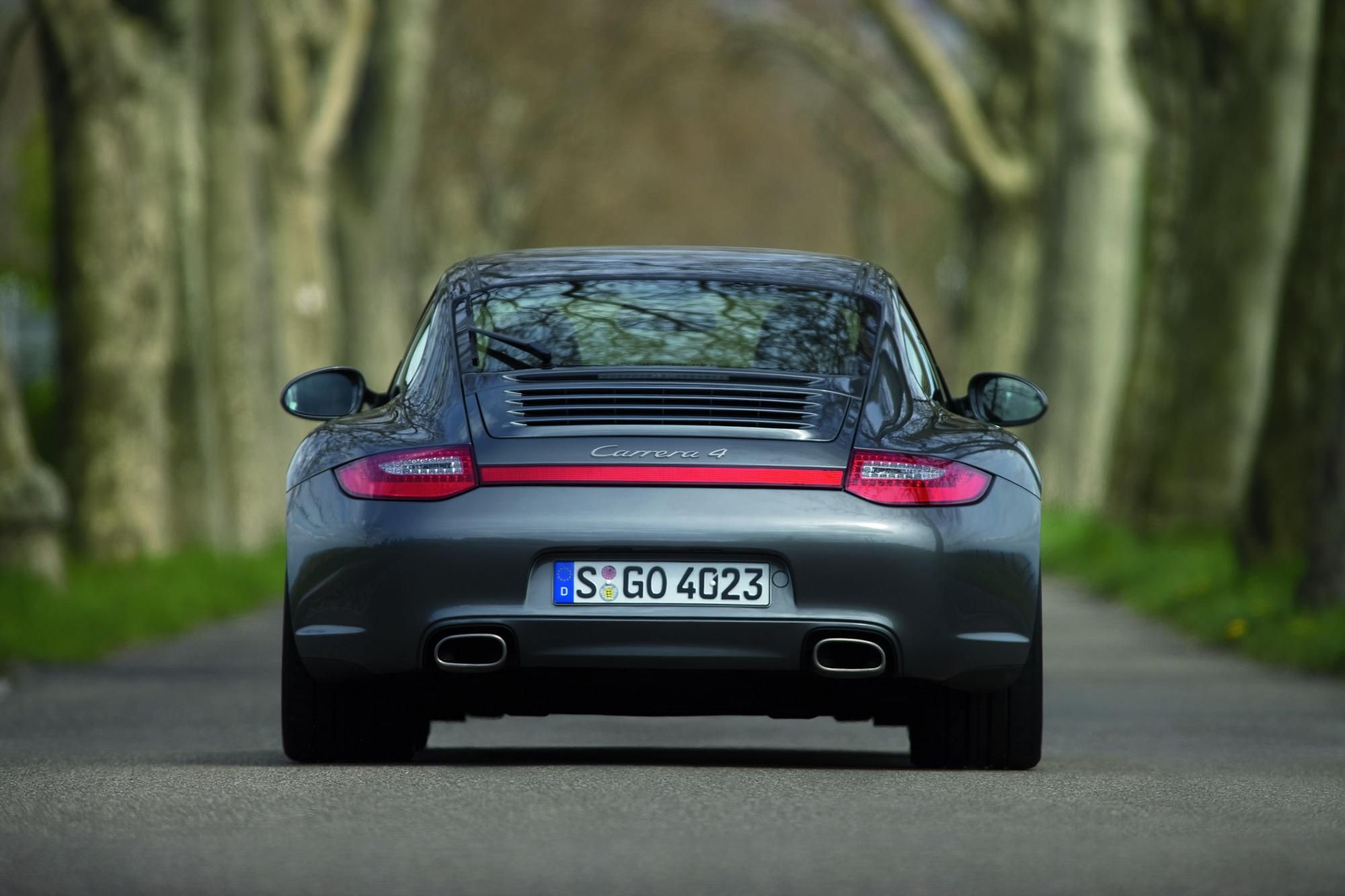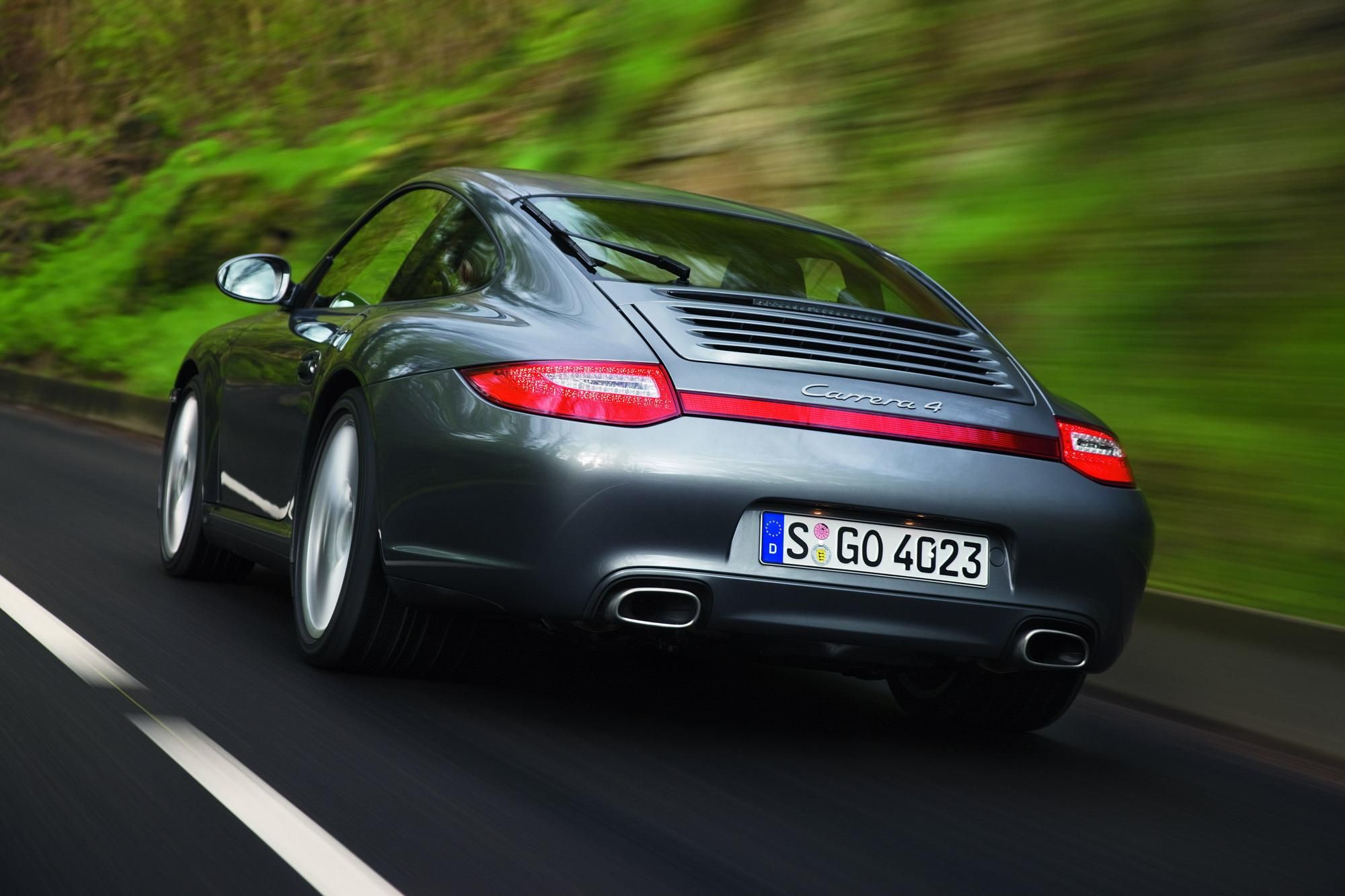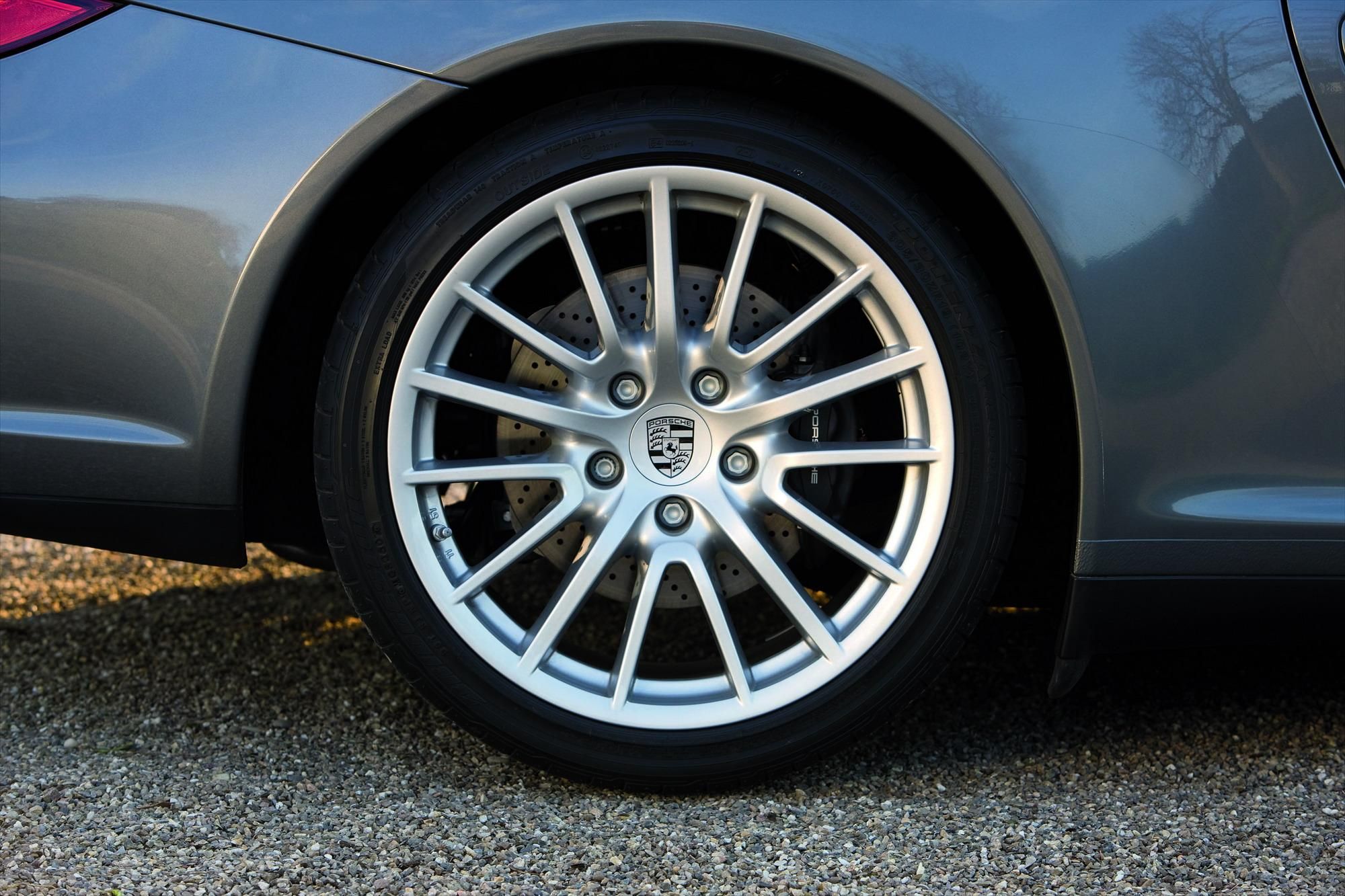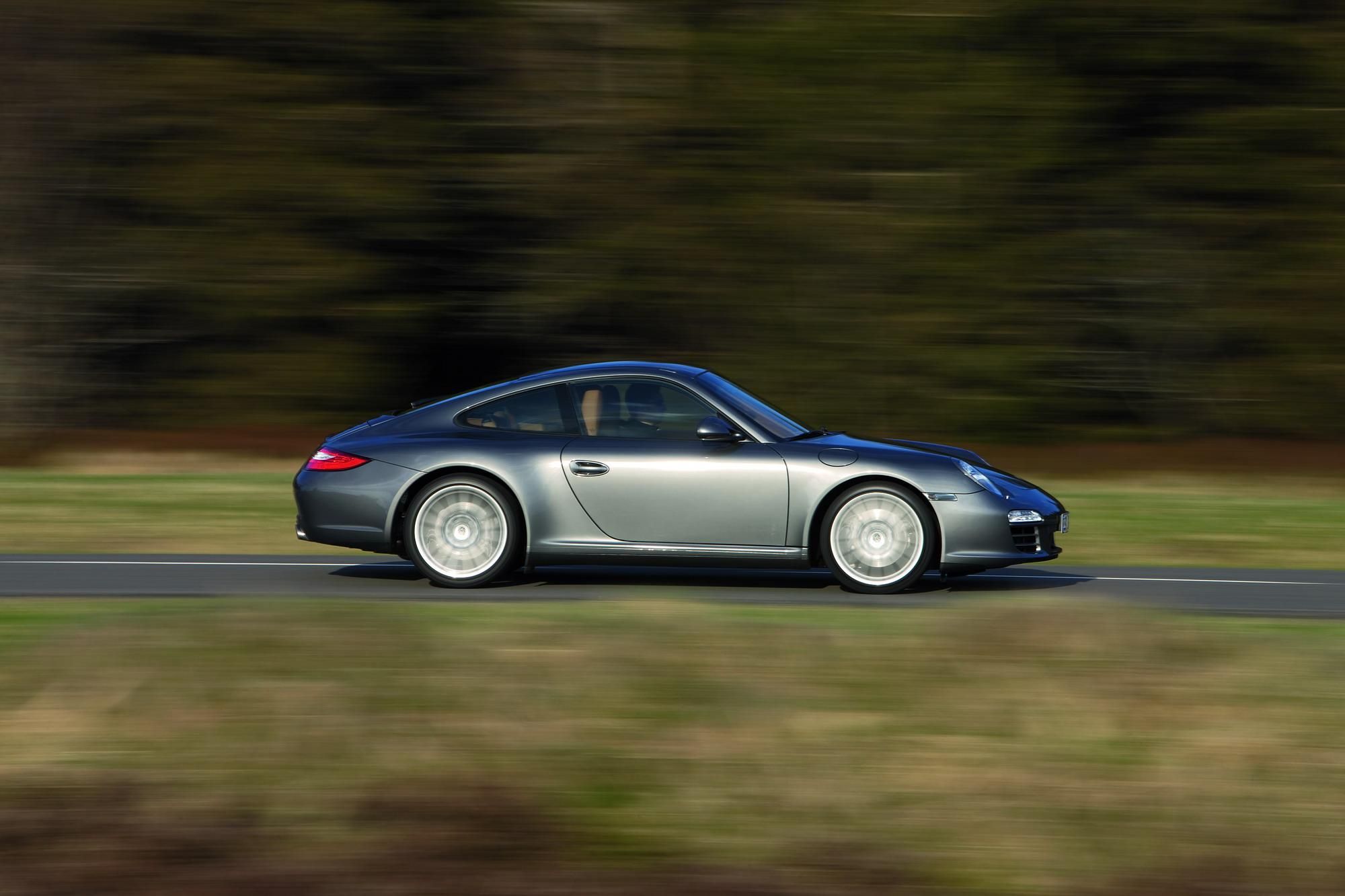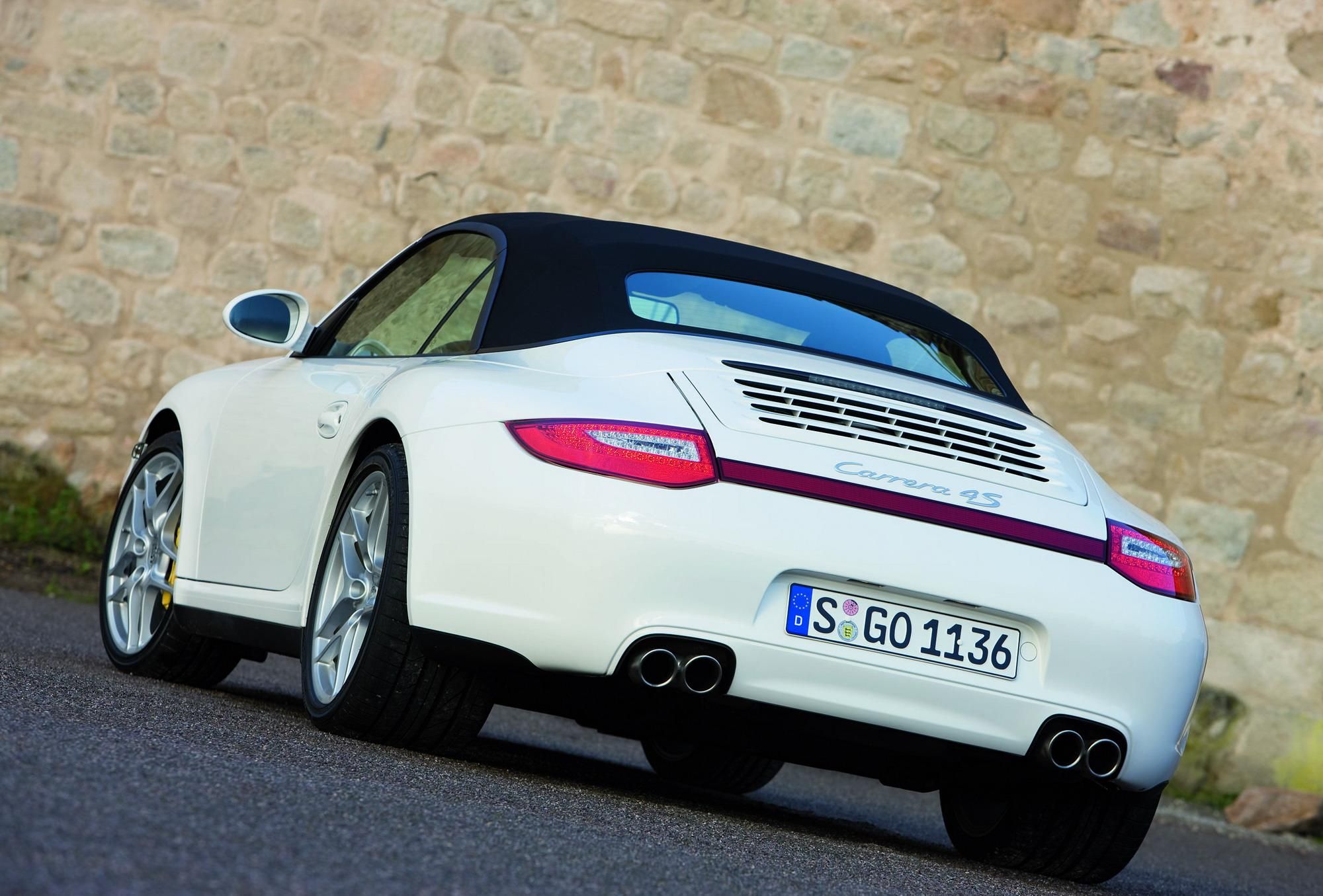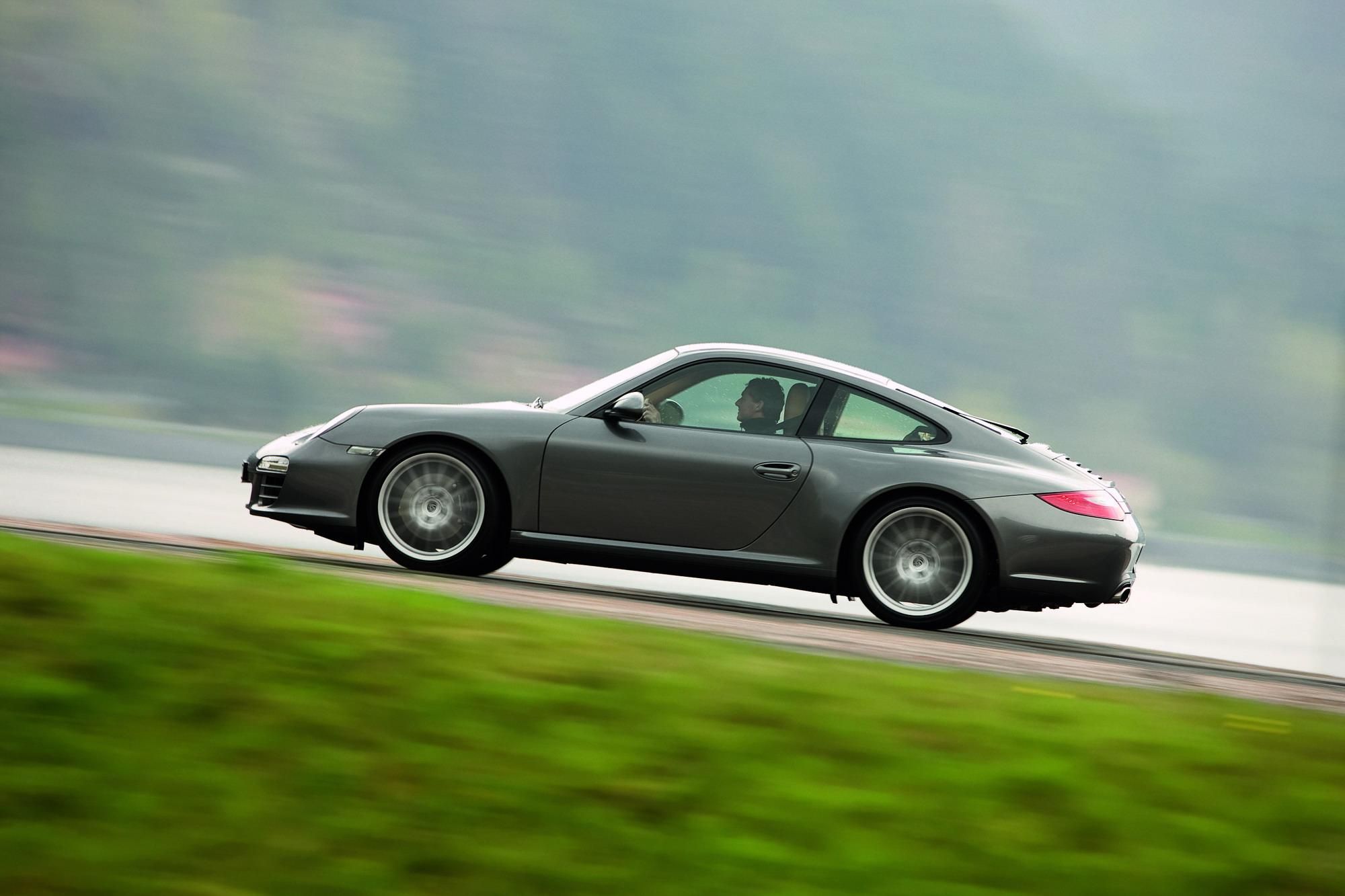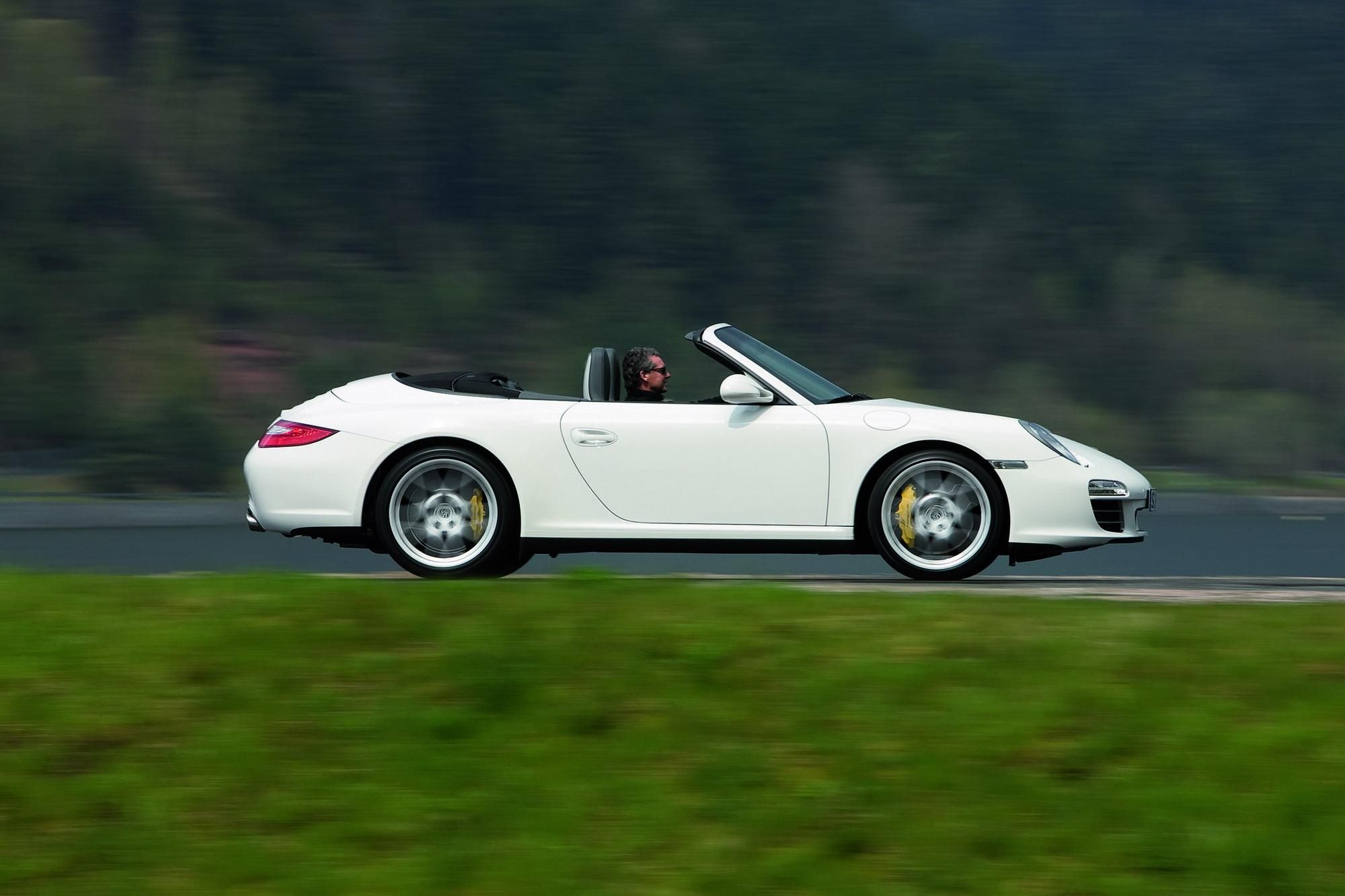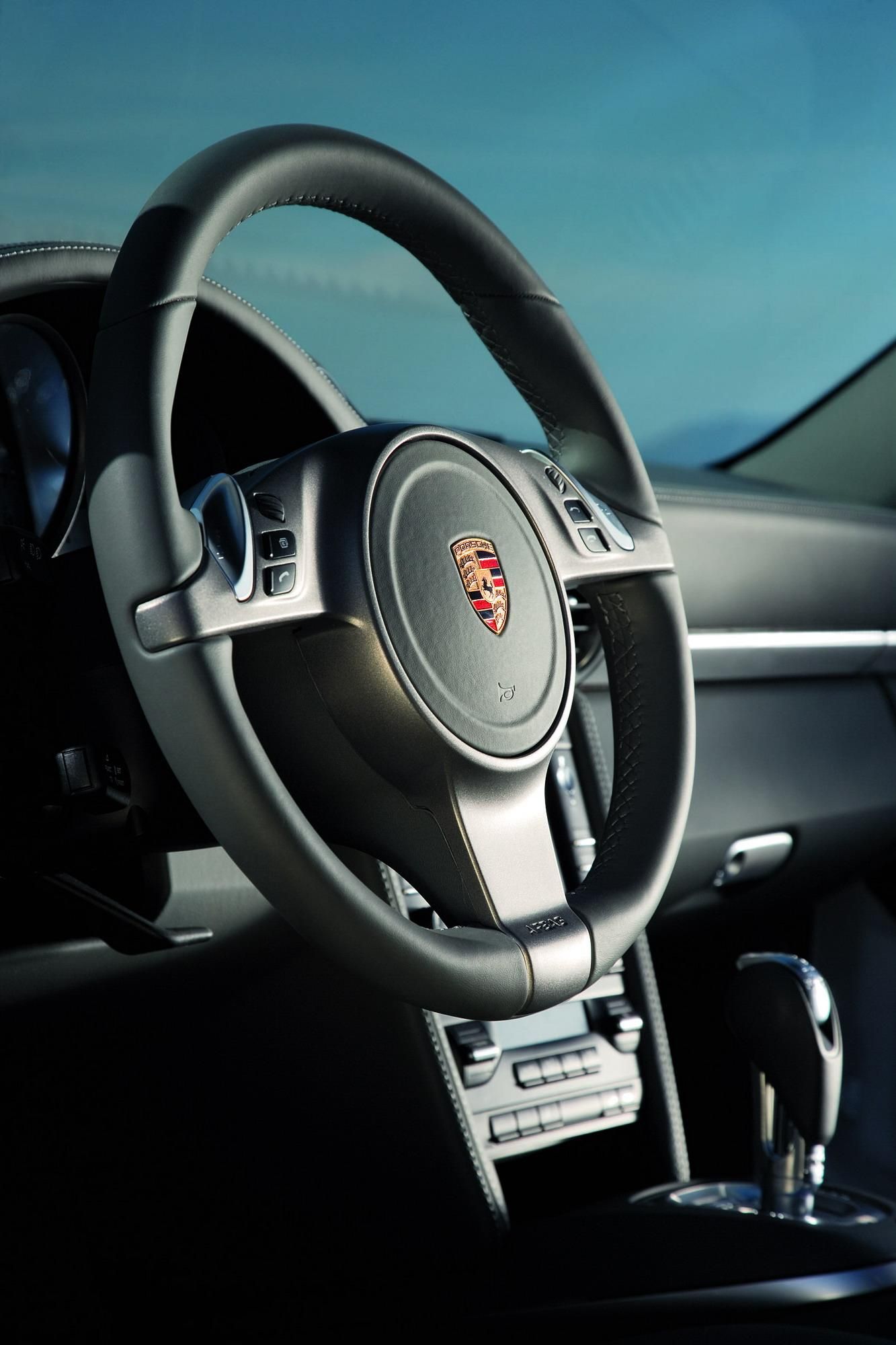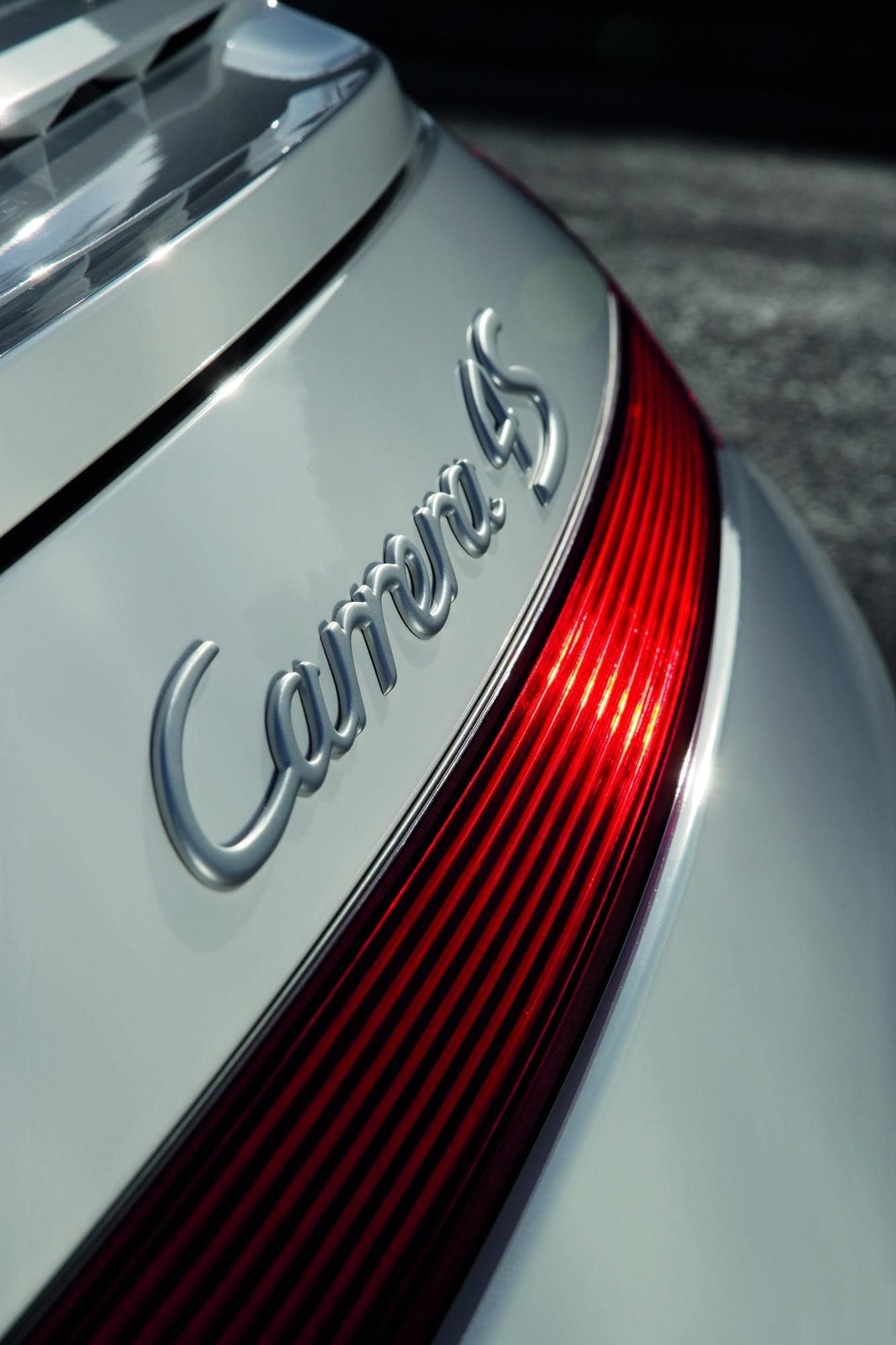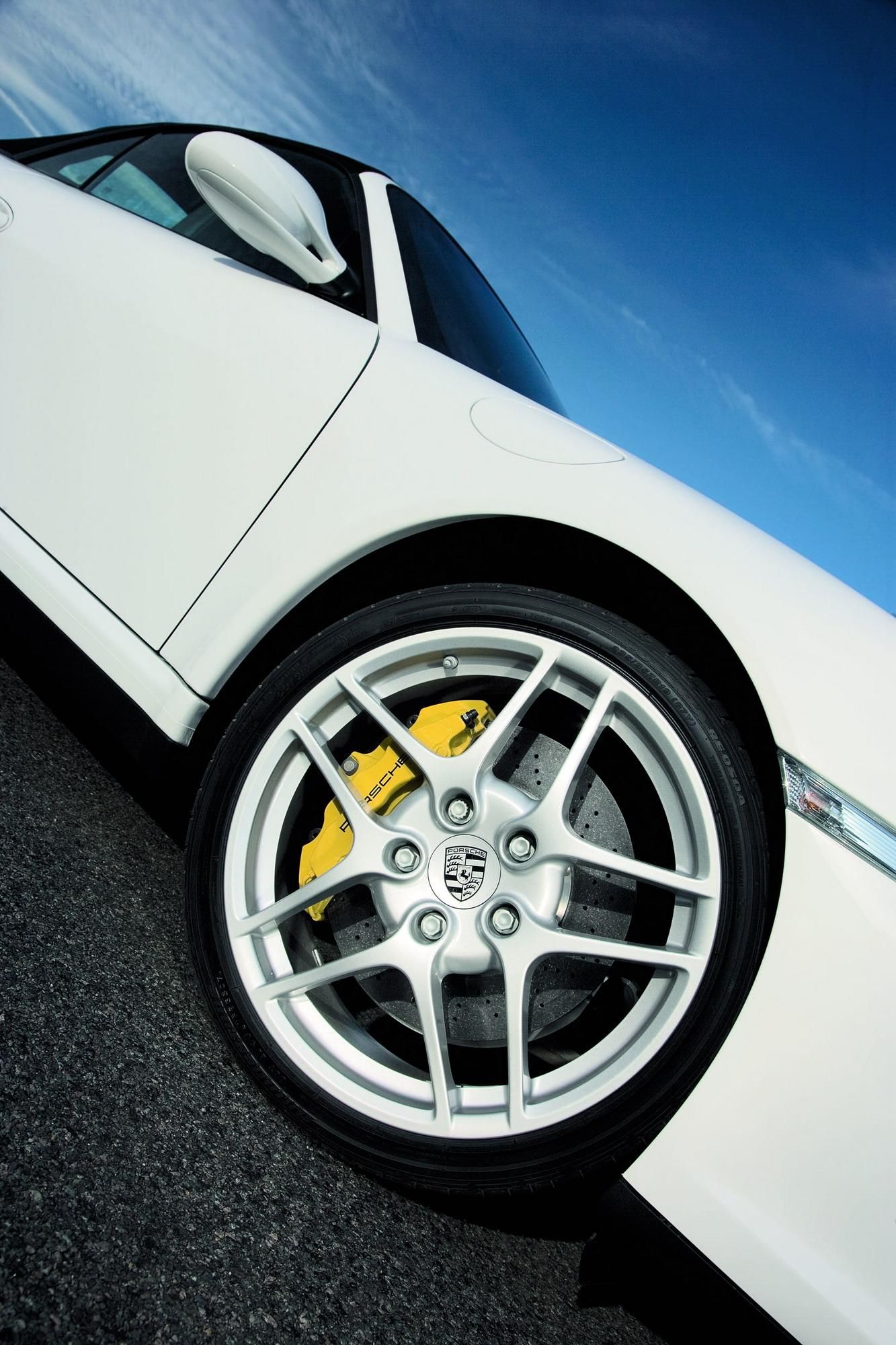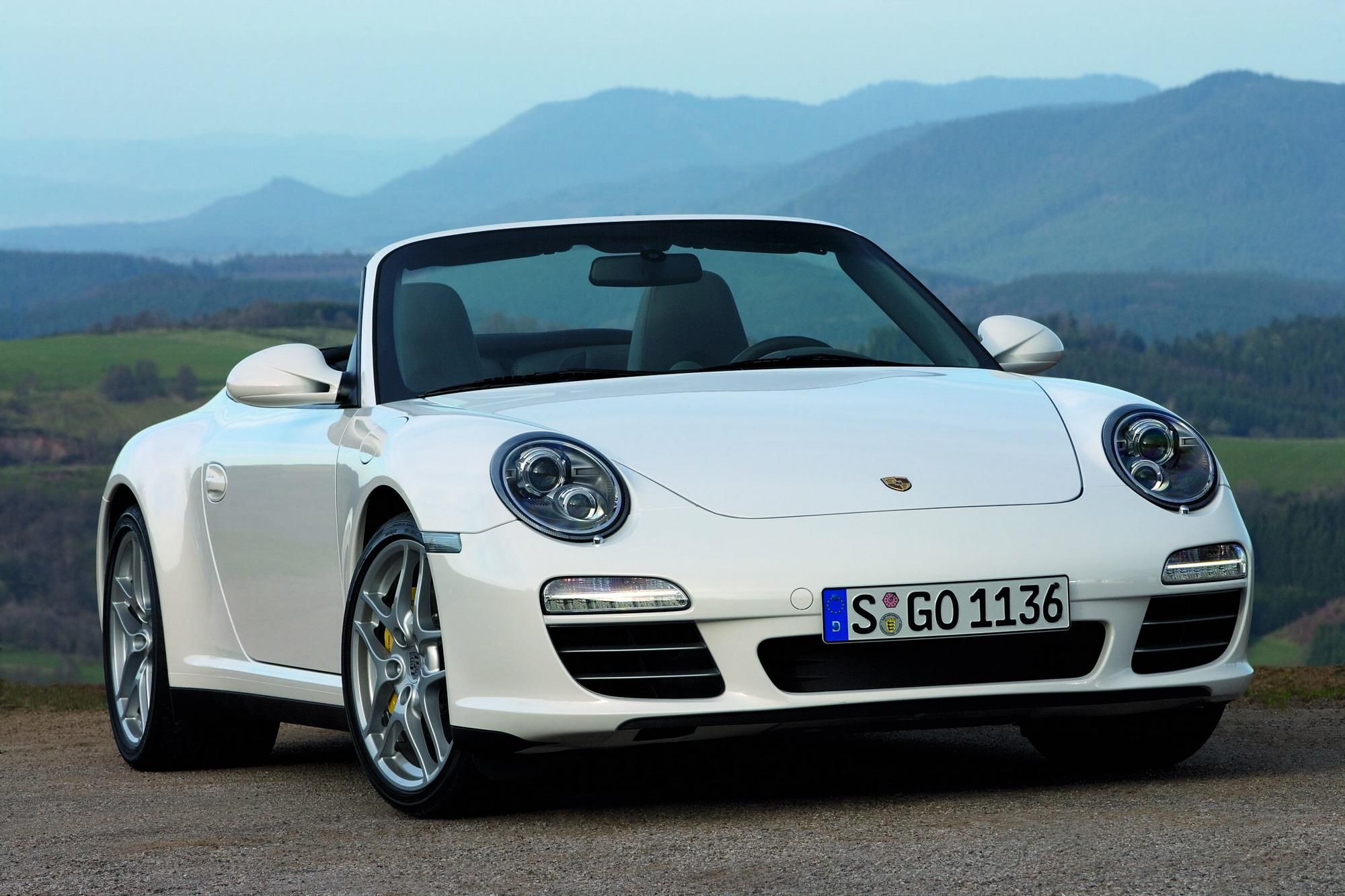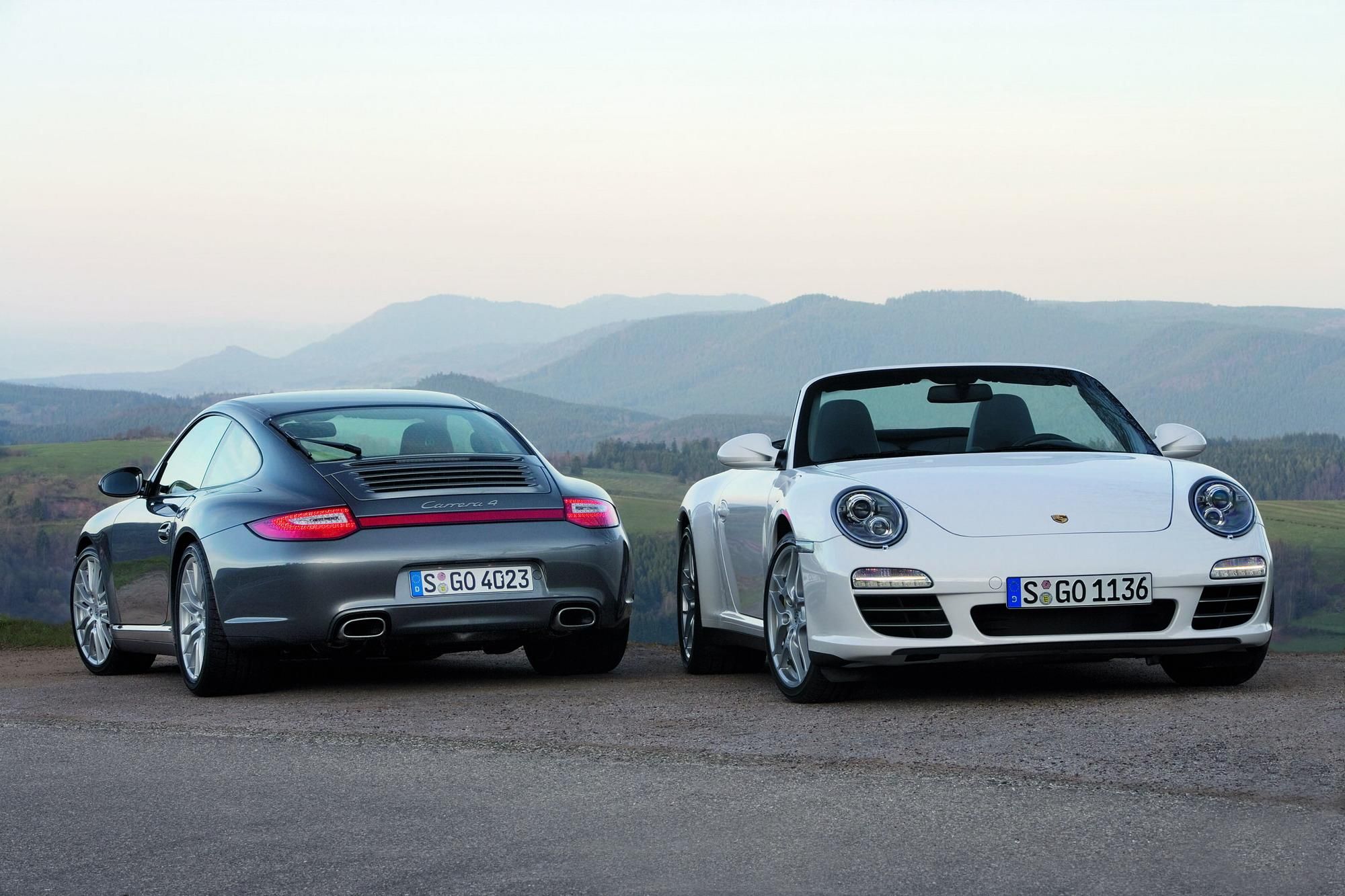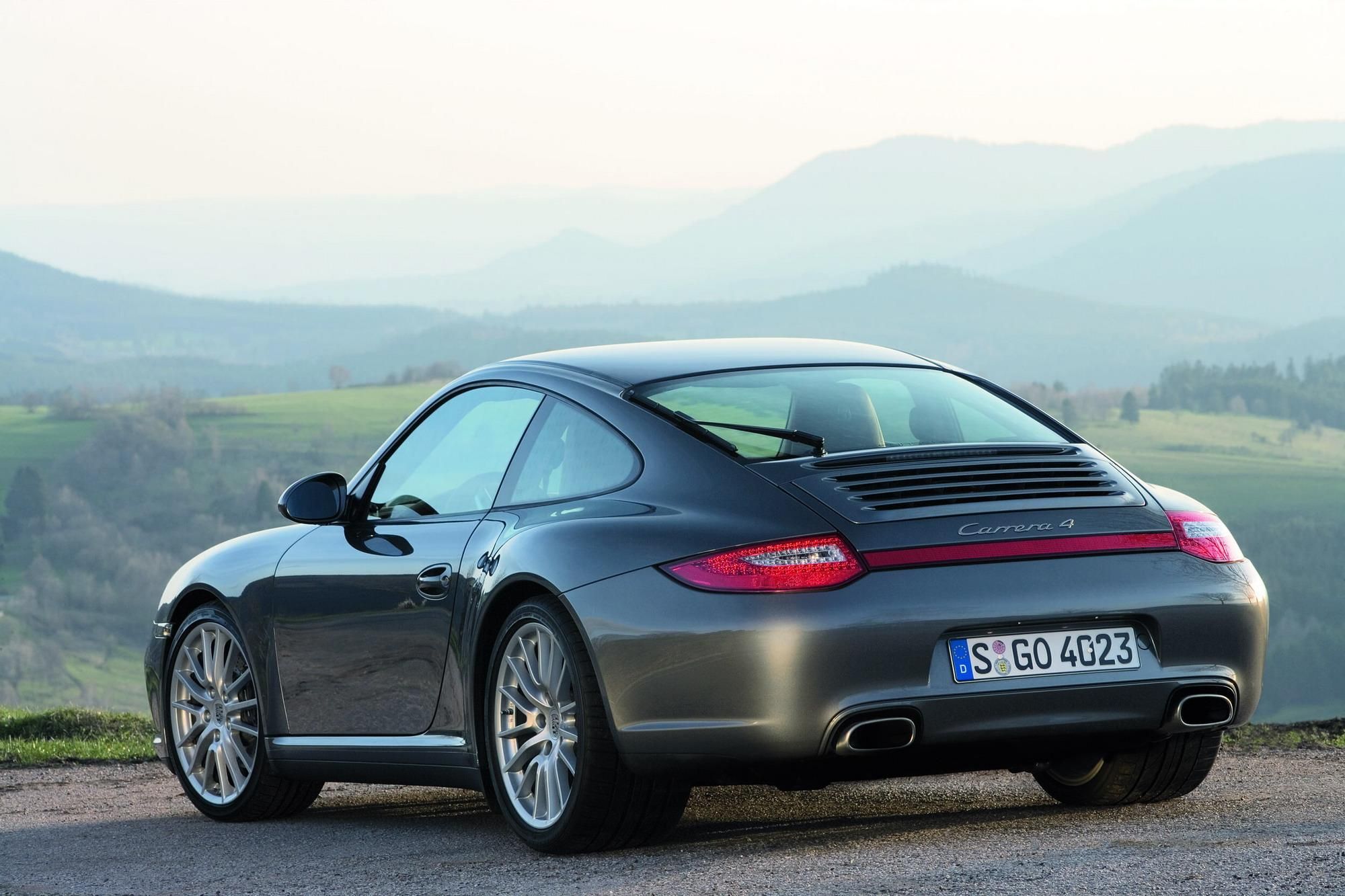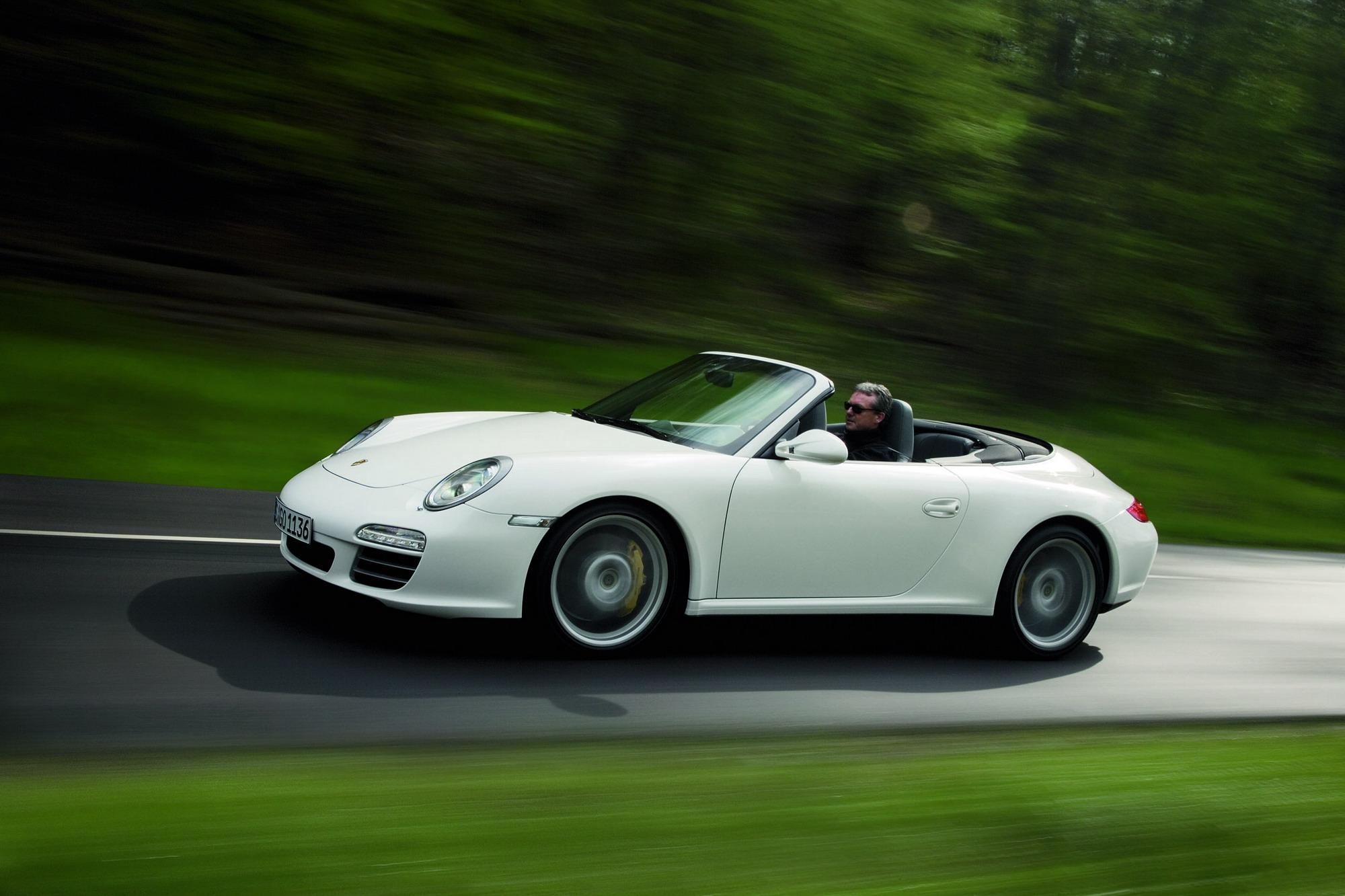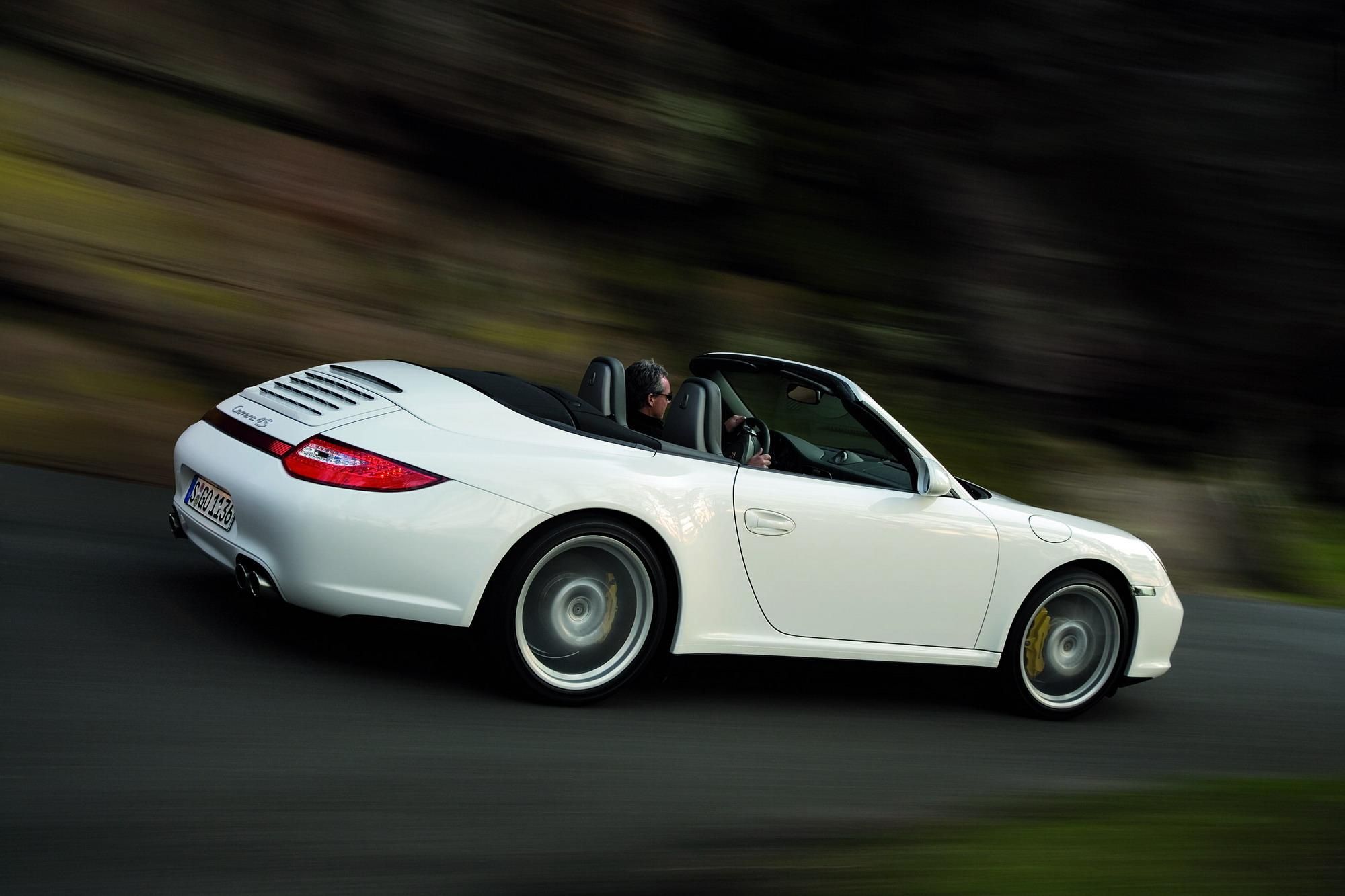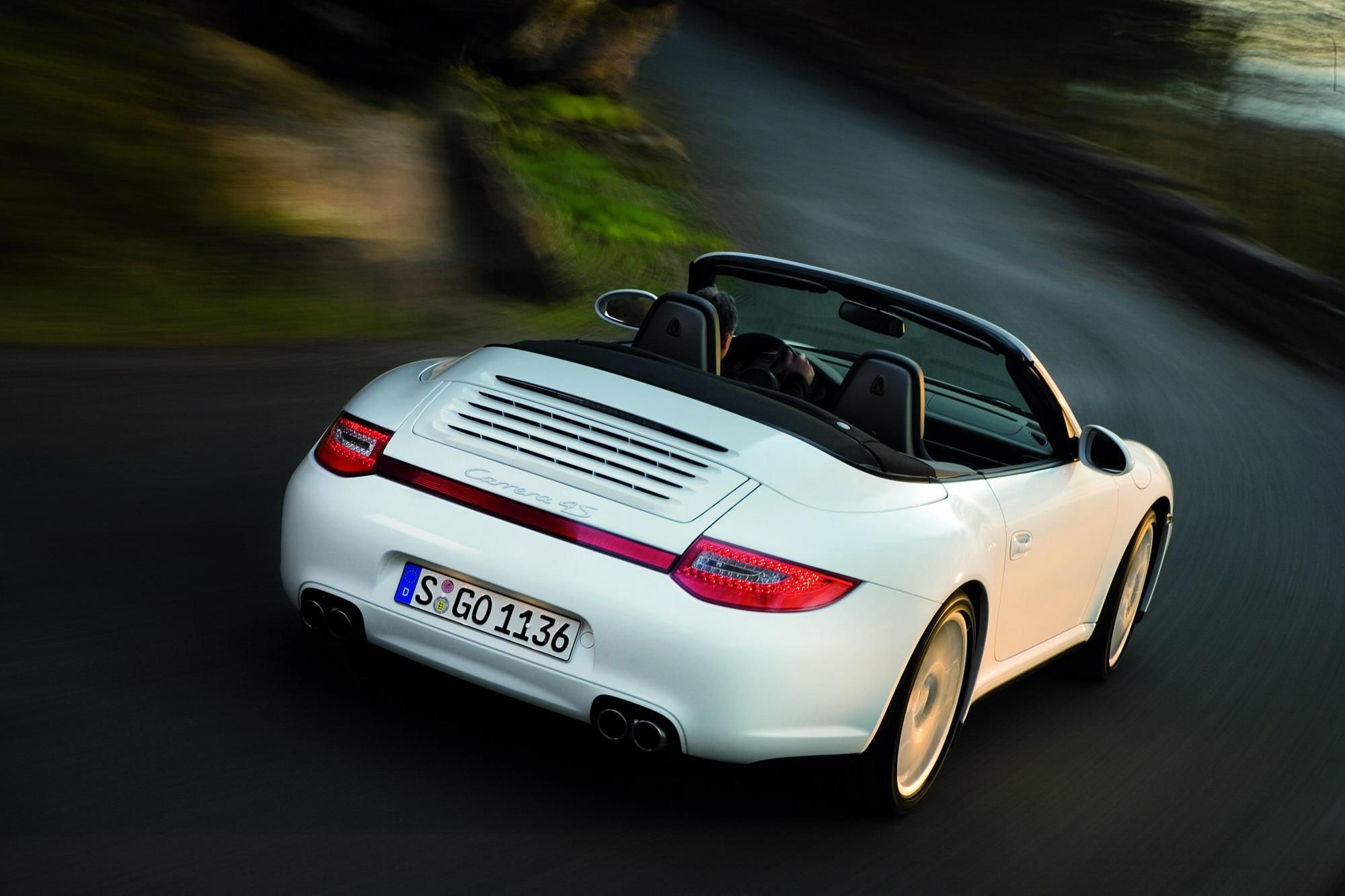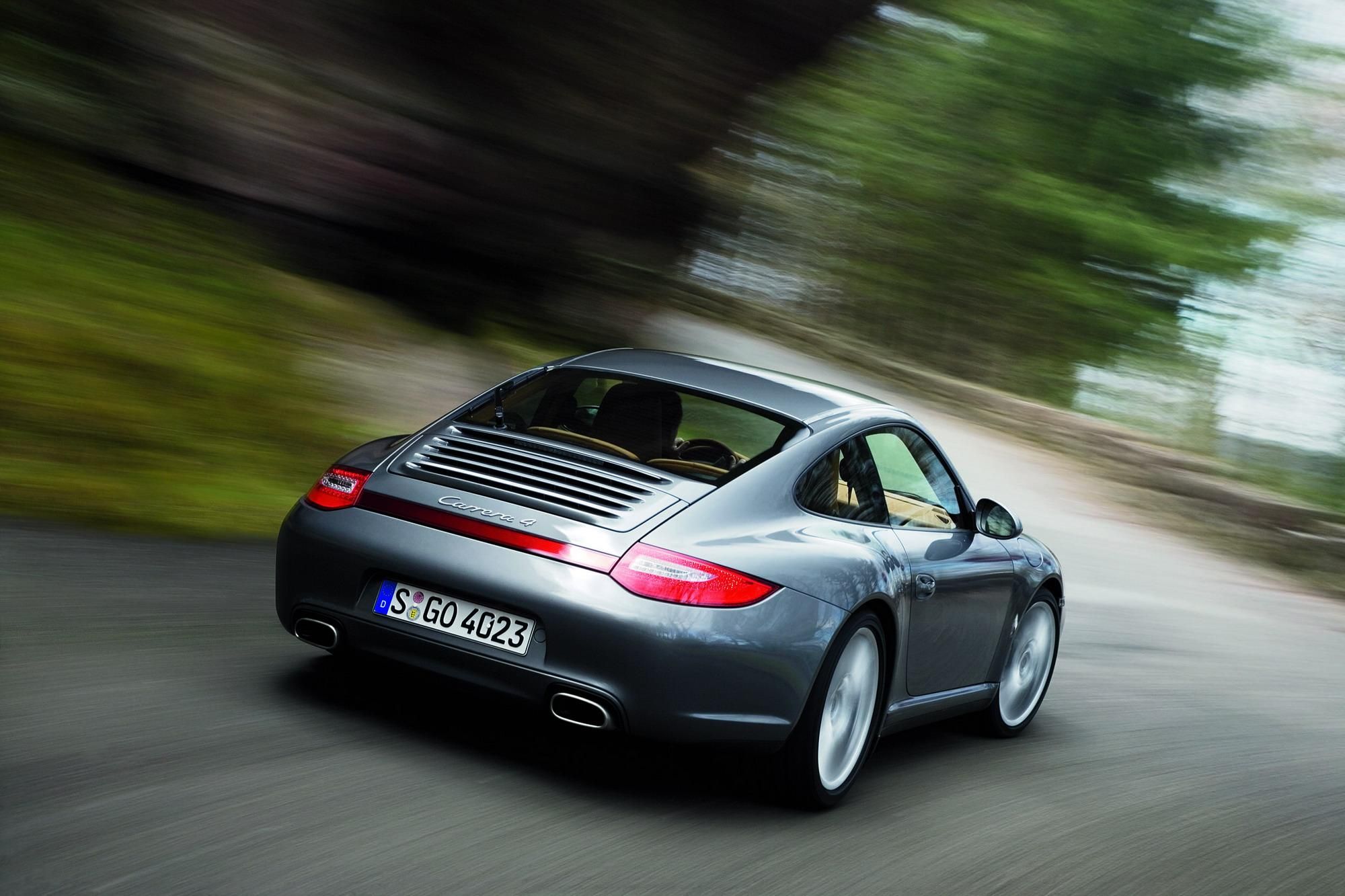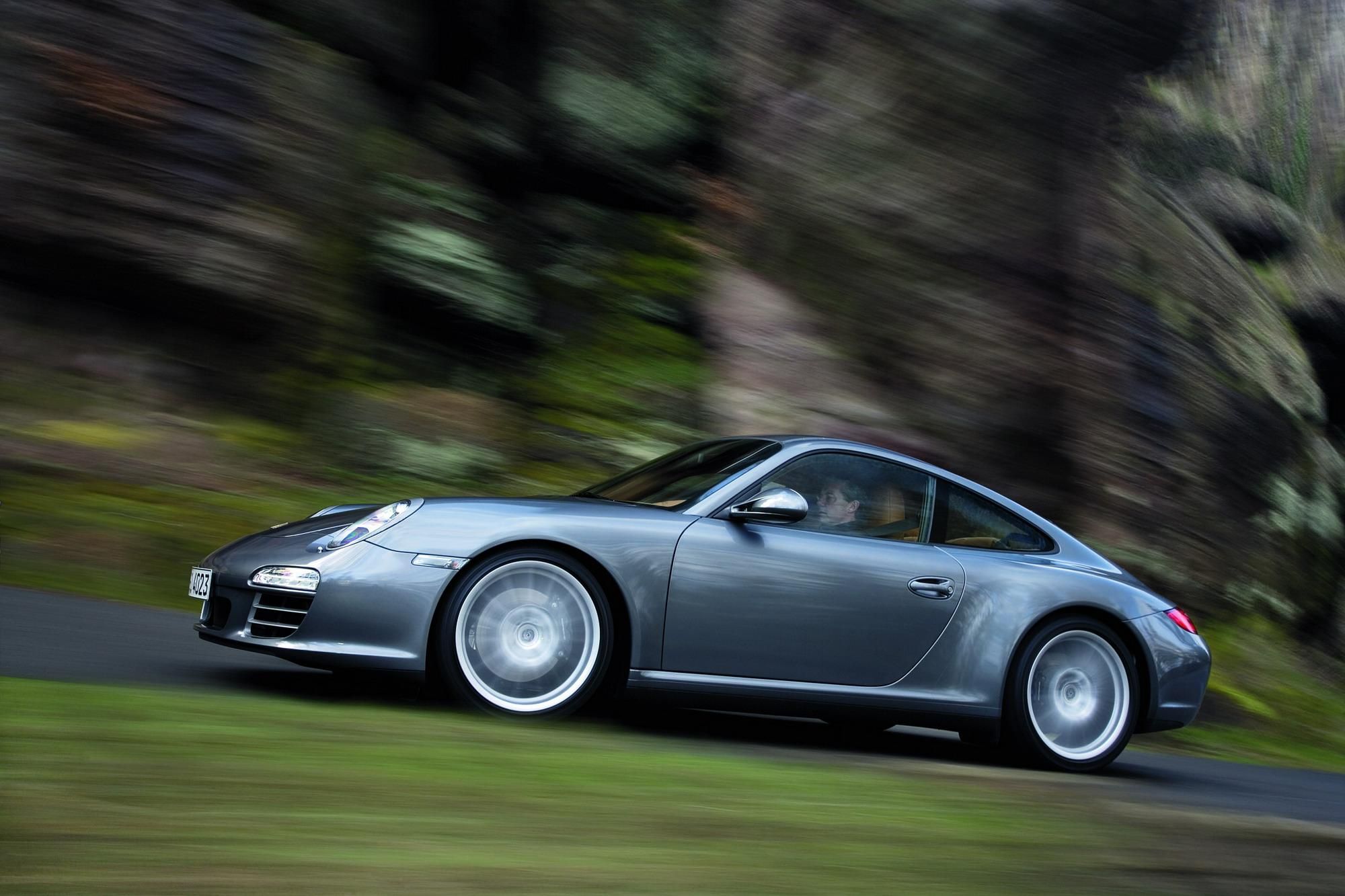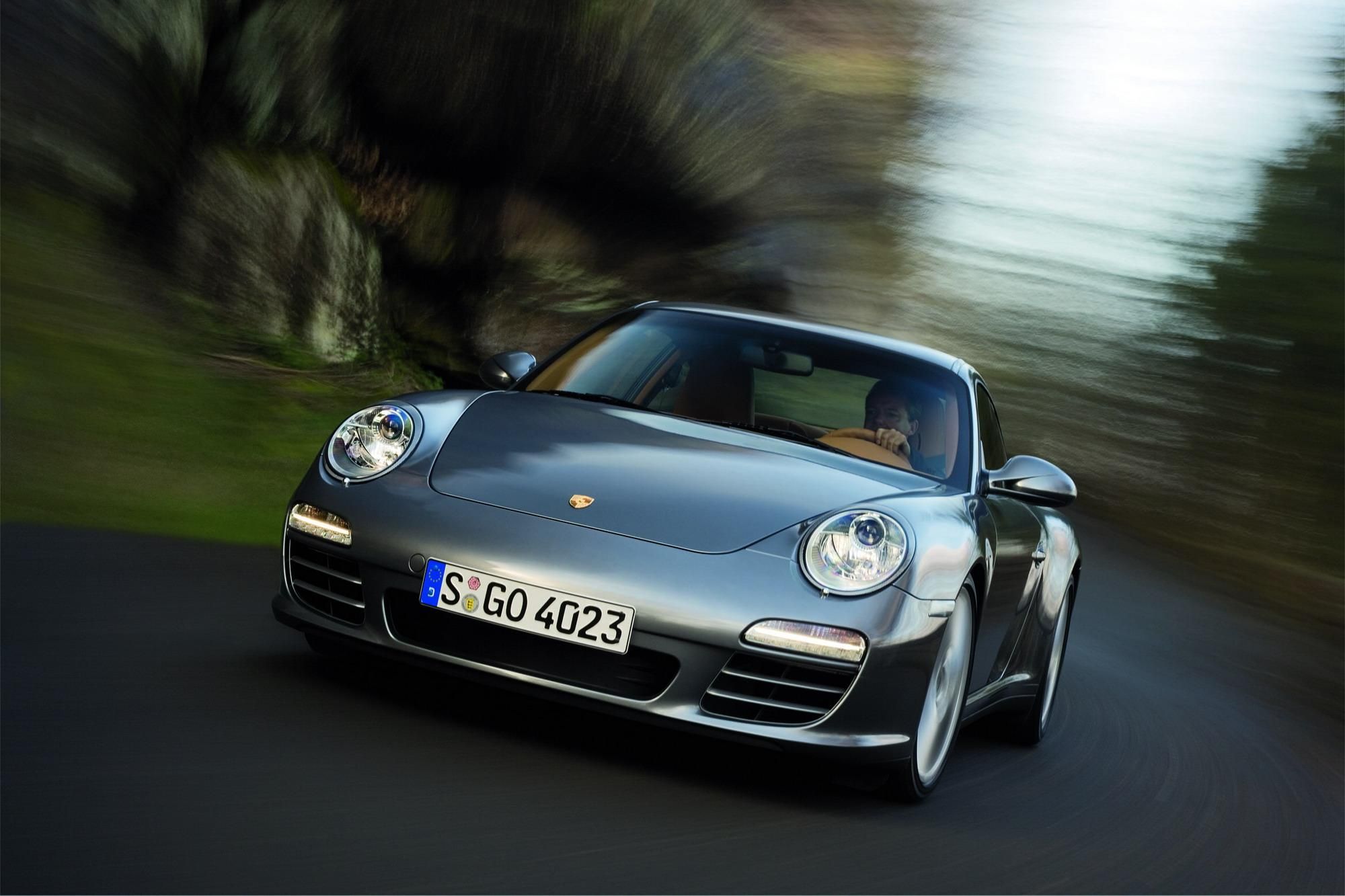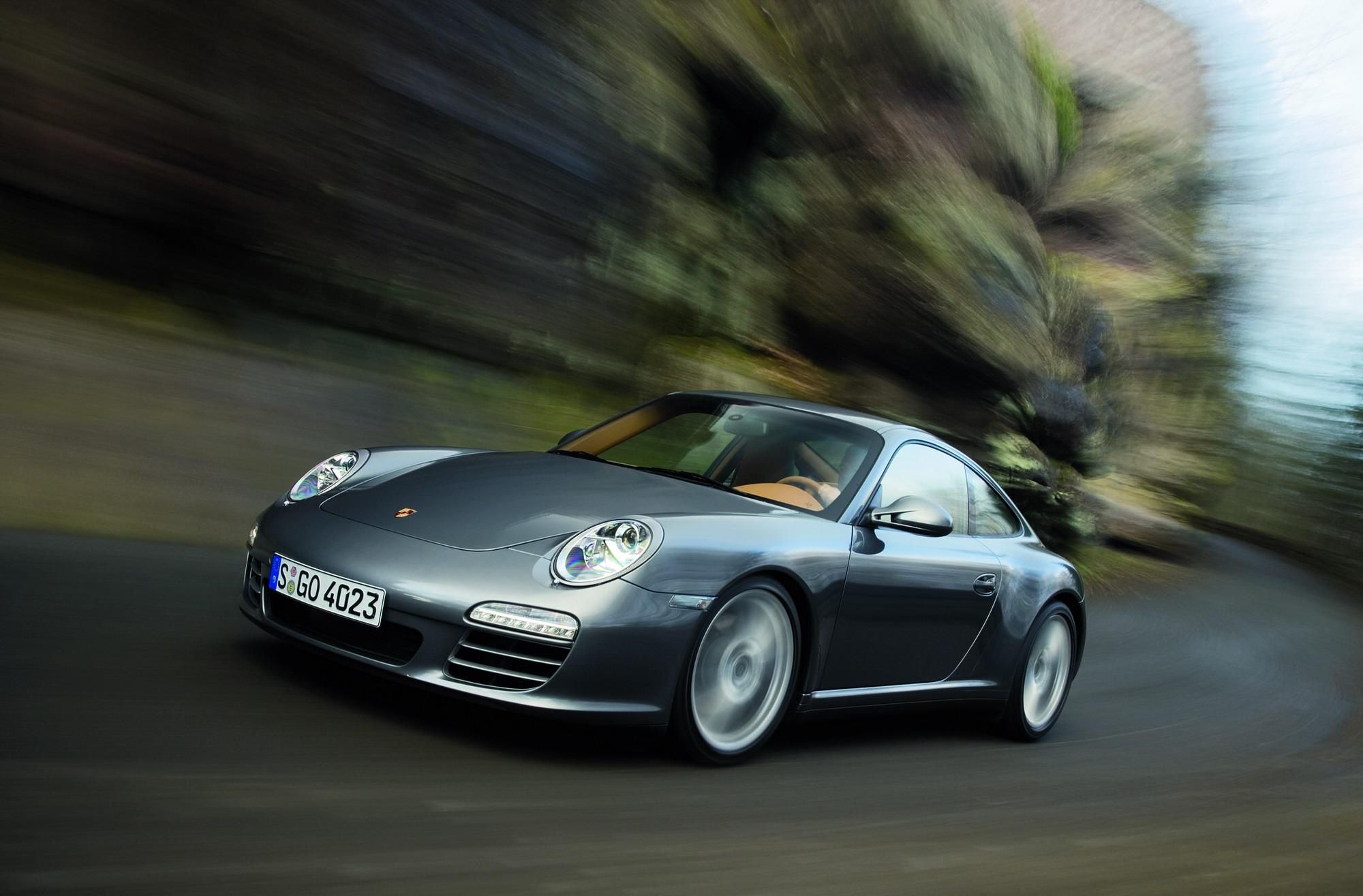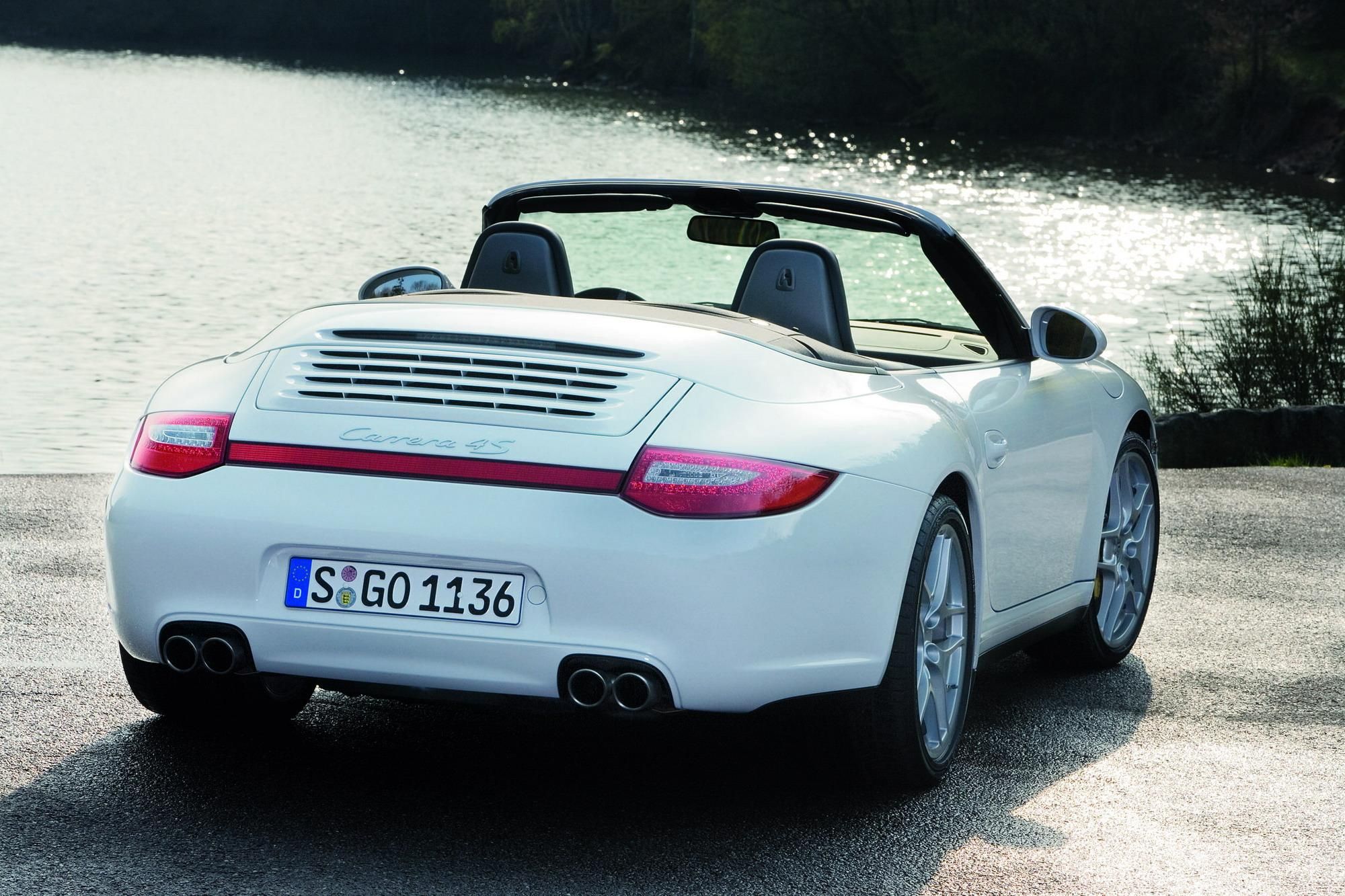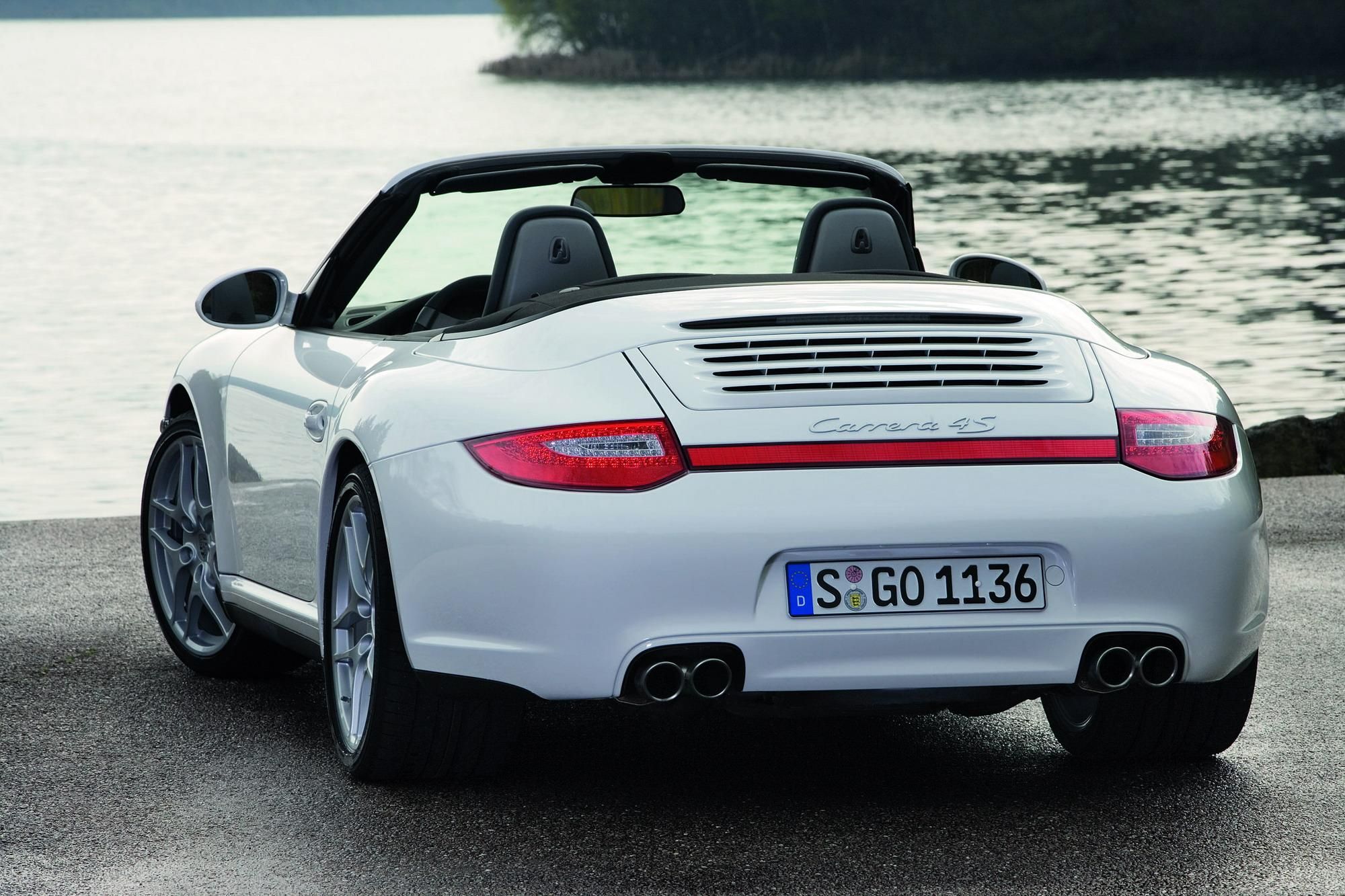Porsche revealed today two new models in its new 911 line-up: the Carerra 4 and Carrera 4S. The new models will go on sale starting 25 October 2008.
The Carrera 4 is powered by a 3.6-litre power unit that delivers 345 bhp. Featuring the new PDK system the fuel consumption goes down to 10.1 litres of fuel per 100 kilometres, equal to 28.0 mpg imp.
The 911 Carrera 4S is powered by a 3.8-litre power unit that delivers 385 hp and the fuel consumption goes down to 10.7 litres/100 km, equal to 26.4 mpg imp.
The new all-wheel-drive sports cars come with sporting manual transmission featuring six gears. As an alternative the new models are available with Porsche’s new Doppelkupplungsgetriebe replacing the former Tiptronic S automatic converter transmission and offering an even faster gearshift on less fuel. The Doppelkupplungsgetriebe or double-clutch gearbox comes with seven gears shifting electrohydraulically without the slightest interruption of traction and pulling force.
Press release after the jump.
porsche-carrera-4-and-4s
- Make: Array
- Model: porsche-carrera-4-and-4s
2009 Porsche Carrera 4 and 4S
- Make: Array
- Model: 2009 Porsche Carrera 4 and 4S
- [do not use] Vehicle Model: Array
Press release
Showing the dynamic attitude typical of the brand, Dr. Ing. h.c. F. Porsche AG, Stuttgart, are continuing the generation change of the 911 model series. Just a few weeks after the new 911s with classic rear-wheel drive, the all-wheel-drive versions Carrera 4 and Carrera 4S are now entering the market in both Coupé and Cabriolet guise.
A whole range of new technologies surrounding the engine, the transmission and drivetrain ensures an even higher standard of driving pleasure on much lower fuel consumption. Particularly the precision and fast response of the new, electronically controlled all-wheel drive offers an even more intense driving experience, above all in interaction with the likewise new flat-six engines with Direct Fuel Injection and the PDK Porsche Doppelkupplungsgetriebe or double-clutch gearbox available as an option.
The features and characteristics of the new engines speak for themselves: Depending on the model, the new all-wheel-drive Carrera offers up to 8.5 per cent more power, up to 12.9 per cent more fuel economy, and 15.4 per cent lower CO2 emissions. Specifically, output of the 3.6-litre power unit is up by 20 to 345 bhp (254 kW). At the same time a Carrera 4 Coupé with PDK, to take just one example, consumes a mere 10.1 litres of fuel per 100 kilometres, equal to 28.0 mpg imp. The improvements on the 911 Carrera 4S with its 3.8-litre power unit are equally significant, with maximum output up by 30 to 385 bhp (283 kW) on overall fuel consumption down in the case of Carrera 4S Cabriolet with PDK to 10.7 litres/100 km, equal to 26.4 mpg imp.
In the new generation of the Carrera 4 and Carrera 4S electronically controlled PTM Porsche Traction Management replaces the former all-wheel drive with its viscous multiple-plate clutch. This superior system developed for the 911 Turbo and modified for the Carrera models combines the driving pleasure so typical of Porsche with an even higher standard of driving stability, traction and agile handling further enhanced by the mechanical rear axle differential fitted as standard.
The new all-wheel-drive sports cars come with sporting manual transmission featuring six gears. As an alternative the new models are available with Porsche’s new Doppelkupplungsgetriebe replacing the former Tiptronic S automatic converter transmission and offering an even faster gearshift on less fuel. The Doppelkupplungsgetriebe or double-clutch gearbox comes with seven gears shifting electrohydraulically without the slightest interruption of traction and pulling force.
The new generation of the 911 model series stands out clearly through the discreet but striking modification of the front end and new lights technology. The new Carrera models come in all cases with bi-xenon headlights and new LED daytime driving lights.
The newly designed rear light clusters also feature LED technology and for the first time Porsche offers Dynamic Bending Lights as an option. It almost goes without saying that all Carrera 4 models come as before with their muscular rear end 44 millimetres or 1.73” wider than on the two-wheel-drive versions. And a new reflector trim bar between the LED rear lights gives the typical rear end of the car even more dynamic character.
New PCM Porsche Communication Management with its touch-sensitive screen improves operation of the in some cases optional navigation, information and audio systems to an even higher standard. And a further important point is that PCM is now compatible with Bluetooth, USB and iPod requirements.
All all-wheel-drive Carrera models will be at the dealership as of 25 October 2008.
-----
More Emotions, Less Emissions
The latest generation of Porsche sports cars with all-wheel drive clearly defined by the num¬ber “4” in the model designation is entering the market with a wide range of new technolo¬gies on the engine, transmission, and power distribution – the core components of the car.
Both power units – again displacing 3.6 litres in the Carrera 4 and 3.8 litres in the Carrera 4S – are brand-new from the ground up and are supplied with fuel by DFI direct fuel injection. The result is yet a further significant increase in efficiency, with more power and torque on less fuel and lower emissions.
Porsche’s new PDK Doppelkupplungsgetriebe replacing the former Tiptronic S as an optional, self-shifting transmission, offers the same benefits. And the third quantum leap in techno¬logy offering a significantly higher level of driving pleasure is the transition from hydraulic to electronically controlled all-wheel drive already offering enhanced driving dynamics, extra driving safety, and optimised traction on the 911 Turbo.
Fuel/air mixture formation directly in the combustion chamber serves to generate more energy from less fuel – and the results of this far-reaching innovation speak for themselves: Depending on the model, the new all-wheel-drive Carreras offer up to 8.5 per cent more power and performance, 12.9 per cent greater fuel economy, and 15.4 per cent lower CO2 emissions.
Specifically, maximum output of the 3.6-litre power unit is up by 20 bhp to 345 bhp (254 kW), while at the same time the Carrera 4 Coupé featuring Porsche’s new PDK Doppelkupp¬lungs¬getriebe consumes only 10.1 litres of gasoline/100 kilometres, equal to 28.0 mpg imp.
The various improvements on the 911 Carrera 4S with its 3.8-litre power unit are similarly impressive, an increase in engine output by 30 bhp to 385 bhp (283 kW) coming together with an appropriate decrease in fuel consumption, even the open-air Carrera 4S now consu¬ming only 11.2 litres/100 km in the combined cycle, equal to 25.2 mpg imp.
Despite their more sophisticated technology, the new power units are approximately six kilos lighter than their predecessors. The crankshaft and combustion chambers are brand-new on both the 3.6-litre and the 3.8-litre engines, smaller stroke and the larger bore keeping effective engine displacement almost the same as before while serving to further enhance the engine’s free-revving performance and spontaneity.
In the process of re-designing the engine block and its ancillaries, Porsche’s engineers have also created new, single-piece cylinder heads. And as in the past, the cylinder heads come with VarioCam Plus variable valve management developed by Porsche, with adjustable valve timing on the intake side and valve stroke switchover.
Doppelkupplungsgetriebe for even faster acceleration
Like every Porsche 911, the new all-wheel-drive models come as standard with a sporting manual gearbox. The increments on the six gears are a carefully balanced synthesis of agility, on the one hand, and economy, on the other.
Introducing the new PDK Doppelkupplungsgetriebe incorporating no less than seven gears, Porsche now offers an alternative to the manual gearbox with features and qualities even greater than those of the manual transmission. PDK serves furthermore to replace the for¬mer Tiptronic S.
Both the PDK Doppelkupplungsgetriebe and the manual gearbox come as standard with a Start-¬Off Assistant supporting the driver on uphill gradients and enabling him to set off smoothly and comfortably without having to use the handbrake.
The optical highlight of the 911 Carrera with its PDK gearbox is the new PDK sports steering wheel boasting a new, enhanced control philosophy as well as the newly designed selector lever which, like the paddles on the steering wheel, allows manual control of the transmission.
In terms of acceleration, the 911 Carrera 4 with PDK, offering an even faster gearshift with¬out the slightest interruption of traction and pulling force, sets up new records: The new 911 Carrera 4 Coupé with Doppelkupplungsgetriebe accelerates to 100 km/h in 4.8 seconds, 8/10ths of a second faster than the former model with Tiptronic S. The Carrera 4S Coupé, in turn, completes the same exercise in 4.5 seconds, as opposed to 5.3 seconds on the for¬mer model.
Yet another significant feature of the PDK Doppelkupplungsgetriebe is the reduction of power loss thanks to the high standard of mechanical efficiency and the double clutch optimised to reduce any loss of power to a minimum.
While the 911 Carrera 4 Coupé with Tiptronic S, that is the former generation, consumed 11.6 litres/100 kilometres (24.3 mpg imp) in the EU combined cycle, the new model with PDK technology outperforms this figure by 1.5 litres, reducing average fuel consumption to 10.1 litres/100 km, equal to 28.0 mpg imp. The former S model with its 3.8-litre power unit and Tiptronic S, in turn, consumed 11.9 litres /100 kilometres (23.7 mpg imp), whereas now the new 911 Carrera 4S with PDK makes do with just 10.5 litres/100 km (26.9 mpg imp).
Available as an option, Sports Chrono Package Plus serves to make the PDK Doppelkupp¬lungs¬getriebe even more dynamic for truly supreme performance at all times. First, the Sports Chrono Package Plus offers the additional Launch Control function for optimum accelera¬tion from a standstill; second, it also provides a gearshift strategy for extremely sporting driving with a very fast gearshift. Hence, Launch Control shortens acceleration times of cars with PDK by another 0.2 seconds, the fastest model in the range being the Carrera 4S Coupé now accelerating to 100 km/h in 4.3 seconds.
All-wheel drive now with electronic control
In the new generation of the Carrera 4 and Carrera 4S electronically controlled PTM Porsche Traction Management replaces the former all-wheel drive with its viscous multiple-plate clutch. Carried over from the 911 Turbo and tailored to the Carrera models, this unique system combines the driving pleasure so typical of a Porsche thanks to the engine at the rear and rear-wheel drive with an even higher standard of driving stability, traction and agile handling.
To achieve this superiority, PTM feeds the optimum share of engine power under all driving conditions via a multiple-plate clutch to the front wheels. And doing this within 100 milliseconds at the very most, PTM is faster than even the quickest driver will even feel or notice.
Porsche’s all-wheel drive therefore “looks ahead”, as it were, in offering optimum driving qualities. In practice this means superior agility on tight country roads, outstanding traction and superior driving safety also in extreme driving manoeuvres at very high speeds. Just how consistently the entire Carrera 4 family is designed and built for driving dynamics is also borne out by the limited-slip differential featured as standard, a mechanical transverse lock on the rear axle enhancing the driving dynamics provided by the fully controlled all-wheel-drive system.
Sports suspension based on PASM
The dynamic driving potential of the all-wheel drive Carrera now raised to an even higher standard demands the utmost of the chassis and suspension. Accordingly, both the convec¬tional chassis on the Carrera 4 and the electronically controlled PASM suspension (Porsche Active Suspension Management) featured as standard on the Carrera 4S and available as an option on the 3.6-litre model have been optimised and fine-tuned to the dynamic poten¬tial of the new model.
To reflect the even higher standard of performance, the springs, dampers and anti-roll bars on all models have been newly set up, the Cabriolets offering the same unique driving fea¬tures and performance as the Coupé models, combined and at the same time with a some¬what more comfort-oriented set-up.
In upgrading the chassis and suspension, particular attention was given to the fine-tuning of all components on the respective model variants in the interest of perfectly balanced driving behaviour.
As a special variant of the active suspension, Porsche now offers the PASM sports suspen¬sion for the new Coupé models. This very special suspension is conceived for particularly sporting and ambitious drivers, replacing the sports suspension with conventional dampers on the former models. Like the former conventional sports suspension, the new active PASM sports suspension features even firmer springs and lowers the entire car by 20 millimetres or 0.79”. As a re¬sult, this new, active suspension enhances driving performance to an even higher standard, together with a further improvement of motoring comfort.
Bi-xenon headlights, LED daytime driving lights, Dynamic Bending Lights
The new generation of the Porsche 911 stands out right from the start through its discreet but striking upgrade of the front end and the car’s new lights technology.
All versions of the new 911 come as standard with bi-xenon headlights and new LED day¬time driving lights giving Porsche’s sports cars a unique position in the market also in terms of their looks and appearance.
The newly configured rear light clusters also come in LED technology offering a long service life, reducing the consumption of electric power and increasing the standard of driving safety through their faster response than in the case of conventional incandescent bulbs. And last but certainly not least, Porsche for the first time offers Dynamic Bending Lights as an option on the new 911.
A feature typical of the Carerra 4: the extra-wide rear end
The new generation of the Porsche 911 is also characterised by the car’s typical wheels in new design with five double spokes in V-configuration. The 3.6-litre models come as standard with 235/40 ZR 18 tyres at the front, the S models powered by the 3.8-litre engine feature 235/35 ZR 19 tyres on the front wheels.
Despite these sporting and muscular wheels, the focus is clearly on the rear axle with wheel arches widely flared in the typical style of the Carrera 4, broadening the rear end by 44 milli¬metres or 1.73”. At the rear the Carrera 4 comes on 295/35 ZR 18 tyres, and the Carrera 4S boasts 305/30 ZR 19 tyres. Yet another feature characteristic of the all-wheel-drive models is the red trim strip connecting the two rear light clusters on the right and left.
PCM with touchscreen and optional hard disc navigation
With its upgraded control concept, the interior again shows the driver right from the start that he is sitting in the latest generation of the Porsche 911.
The key feature is new PCM Porsche Communication Management with significantly stream¬lined control buttons and a larger touchscreen monitor (increased in size from 5.8 to 6.5 inches). In conjunction with the universal audio interface available as an option, PCM now enables the user to also mastermind external audio sources such as an iPod® or a USB stick.
New seat ventilation available as an option on both the standard and comfort seats makes a further contribution to improved seat comfort and fatigue-free motoring for both the driver and front passenger. The ventilating system may even be combined with seat heating for passenger a pleasant seating climate at all times.
New 911 Carrera 4 / 911 Carrera 4S
Even more dynamic, even safer, and even more economical – introducing the most advanced mechatronic control and management systems, Porsche has further enhanced the leadership of the all-wheel-drive sports cars in the Carrera range over the competition. Both the 911 Carrera 4 and the 911 Carrera 4S available in the market as of summer 2008 are equipped with this new technology on both the Coupé and the Cabriolet, upgrading the engine, trans¬mission, and power distribution to an even higher, truly unprecedented standard.
Both power units – displacing as before 3.6 litres in the Carrera 4 and 3.8 litres in the Carrera 4S – are brand-new from the ground up and now feature direct fuel injection (DFI) in cutting-edge technology. The result is a further significant increase in all-round efficiency, with more power and torque on less fuel and lower emissions.
Doppelkupplungsgetriebe and electronically controlled all-wheel drive
Porsche’s new PDK Doppelkupplungsgetriebe replacing the former Tiptronic S transmission, as an optional, self-shifting transmission offers the same superior benefits. PDK not only shifts gears faster than ever before without the slightest interruption of traction and pulling force, but also reduces power losses to an even lower level than on a conventional automatic transmission.
As a result, the 911 with its PDK Doppelkupplungsgetriebe accelerates faster than ever before and reduces fuel consumption to even further: The Carrera 4S Coupé with PDK, for example, accelerates to 100 km/h in 4.5 seconds as opposed to 4.7 seconds on the manual gearbox model, the optional Sports Chrono Package Plus then reducing acceleration in the standard sprint to an even more outstanding 4.3 seconds.
The third change in technology, introducing a new generation of high-tech equipment, is the introduction of electronically controlled all-wheel drive replacing the former hydraulic system, a technology already benefiting the 911 Turbo in terms of driving dynamics, safety, and traction.
-----
Power Unit
Introducing the new Carrera power units, Porsche is also switching over to DFI Direct Fuel In¬jection in the new sports cars. The forerunner establishing this technology at Porsche was the Cayenne sports utility, followed by the rear-wheel drive 911 and now the all-wheel-drive models.
Formation of the fuel/air mixture directly in the combustion chamber serves to generate more energy from less fuel, a dramatic new development offering truly impressive results: Depending on the model and level of equipment, the new all-wheel-drive Carreras offer up to
- 8.5 per cent more power and 5.4 per cent more torque
- 12.9 per cent greater fuel economy and 15.4 per cent lower CO2 emissions.
Direct fuel injection not only improves engine efficiency, but also the characteristics and typical running features of the engine. And this the driver will feel immediately, since the injection of fuel fractions of a second prior to the operating cycle gives the engine an even more direct response to every movement of the gas pedal. Indeed, this is the case not only when accelerating, but also when taking back the accelerator. And it almost goes without saying that all new Carrera 4 and Carrera 4S-models outperform the strict standards of the Euro5 emission norm not coming into force until September 2009.
Homogeneous operation for optimum combustion
Direct fuel injection on the new horizontally-opposed engines is conceived for homogeneous operation: The fuel/air mixture is spread out homogeneously throughout the combustion chamber in the interest of optimum, ultra-smooth combustion at all times. This again guarantees maximum efficiency on the catalytic converters reducing harmful emissions to a minimum.
The injector positioned between the two intake valves is aimed directly at the two streams of incoming air. Since the fuel evaporating in the process reduces the temperature in the combustion chamber, the engine is able to draw in more air, increasing the cylinder charge and, as a result, boosting engine output. At the same time the cooler fuel/air mixture allows a higher compression ratio enhancing efficiency and increasing engine output on less fuel.
All cylinders on both engines are now designed for a maximum compression ratio of 12.5:1 as opposed to 11.8:1 on the former 3.8-litre and 11.3:1 on the previous 3.6-litre power unit.
High-pressure stratified start-up and catalyst heating for even greater fuel economy and lower emissions
Right from the start in its very first operating cycles, direct fuel injection, featuring high-pressure stratified start-up and a special catalyst heating phase, enhances combustion to an even higher level of efficiency and all-round performance. The big advantage of the high-pressure stratified start-up method is that fuel is injected directly into the specifically designed piston crown creating a stratification effect with an ignitable fuel/air mixture forming around the spark plug. This not only reduces the amount of fuel required versus conventional mani¬fold injection, but also the level of emission volume.
Following the high-pressure stratified start-up process, engine management switches over automatically to the catalyst heating phase with multiple fuel injection increasing the tempe¬rature of the exhaust emissions and heating up the catalyst as quickly as possible. To achieve this effect the fuel/air mixture is ignited at a very late point, increasing exhaust tempera¬tures to an even higher level and reducing emissions while the engine is still in the start-up phase.
Multiple fuel injection for a smooth and robust combustion process
Multiple injection is also the strategy applied in the upper load range at engine speeds of up to approximately 3500 rpm. This is the case, for example, when the driver quickly presses down the gas pedal to accelerate at low engine speeds. The fuel volume required for com¬bustion is subdivided under such circumstances into several successive injection processes, fuel now being injected during the intake cycle with the intake valves open, the even better fuel/air mixture obtained in this way helping to save even more fuel.
Under all other operating conditions fuel is injected in one single process.
Yet a further advantage of multiple fuel injection is that the combustion process under such engine load conditions is particularly stable and robust.
The engine block: weight down, stability up
Despite their more sophisticated and elaborate technology, the new engines are approxima¬tely six kilos lighter than the former power units. The former four-piece engine block with its separate crankshaft bearing case, for example, has now been replaced by a two-piece crankcase with integrated crankshaft bearings. The result is not only a reduction of weight, but also a smaller number of components. At the same time Porsche’s engineers have en¬hanced the thermal and mechanical robustness of the engine by converting the construction of the cylinders from an open- to a closed-deck structure.
The crankshaft and combustion chambers are brand-new on both the 3.6- and 3.8-litre power units. Small stroke and the large bore keep effective engine capacity at almost the same level as before, but make the engines even more spontaneous and ensure even greater free-¬revving performance. Re-constructing the entire engine block, Porsche’s engineers have also developed new single-¬piece cylinder heads making the overall structure not only lighter but also more stable.
As in the past, the cylinder heads feature VarioCam Plus variable valve management deve¬loped by Porsche with valve timing controlled on the intake side and valve lift switching in all cases to the appropriate mode as a function of running conditions. The big advantage of VarioCam Plus, first, is optimum engine output and torque, with, as the second important benefit, greater fuel economy, enhanced emission management, and greater running refine¬ment and smoothness. In conjunction with the new direct fuel injection, this ensures an ideal symbiosis of greater performance and extra torque on even less fuel.
New: oil pump operating on demand, external coolant pump
Optimising the oil system was a further step taken by Porsche’s engineers in enhancing the efficiency of the new engines. The oil circuit on the new power units is based on the prin¬ciple of integrated dry sump lubrication and incorporates four intake pumps and, for the first time, an electronically controlled pressure oil pump operating on demand.
Masterminded by the engine management system, the oil pump requires only as much energy as is really necessary, while at the same time ensuring highly efficient lubrication at all times according to current demand.
The pressure oil pump runs on one shaft together with the four intake pumps around the oil sump and is driven by a chain coming directly from the crankshaft. In each case two in¬take pumps extract oil from the two cylinder heads and feed the oil required to the oil sump.
A further new feature is the configuration and position of the coolant pump as a separate module outside of the crankcase. The advantage of this design concept is the flexible con¬figuration of the coolant pump in its size and capacity as well as easier repair and main¬tenance whenever required. To reflect the greater power of the engine and to ensure adequate engine cooling at all times, the maximum volume flow on the new water pump is up by approximately 20 per cent.
New intake manifold
The new horizontally-opposed power units draw in air through a brand-new intake manifold bearing the designation “Direct Fuel Injection” together with the numbers “3.6” or, respectively, “3.8”. The former single-chamber air filter system with its integrated intake funnel has been replaced on the new models by a double-chamber air filter system with two intake points and separate intake funnels fitted directly on the rear lid. Accordingly, intake air no longer flows in through a single plate filter, but rather through two round filters reducing flow resistance and increasing the inspection intervals for the air filter elements from 60,000 to 90,000 kilometres (37,000 – 56,000 miles).
The intake manifolds on the new engines are likewise brand-new in their design and con¬figuration. They are made of plastic with a resonance tube and feature additional resonance chambers in the interest of an optimum sound effect. Thanks to the switchable resonance flap, air oscillation in the intake system of the 3.8-litre power unit is adjusted to the current level of engine speed, the enhanced cylinder charge ensured in this way serving to increase engine torque right from the start at low speeds.
Exhaust system even more effective
All of the new all-wheel-drive Carrera models feature the same high-tech exhaust system. And as in the past, the Carrera 4 with its 3.6-litre power unit comes with two oval individual tailpipes, while the Carrera 4S displacing 3.8 litres features dual round tailpipes made of brushed stainless steel.
Instead of being fitted crosswise behind the engine, the catalytic converters on the new models are integrated directly behind the right-hand and left-hand manifolds, thus reaching their regular operating temperature even faster than usual, making secondary air injection, the technology previously applied for this purpose, superfluous.
In conjunction with the improvements and new technologies introduced on the engines themselves, the new models thus fulfil both the EU5 emission standard in Europe and the LEVII regulations in the USA.
-----
Transmission
By tradition, Porsche’s new all-wheel-drive sports cars, like all models in the Porsche 911 family, come as standard with a sporting manual gearbox offering the driver ideal qualities for shifting gears quickly, smoothly, and with optimum precision. The increments between the six gears ensure a carefully balanced synthesis of agility and all-round economy.
The new PDK Doppelkupplungsgetriebe incorporating no less than seven gears for an opti¬mum gear ratio at all times now available as an option goes even further in its qualities and the benefits offered than the manual gearbox, at the same time replacing the former Tiptronic S transmission.
The manual gearbox based on the former model has been modified both in its geometric connection to the engine and in its internal elements to reflect the enhanced performance of the new power units. Compared with the former models, third gear, for example, is approximately 3 per cent “longer”.
The transmission on both engine variants also features a wear-compensating clutch previously fitted only on the 3.8-litre model.
New Start-Off Assistant featured as standard
Regardless of the transmission, the new models come as standard with a special Start-Off Assistant. Automatically maintaining the brake pressure built up by the driver in operating the brake pedal, this sophisticated system enables the driver to set off smoothly and com¬fortably on an uphill gradient without having to pull the handbrake.
The Start-Off Assistant operates in accordance with the current, specific uphill gradient, the desired direction of travel, and the gear currently in mesh. The system is activated for approximately two seconds by the driver exerting appropriate pressure on the brake pedal, whenever the car is parked on an uphill gradient with a forward gear in mesh or on a down¬hill gradient with the reverse gear engaged.
New Doppelkupplungsgetriebe for even greater driving dynamics
Introducing the new generation of the 911 Carrera, Porsche is offering an optional Doppel¬kupplungsgetriebe on a street-legal sports car for the first time. Following the world debut of this sophisticated technology in the rear-wheel-drive Coupés and Cabriolets, Porsche now also features this sophisticated technology on the all-wheel-drive models.
The PDK Doppelkupplungsgetriebe goes back a long way with Porsche, featured for the first time in the 1980s in the Group C 956 and 962 racing cars. With Porsche thus being the world’s first car maker to actually use this technology in practice, the Company has longer experience with the Doppelkupplungsgetriebe in high-performance sports cars than any other manufacturer.
Rapid gear change without the slightest interruption of traction and pulling force
In principle the new PDK Doppelkupplungsgetriebe consists of two separate transmission units in the conventional manual gearbox and a hydraulic control unit. The transmission is built around two wet clutches running on a joint axle and operated, cooled and lubricated by a special transmission fluid. One clutch is responsible for the first transmission unit in¬corpora¬ting the uneven gears and reverse gear, the other clutch is for the second transmission unit with the even gears.
Via a number of pressure valves, the hydraulic control unit masterminds both the wet clutches and the gearshift cylinders shifting to the appropriate gear and ratio desired in each case.
The fundamental difference versus a conventional manual gearbox is that the process of shifting gears as perceived by the driver does not involve an actual gearchange in the trans¬mission itself, but rather a changeover from one clutch in positive engagement to the other clutch, and vice versa. To perform this function, the clutch on one transmission unit is opened while the other is closed at exactly the same time, that is in a fully simultaneous process.
The big advantage is an even faster gearshift than on even the fastest manual gearbox or converter automatic transmission, with the gears already in mesh when the driver shifts from one ratio to the other, eliminating even the slightest interruption of traction and pulling force during the shifting process. And last but not least, PDK also offers the advantage of lower weight: despite two additional gears, being approximately 10 kilos lighter than the former Tiptronic S transmission.
The Porsche Doppelkupplungsgetriebe combines the excellent driving dynamics and supreme mechanical efficiency of a manual gearbox with the superior gearshift and motoring comfort of an automatic transmission. Hence, the new PDK Doppelkupplungsgetriebe is perfectly suited for both the sporting and comfort requirements of the 911 driver expecting nothing but the best.
The new Doppelkupplungsgetriebe comes with seven forward gears and one reverse gear. Gears 1 – 6 feature a sporting transmission ratio, with the cars reaching their top speed in sixth gear. Seventh gear, in turn, has a “long” transmission ratio in the interest of enhanced fuel economy.
Changing gears with pre-selection
The process of setting off in the car offers a good description of how PDK works in practice: With the driver accelerating in first gear, second gear is automatically pre-selected in the second gearbox unit still free of load, with clutch II still open. This process of selecting se¬cond gear is performed within just a few milliseconds and is not even perceived by the driver. Then, when shifting up to second gear, the first clutch is opened and the second clutch closed exactly in parallel. Hence, engine torque is transferred in a controlled process from one clutch to the other also under full load, without the slightest interruption of traction or pulling force.
Throughout the entire process of shifting up and down, the PDK Doppelkupplungsgetriebe ope¬rates according to the same, consistent principle. In the manual mode gears may only be shifted under load from an uneven to an even gear and visa versa. However, PDK offers the option to shift down several gears very quickly by a quick succession of gearshift commands from the driver.
In the automatic mode the transmission is able to skip several gears, shifting, for example, directly from seventh to second gear. And if the driver wishes to shift, say, from sixth to second gear within one transmission unit, PDK temporarily shifts to fifth gear, at the same time pre-selecting second gear in the other gear lane and synchronising engine and gearbox speed by briefly giving gas to apply the accelerator function.
Shifting quickly with superior comfort
Compared with Tiptronic S, the PDK Doppelkupplungsgetriebe allows an even more spor¬ting and dynamic style of motoring and offers extra agility for supreme driving pleasure. The new transmission shifts gears up to 60 per cent faster than the former automatic trans¬mission, the rapid gearshift without the slightest interruption of traction and pulling force, together with an increase in torque in the Sports program, providing even better accelera¬tion and elasticity and, as a result, even faster lap times. Yet a further point is that the driver of a Porsche 911 equipped with the PDK Doppelkupplungsgetriebe does not have to make any con¬cessions in terms of motoring comfort, the new gearbox offering smooth and fully auto¬matic operation of the clutch and an equally smooth and direct gearshift at all times.
Equipped with Porsche’s new Doppelkupplungsgetriebe, the new 911 Carrera 4 Coupé acce¬le¬rates to 100 km/h in 4.8 seconds, making it 8/10ths of a second faster than its prede¬cessor with Tiptronic S. The Carrera 4S Coupé, in turn, completes the same exercise in 4.5 seconds, as opposed to 5.3 seconds on the former model.
A further important feature of PDK is the smaller power loss resulting from the high standard of mechanical efficiency and the optimised double-clutch reducing the loss of power to a minimum. This also explains why the new model with PDK consumes an average of just 10.1 litres on 100 kilometres (equal to 28.0 mpg imp) as opposed to the average fuel con¬sumption of the former 911 Carrera 4 Coupé with Tiptronic S in the EU combined cycle of 11.6 litres/100 kilometres (equal to24.3 mpg imp), an improvement by no less than 1.5 litres. And while the former S-model with its 3.8-litre power unit and Tiptronic S consumed 11.9 litres/100 kilometres, equal to 23.7 mpg imp, the new Carrera 4S with PDK makes do with just 10.5 litres, equal to 26.9 mpg imp.
Shifting gears either on the selector lever or directly on the steering wheel
The driver of the new 911 Carrera with PDK is able to use the functions and benefits of the Doppelkupplungsgetriebe either via the paddles incorporated directly in the spokes of the new 370-millimetre PDK steering wheel or via the likewise newly designed selector lever in the centre console. The steering wheel in its sporting three-spoke design comes with two ergonomically posi¬tioned gearshift paddles the driver presses to the front or to the rear in order to shift gears smoothly, precisely and intuitively under all conditions, regardless of the position of the steering wheel.
Pushing the paddles to the front, the driver shifts up, pushing the paddles from behind the steering wheel, he shifts down.
Both the PDK sports steering wheel as well as the multi-function steering wheels available as an option also for PDK may be upgraded as a further option by a separate steering wheel heating function activated by a button at the back of the steering wheel in the six o’clock position and controlled by the interior temperature sensor.
The new PDK transmission may also be operated smoothly and conveniently via the central selector lever in the centre console. Within the selector lever the letters “PDK” highlight this new technology, while the embossed presentation of the gearshift pattern on the selector lever release button follows the look of the gearshift knob on the manual gearbox.
The gearshift pattern is also presented on the shift lever trim cover, with the actual gearshift process following the same concept as on the steering wheel paddles: To shift up, the driver merely presses the lever forward, to shift down he pulls it back.
The selector lever is released for use by pressing the release button on the selector handle. The PDK gear display in the instrument cluster, in turn, is based on the further enhanced Tiptronic S concept supplemented by an easy-to-read numerical display showing the gear currently in mesh (1 – 7). The driving program currently in use (P, R, N, D, and M), in turn, is presented by red light-emitting diodes next to the gearshift pattern.
Automatic gearshift program offering the same comfort as Tiptronic S in the past
The automatic transmission programs provided by the PDK Doppelkupplungsgetriebe may in principle be compared with the former Tiptronic S programs. The gearshift programs have however been fundamentally revised in order to meet growing demands for a sporting and comfortable configuration and set-up of the seven gears.
Opting for the Sports Chrono Package Plus as a further significant feature, the customer choosing the PDK Doppelkupplungsgetriebe for his car has the opportunity, by pressing the SPORT or the SPORTPLUS button in the centre console, to directly choose the transmission setting he would like to enjoy. So depending on the button pressed and the driver’s sporting style of motoring, gearshift times may be shortened significantly both in the D- and M-modes.
The gearshift points are adjusted with infinite precision as a function of the driver’s style of motoring and again in accordance with the button pressed. The additional Dynamic Shift program enables the driver to shift back dynamically by quickly moving the gas pedal, with¬out requiring the conventional kick-down function.
The Automatic program also offers the following special functions:
- Suppression of the usual shifting-up process when quickly taking back the gas pedal, for example when entering a bend.
- Shifting down at an early point when applying the brakes, as a function of road speed and deceleration.
- Modification of the gearshift points as a function of uphill or downhill gradients, the exact gradient and driving conditions being assessed individually according to current require¬ments.
- Change in gearshift points as a function of elevation.
- Suppression of gears shifting up in bends as a function of road speed and lateral acceleration.
Notwithstanding all these functions, the driver still has the option to select gears directly via the paddles on the steering wheel. Gearshift commands given by the driver in the D program remain active only briefly for about 8 seconds, but may be held for a longer period as a function of engine thrust and lateral acceleration.
Sports Chrono Package Plus with Launch Control racing gearshift
The Sports Chrono Package Plus is available as an option on the new 911 Carrera 4 with PDK featuring the additional Launch Control function as well as a special gearshift strategy for an extremely sporting style of motoring. As on the former model, Sports Chrono Package Plus comprises the following fundamental features also on the new 911 Carrera 4 and 4S:
- Analogue and digital stopwatch on the instrument panel.
- Sports mode for the engine, suspension (PASM), and transmission, including two sports buttons (SPORT and SPORTPLUS button) for activating the sports mode.
- Performance display in the PCM.
- Individual memory.
Launch Control is an assistance program for setting off and accelerating with optimum power, performance, and traction. The function is activated by pressing the SPORTPLUS button in the centre console, activation of Launch Control being presented by the words “Launch Con¬trol active” in the instrument cluster.
To perform a racing start with the help of Launch Control, all the driver has to do is hold down the brake pedal with one foot and quickly press down the gas pedal with his other foot, thus activating the so-called kick-down mode and revving up the engine to a speed of approximately 6500 rpm.
At the same time the PDK control unit will inform the new PTM Porsche Traction Manage¬ment of the upcoming process of all-out acceleration, PTM thus switching over to 100 per cent all-wheel drive. Then, when the driver takes his foot off the brake pedal immediately afterwards, the transmission will adjust to optimum wheel slip and enable the car to set off with maximum acceleration as well as maximum traction ensured by all-wheel drive.
Should the driver keep the gas pedal fully down on the floor, all-wheel drive will remain locked in position up to a road speed of 45 km/h or 28 mph.
Launch Control gives the new models even faster acceleration to 100 km/h down in each case by 0.2 seconds. In other words, the Carrera 4 Coupé reaches 100 km/h after just 4.6 seconds, the Carrera 4S offers even faster acceleration to 100 km/h in just 4.3 seconds. And even the somewhat heavier Cabriolets are hardly any slower, the 3.6-litre model com¬pleting the same exercise in 4.8, the 3.8-litre version in 4.5 seconds.
The second new function offered by Sports Chrono Package Plus in conjunction with PDK is a special gearshift strategy for extremely fast and dynamic driving, offering the shortest possible shift times as well as gearshift points optimised for the race track.
This function is likewise activated by the SPORTPLUS button, PDK adjusting to the fastest possible reaction and gearshift times. Gears are selected within split-seconds, twice as fast as on the former Tiptronic S transmission.
Yet a further point is that the process of shifting up gears under full load when reaching the engine speed limit is performed together with an increase in torque, in practice putting the 911 Carrera with PDK several car lengths ahead of the same model equipped with Tiptronic S when accelerating from a standstill to 100 km/h. And the process of shifting back in overrun is conducted with interim gas in order to once again optimise the car’s performance.
Mechanical lateral lock featured as standard
The new models in the Carrera 4 range come as standard with a limited-slip differential on the rear axle offering 22 per cent locking action under power and 27 per cent in overrun. The mechanical locking differential on the rear axle further enhances the driving dynamics of Porsche’s fully controlled PTM traction management, improving traction on changing sur¬faces when driving to the limit in bends and enhancing the car’s driving stability under a load-¬change again in bends and on winding roads.
-----
All-Wheel Drive
Again upgrading the new generation of the Carrera 4 and Carrera 4S, electronically controlled PTM Porsche Traction Management replaces the former all-wheel drive with its viscous mul¬tiple-plate clutch.
Featured for the first time in the 911 Turbo, this high-tech system combines the driving pleasure so typical of a Porsche provided by the rear-mounted engine and rear-wheel drive with even greater driving stability, traction, and agile handling. To ensure this superiority, PTM feeds exactly the right share of engine power to the front wheels under all driving con¬ditions by way of a multiple-plate clutch.
Adjusting the distribution of drive power within 100 milliseconds at the very most, PTM is faster than even the most alert driver will ever perceive. As a result, Porsche’s all-wheel drive is able, as is were, to look ahead, offering superior agility on tight and winding country roads, as well as supreme traction and exemplary driving safety even in extreme manoeuvres at very high speeds. Indeed, boasting qualities of this calibre, Porsche Traction Management is one of the most efficient and, at the same time, one of the lightest all-wheel-drive systems in the market.
Five basic functions for all motoring requirements
To fulfil these dynamic tasks and requirements, PTM comes with five general functions of fundamental significance:
- Regular distribution of drive power: Under everyday driving conditions PTM distributes engine torque and power infinitely to the front and rear axles as a function of current driving requirements. This is done by determining the power currently required on the front axle within a matter of milliseconds, offering the driver a significant improvement of driving stability particularly at very high speeds.
- Pre-selection: Applying the parameters typically encountered on the road, PTM is able to detect dynamic changes in driving conditions at an early point, avoiding drive slip right from the start. When setting off, for example, the system determines how quickly the dri¬ver is accelerating, that is how hard he is pressing down the gas pedal. Then, even before the engine is able to convert this wish for acceleration into power and torque, PTM closes the multiple-plate clutch to prevent the wheels from spinning. As a result, all four wheels receive maximum drive power right from the beginning when setting off in the interest of optimum acceleration. A special case in this context is the racing start function provided by Launch Control in conjunction with the PDK gearbox: Whenever the driver wishes to benefit from this particularly dynamic function, PTM locks all multiple-plate clutches right from the start in order to guarantee maximum traction.
- Slip control: On account of their supreme torque, the Carrera models may reach their traction limit on the rear axle when accelerating on, say, a wet surface. So again, the mul¬tiple-plate clutch cuts in even more consistently under such conditions to convey more drive power to the front axle.
- Oversteer correction: Should the rear end of the car “push” to the outside in a bend on account of adverse circumstances such as wet leaves on the road, more power is fed to the front axle in order to stabilise the car under such dynamic conditions. Yet a further advantage of PTM is that it takes the steering angle into account in the process of feeding engine power to the front axle. So if the driver is countersteering, for example, PTM will adjust drive power on the front axle accordingly and the car will regain stability even more quickly.
- Understeer correction acts the same way: Should the car in the opposite situation “push” out of the bend over its front wheels, PTM will reduce the level of power and torque fed to the front wheels. With its highly accurate and responsive sensors, PTM reacts in both cases before the driver even notices any instability. As a result, the car is quickly and actively stabilised in the interest of fast and dynamic control also in bends, with Porsche Stability Management hardly having to cut in by applying the brakes selectively on indi¬vi¬dual wheels. This control strategy is based on the algorithm developed for the 911 Turbo and has been adapted specifically to the Carrera 4. Accordingly, the corrections applied by the PSM stability program cut in more gently and are even easier for the driver to control.
Multiple-plate clutch with magnetic control
The core element in the active all-wheel-drive powertrain is the multiple-plate clutch in the front axle housing boasting particular design features. First and foremost, the clutch is not activated by hydraulic control or additional actuators, but rather by electromagnetic manage¬ment. The annular magnet operates a control clutch with three sets of plates connected to a mechanical booster or amplifier (ball ramp). The booster then operates the main clutch comprising eight sets of friction plates.
While the multiple-plate clutch running in an oil bath is housed in the front axle differential casing, it comes with its own oil circuit and a separate circulation pump. The special ATF fluid used in this case only has to be changed once every 90,000 kilometres or 56,000 miles.
A special PTM computer communicating via a CAN bus with important control systems, for example to determine wheel rotation speed, lateral and longitudinal acceleration, as well as the steering angle, is responsible for controlling the clutch and ensuring optimum operation at all times. One of the reasons for the system’s very short reaction time is that current dri¬ving conditions are analysed by several control maps calculated in parallel to one another and not in series one after the other.
-----
Chassis and Brakes
Clearly, the supreme dynamic driving potential of the all-wheel-drive Carrera demands the outmost of the chassis and suspension. Hence, both the passive chassis on the Carrera 4 and the active PASM suspension on the Carrera 4S – which is also available as an option on the 3.6-litre – are set up and aligned perfectly to meet even the driver’s greatest demands.
To reflect the even higher standard of performance offered by the new models, the springs, dampers and anti-roll bars have been re-set on all versions of the Carrera 4 and the Carrera 4S, giving the Cabriolets the same superior suspension qualities as the Coupés, but with a some¬what greater focus on motoring comfort.
In upgrading the springs and dampers, particular significance has incidentally been given to the fine-tuning of all components for the respective version, ensuring perfectly balanced driving behaviour at all times.
The 911 Carrera with its regular suspension now features an additional outbound stop spring on both the front and rear axle. Providing its full effect on the outbound stroke, this special spring serves to enhance driving comfort to an even higher level than before.
Both the dampers and anti-roll bars are fine-tuned for enhanced control of the suspension and, at the same time, a high level of all-round comfort.
The PASM suspension has also been upgraded for the new 911, with the springs and anti-roll bars specially modified to reflect the even higher standard of dynamic performance. This is made possible by fine-tuning the PASM control function, the occupants enjoying greater com¬fort on bad roads and rough surfaces even in the Normal mode.
In the Sports mode PASM also provides smoother and more harmonious spring action with¬out requiring the driver to make any concessions in terms of performance.
The basic functions of PASM remain unchanged, enabling the driver through individual con¬trol of the dampers to choose among two suspension programs – either PASM Normal or PASM Sports. The Normal mode gives the dampers a more comfortable basic setting, then changing to a more sporting set-up as soon as the driver prefers a more dynamic style of motoring. Particularly on long distances, therefore, the occupants will enjoy a significantly higher standard of motoring comfort, with PASM filtering out small and medium bumps on the road even better and more effectively than the standard suspension.
The Sports set-up, in turn, activates a harder damper control map to allow a very agile style of motoring. And compared with the regular suspension, the entire vehicle is lowered in this case through PASM by 10 millimetres or 0.39’’.
New: PASM sports suspension and new design on the regular wheels
A special variant of the active suspension now available on the new Coupé models is the PASM sports suspension, which comes as a no-cost option for purchasers of the 911 Carrera 4S and is available as special equipment at extra charge on the Carrera 4.
This special suspension is for the particularly ambitious and sports-minded driver, replacing the sports suspension with conventional dampers featured on the former models. Like the passive sports suspension in the past, the new, active PASM sports suspension offers even firmer springs and lowers the entire car by 20 millimetres or 0.79”.
The result of this new active control is a further increase in driving performance combined with an even higher level of motoring comfort. And contrary to the sports suspension on the former model, the new active sports suspension may be fitted not only on the manual gearbox model, but also on cars featuring the PDK Doppelkupplungsgetriebe.
The wheels so characteristic of the car are once again a striking sign of distinction on the new 911 Carrera: Like their predecessors, the 911 Carrera and the Carrera Cabriolet powered by the 3.6-litre engine come as standard on 18-inch wheels now in new design for the new generation of the 911: The 18-inch Carrera IV wheels, as they are called, stand out in parti¬cular through five double spokes in V design.
Extra-wide track on the rear axle
At the front the all-wheel-drive cars have the same wheel and tyre dimensions as their rear-wheel-drive counterparts: 8J x 18 wheels running on 235/40 ZR 18 tyres in the case of the 911 Carrera 4 and, respectively, 8J x 19 wheels with 235/35 ZR 19 tyres on the Carrera 4S.
The 19-inch Carrera Classic, SportDesign and Carrera Sport wheels are available as an option.
The focus with the all-wheel-drive models is clearly on the rear axle, where the Carrera 4 comes on tyres measuring 295/35 ZR 18, the 4S boasting even wider 305/30 ZR 19 tyres. In both cases these tyres run on 11-inch wheels, the footprints of the tyres moved far to the outside ensuring excellent side support with minimum body roll and, as a result, superior la¬teral acceleration. The result is truly outstanding behaviour on the road for very high speeds in bends.
The tyre compounds have also been upgraded to reflect the enhanced power and per¬formance of the new models in the 911 range, the new tyre formula enhancing not only the performance of the car on the road, but also its motoring comfort and, in conjunction with the tyre tread likewise upgraded to a new standard, the low level of roll resistance.
The result is a further reduction of fuel consumption and an increase in tyre mileage. And in the event of a puncture the 911 Carrera models come as before with a space-and weight-¬saving tyre repair system made up of a special tyre sealant and an electrical air compressor.
TPC Tyre Pressure Control reacting even faster than before
Yet a further improvement on the new 911 is the new generation of Porsche’s TPC Tyre Pressure Control developed by Porsche’s engineers. Like on the former models, this optio¬nally available system permanently monitors the pressure in each individual tyre. But now the new generation delivers the information required to the driver significantly faster than before, TPC being initialised right from the start as soon as the driver opens his door.
As a result the system is able to start checking tyre pressure right from the beginning when the driver switches on the ignition, presenting the current pressure level in the instrument cluster within a matter of seconds. This is also the case whenever the driver corrects tyre pressure, for example, while filling up the tank at a service station. Here again, the system takes only a few seconds until it reliably presents the new pressure readings.
Even after changing a wheel with the system having to register and “brief” the new electronic sensors inside the tyre, the driver will be informed of the new pressure readings within a maximum of three minutes.
Porsche’s new TPC comes with upgraded electronic wheel sensors featuring modified communication electronics and a larger battery now offering a service life of approximately ten years instead of seven in the past. On the new electronic sensors, the former permanent transmitter logic is replaced by a new trigger logic, meaning that the electronic sensors in the wheels transmit the signals required whenever they are requested to do so by the con¬trol unit. Should tyre pressure be dropping rapidly in an ongoing process, for example, a sig¬nal is transmitted permanently to provide a continuous message.
Instead of a digital antenna in each wheel arch, that is the technology used in the past, the new generation of TPC Tyre Pressure Control uses a central receiver aerial beneath the floor of the car to pick up the signals from the wheel transmitters. The advantage of this new sy¬stem is that tyre pressure can still be monitored in the other wheels should one or two elec¬tronic wheel sensors fail to operate.
PSM Porsche Stability Management with enhanced functions
Yet a further advantage of the change in technology on the all-wheel-drive system featured in the new Carrera 4 and 4S is the complete network interconnecting the PSM, PTM, and PASM suspension systems. Information is constantly exchanged among the systems by the interconnecting CAN bus.
Efficient interaction of these systems with one another is absolutely essential particularly to ensure supreme driving stability and shorten stopping distances to a minimum. When applying the brakes with ABS, for example, the overriding vehicle controller opens up the all-wheel-drive longitudinal clutch and PASM adjusts to the optimum damper control map.
The new 911 uses PSM Porsche Stability Management to ensure a high standard of active driving safety in terms of both longitudinal and lateral dynamics even when driving to the limit. Hence, PSM Porsche Stability Management comprises the ABS (anti-lock brake system), ASC (anti-spin control), EDC (engine drag control), and ABD (automatic brake differential) functions all connected to one another.
Brake system further enhanced
One of the objectives in developing the new models was to offer brake performance reflec¬ting the significantly greater power and dynamic performance of the cars on the road. Precisely this is why all models in the Carrera 4 range come with a brake system specially matched to the car’s dynamic driving qualities and features. And as usual, the various brake systems may be distinguished by their brake callipers: The regular brake system on the 3.6-litre Carrera 4 comes with black brake callipers, the 3.8-litre S-models are fitted as stan¬dard with red brake callipers, and the optionally available Porsche Ceramic Composite Brakes or PCCB for short boast brake callipers finished in yellow.
The brake system on the new 3.6-litre 911 Carrera models is a brand-new development from the ground up. At the front the engineers have increased the diameter of the cross-drilled and inner-vented brake discs from 318 to 330 millimetres (12.5 to 13.0”), with brake disc thickness measuring 28 millimetres or 1.10”.
Larger brake air spoilers on the front track control arms serve to improve the supply of air and ventilation of the brakes.
The four-piston monobloc fixed callipers made of aluminium are likewise brand-new. In order to enhance the stiffness of the brake callipers, additional bars connect the two side units holding the brake pistons in position. The result, once again, is an even higher standard of brake performance and a further improvement of fading-free resistance.
The rear wheels now come with cross-drilled, inner-vented brake discs measuring 330 instead of 299 millimetres (13.0 instead of 11.8”) in diameter, and again measuring 28 millimetres or 1.10” in thickness.
Again in the interest of brake power and performance, the new models come with the rein¬forced four-piston aluminium monobloc fixed callipers previously featured on the 911 Turbo as well as active brake ventilation likewise carried over from the Turbo with its additional ope¬nings in the underfloor. Cooling air is guided via a flow duct and newly developed brake air spoilers directly to the rear brake system, serving to increase the share of the rear wheels in the car’s overall brake power and, at the same time, to significantly improve brake performance.
The brake system on the S-models is made up of four-piston aluminium monobloc fixed callipers front and rear, together with cross-drilled, inner-vented brake discs. Disc dimensions (diameter x thickness) are 330 x 34 millimetres (13.0 x 1.34”) at the front and 330 x 28 millimetres (13.0 x 1.10”) on the rear wheels.
To allow once again for the even higher level of performance, brake ventilation at the front is improved by even larger brake air spoilers and there is an additional, active brake vent on the rear axle.
As on the 3.6-litre models, this additional opening in the underfloor panel comprises both flow ducts and newly developed brake air spoilers. Thanks to these improvements and refined technologies, brake performance has been en¬hanced also on the 3.8-litre models under the most extreme conditions.
PCCB Porsche Ceramic Composite Brakes available as an option
To provide an even higher standard of brake performance, the new 911 Carrera 4 is again available as an option with PCCB Porsche Ceramic Composite Brakes complete with cera¬mic brake discs and six-piston monobloc brake discs on the front axle together with four-piston monobloc fixed callipers at the rear.
Measuring 350 millimetres (13.8”) in diameter, the cross-drilled, inner-vented ceramic com¬pound brake discs weigh approximately 50 per cent less than comparable brake discs made of metal. In conjunction with the likewise completely different brake linings, the ceramic brake discs immediately develop high and, in particular, consistent friction forces in the pro¬cess of deceleration. Compared with brake discs made of metal, abrasion is reduced to an absolute minimum thanks to the extreme surface hardness of the ceramic brake discs. Clearly, this gives the PCCB brake system an even longer service life and, at the same time, helps to keep the wheels of the car clean at all times.
-----
Design and Aerodynamics
In their design, the new Carrera models reflect the quality of the drivetrain with its signifi¬cantly enhanced technologies. The new front end, for example, places even greater empha¬sis than before on dynamism and superiority in style and appearance. The somewhat larger outer air intakes give the 911 a truly supreme look full of power and muscle, clearly expressing the superior performance of the new model generation.
All models in the range now come as standard with bi-xenon headlights and LED techno¬logy for the daytime driving lights, the positioning lights, and the extra-striking rear light clusters. Together with the re-designed wheels in 18 and 19 inches as well as the exhaust tailpipes integrated harmoniously into the new rear end, the new 911 stands out clearly and impressively at very first sight.
Characteristic lights band between the new LED rear light clusters
A new, striking sign of distinction on the all-wheel-drive models is the red rear lights band optically connecting the two rear light clusters. This red trim band also accentuates the particular body design of the 911 Carrera 4 and Carrera 4S no less than 44 millimetres or 1.73” wider at the rear, giving the entire car an even more powerful and muscular look from behind. A further point is that the trim covers on the lower rear panel are finished in black on the all-wheel-drive models, following the example of the sill linings at the side.
Drag coefficient just as outstanding as before
Despite the greater need for cooling air and the larger exterior mirrors, the new 911 again offers excellent aerodynamics in every respect. The objective of Porsche’s engineers in developing the new models was to ensure efficient cooling of all function components even in very hot weather, while keeping air resistance to a minimum.
One factor contributing to this superior streamlining is the full-surface underfloor panel extending from front to rear and from one side to another, with only a few cooling apertures for the brakes and transmission.
The new, extra-large air intakes at the front cater for the even greater demand for cooling air on the new high-performance models, with the cooling effect increased by 20 per cent. Since the air intake scoop in the middle directs the air to the two outer radiators, there is no need for a centre cooler for the PDK transmission.
Benefiting from these qualities, the new 911 Carrera 4 comes with a drag coefficient (Cd) of 0.30, the Carrera 4S Coupé offering an even more impressive drag coefficient (Cd) of 0.29, both models therefore continuing to set the standard versus the competition.
The overall streamlining package also comprises low lift forces carefully balanced between the front and rear axle and serving, once again, to give the new 911 superior driving safety all the way to its top speed.
Electrics and Electronics
Introducing a trendsetting lights concept, the new generation of the Porsche Carrera has everything it needs for an even higher standard of active safety: Now all models in the 911 Carrera 4 range come as standard with bi-xenon headlights and daytime driving lights in LED technology. The bi-xenon headlights featured as standard comprise not only automatic and dynamic headlight range control, but also a headlight cleaning system. And yet a further featured offered by Porsche for the first time on the new generation of the 911 is Dynamic Bending Lights available as an option.
A horizontally arranged front-end light unit in new design comprising the LED daytime driving and positioning lights as well as the direction indicators with conventional bulbs stretches right across the air intakes at the side. The positioning light is made up of a light conductor fed by an LED light source and again stretching across the entire width of the lights unit. The daytime driving lights, in turn, are made up of six LEDs on each side offering excellent visibility also from a distance.
Dynamic Bending Lights for extra safety at night
The new 911 is available for the first time as an option with Dynamic Bending Lights in xenon technology. On winding country roads or on long, stretched-out curves on the motor¬way, these adaptive lights ensure excellent illumination round a bend, thus making a signi¬ficant contribution to driving safety on the road. The low beams in the bi-xenon headlights follow the movement of the steering by the driver, consistently adjusting to the current speed of the car. And as a further advantage the Ben¬ding Lights remain active also in conjunction with the high beam, again giving the driver even better visibility.
Long-living, fast and elegant: LED rear light clusters
The new rear light clusters in LED technology are a further optical highlight on the new 911 models. Distinctively tapered to the outside, the new lights merge elegantly into the rear end of the car, red and silver-transparent function areas giving the car an even more sporting and dynamic appearance. The LED graphics, finally, emphasise the sheer width of the new all-wheel-drive models and give the car dynamic night design once again characteristic of the Porsche Carrera.
The re-designed rear light clusters also serve to reduce the consumption of power and add further safety on the road. Apart from the longer service life of LED light units, a significant advantage of this technology is the quick response of the lights themselves: While a con¬ven¬tional incandescent bulb takes approximately 100 milliseconds to react, LED lights require only 0.1 milliseconds to respond to the driver’s commands. The result is much faster warning of traffic from behind in a possible brake manoeuvre, shorting the stopping distance by three metres on account of the time saved at a speed of 100 km/h or 62 mph.
The single-unit rear light clusters incorporate the direction indicators, the rear fog warning light, the reversing lights, brake lights, positioning lights as well as the reflector all in one unit. Each of the two rear light clusters is made up of 60 LEDs serving in part to perform seve¬ral functions. As an example, the rear light is made up of 37 LEDs, the direction indicators incorporate 20 LEDs, and the brake light is consists of up of 40 light-emitting diodes.
Whenever the rear fog warning light made up of nine LEDs is switched on, the brake light cluster is reduced to 17 LEDs. The reversing light, in turn, incorporates a 16-watt incandescent bulb.
PCM now with touchscreen technology
The design of the interior with its dashboard boasting five classic circular instruments is once again typical of the Porsche 911. Indeed, the clear design of the interior as well as the easy-to-read instruments did not require any modification. The various functions of the on-board computer with its re-configured check menu serving also to activate the service interval indicator now cover a wider range of features and options than ever before.
To enhance both control comfort and ergonomics to an even higher standard, Porsche’s engineers and designers working on the new generation of the Carrera have developed a new centre console with the focus on PCM Porsche Communication Management boasting its upgraded display and control concept. Serving as the central control unit for all audio and communication facilities, PCM is now even more efficient, more versatile and a lot easier to use.
The main feature of the new PCM Porsche Communication Management is the touchscreen monitor with its 6.5-inch colour screen. This increase in size was made possible by integra¬ting the keyboard previously housed next to the monitor into the touchscreen control panel as such. And compared with the former model, the number of control buttons has been halved to a total of just 16.
Instead of the single-CD/DVD player featured as standard, a six-CD/DVD player integrated in the PCM control unit is available as an option within easy and convenient reach of the dri¬ver and passenger.
Also optional, the BOSE Surround Sound System has been especially developed for Porsche and is therefore tailored perfectly to the acoustic conditions prevailing in the new 911 Carrera 4. A total of 13 loudspeakers (12 in the Cabriolets), including an active subwoofer and centre speaker as well as a seven-channel digital amplifier, ensure a truly impressive experience in sound.
The new, optional universal audio interface for the first time offers the opportunity to connect an external audio source such as an iPod® or a USB stick then operated conveniently via PCM. Three connection ports are available for this purpose in the storage box on the centre console.
The TV tuner likewise available as an option is able to receive uncoded analogue and digital DVB-T television signals. For reasons of safety and in compliance with legal standards, the TV image is suppressed while driving, with only the sound being transmitted.
For even faster calculation of routes: navigation module complete with hard disc
For the first time the optional PCM navigation module comes with a fully integrated 40 GB hard disc comprising the navigation data of most countries within a given region. This allows much faster calculation of routes with three alternative proposals being presented to the driver in the process of choosing his ideal route. The new touchscreen monitor also allows faster entry of the driver’s destination, while for the first time extra comfort and safety is ensured in conjunction with the new hard disc naviga¬tion technology by the latest generation of voice control with convenient use of full, complete words in the entry mode.
Electronic logbook as yet a further option
An electronic logbook is also available as an option, automatically determining the car’s mileage, the distance covered, the date, the time of day, as well as the starting point and destination (double address function). This fulfils all the requirements of, say, the German revenue authorities in automatically documenting the use of the car and the routes covered.
Again available as an option, the integral GSM telephone module with further improved hands-free operation enables the user to make phone calls with the SIM card in place and to automatically connect a compatible SAP-based mobile phone (SIM access profile) as well as the telephone module via a Bluetooth® connection.
-----
Body and Equipment
The new models in the 911 range are available with a choice of no less than five different seats. To offer every driver the seating comfort he or she wishes to enjoy, Porsche has furthermore developed seat ventilation as a new option available in combination with electric seat heating.
The following types of seats are available to the discerning customer:
- Standard seats adjustable in six directions. Backrest angle is adjustable electrically, adjustment in length and height is manual.
- Comfort seats with driver memory controlled by switches on the outside of the seat cushion and adjustable in 12 different directions. Over and above the adjustment options already available on the standard seats, the angle of the seat bottom may be adjusted on these seats independently of the backrest angle. A further feature of the all-electric seats is the pneumatic lumbar support with four adjustable air cushions inflating to various degrees which the driver may record in the seat memory.
- Based on the standard seats, the sports seats offer even better side support through higher side elements in the seat bottom and backrest and through enhanced support on shoulder level.
- The adaptive sports seats with driver memory combine the benefits of the all-electrical seats with enhanced side support and the superior design of the sports seats. And offering the occupants four-dimensional adjustment of the side supports, the adaptive sports seats adjust individually to each occupant both on the seat bottom and the backrest.
- The new sports bucket seats with their seat shell made of glass- and carbon-fibre-reinforced plastic(GFP/CFP) and the seat surface in carbon combine the folding backrest function provided by the pivot point on the upper hip level of the side supports with excellent side stability.
Ensuring a pleasant seating climate at all times: the new vented seats
In conjunction with seat heating, the new models in the 911 range are now also available with seat ventilation on both the standard and comfort seats. Indeed, creating a healthy and comfortable micro-climate between the occupant and the seat surface is particularly im¬por¬tant, since the occupant remains in close contact with the seat much longer than with any other component in the car. Active seat ventilation offers a pleasantly comfortable, warm and dry micro-climate on the seat surface also in hot weather.
Seat ventilation is activated simply by pressing a button in the centre console. Initially, this activates the highest of the three comfort levels, three blue light-emitting diodes presenting the level of ventilation activated in each case. This level of seat venting will remain active until the driver or passenger switches the seat vents to another stage.
The only exception is that the system automatically switches off as soon as the surface temperature on the seat drops to less than 15o C, in order to avoid any under-cooling or unpleasant effects. Seat ventilation may be combined with temperature control on the seat heating, ensuring ongoing dissipation of moisture and at the same time keeping the seat surface at a pleasant temperature.
Optimised roof on the Convertible
The soft top on the open-air 911 opens and closes fully automatically at the touch of a button in just 20 seconds, folding in Z-configuration into the roof compartment with the outer side of the roof resting at the top when open.
The soft top opens and closes even while driving up to a speed of 50 km/h or 31 mph. The quality of the roof material has been improved once again on the new models for lasting resistance, reducing wear and tear on the soft top of the Cabriolet to virtually zero even after years of tough, ongoing use.
Including the electric motor and drive system, the complete roof on a Carrera Cabrio weighs just 42 kg or 93 lb, far less than half of a comparable retractable hardtop. Clearly, every kilo saved above the car’s waistline is a significant advantage for a sports car in two respects: First, low weight quite generally improves the car’s agility and driving dynamics; second, this reduction of weight where it really counts reduces body roll in bends and adds further stability.
Yet a further point is that the soft roof on the 911 Cabriolet ensures a particularly high standard of climate and acoustic comfort. The rear window is made of glass and comes complete with an electric heating function, a wind deflector is provided as standard equip¬ment and a hardtop is available as an optional extra.
Body and airbags: superior safety at all times
The bodyshells of both the Coupé and Cabriolet were developed parallel to one another. Specific improvements in the body structure give the 911 Carrera a very high standard of crash safety also in an offset collision.
No less than six airbags supplement the car’s restraint system, including two two-stage full-size frontal airbags and POSIP (Porsche Side Impact Protection) made up of a thorax airbag on the outside of the front seat backrests and a head airbag in the door.
As long as they are not required, the head airbags remain in the window-sill at the bottom edge of the side window, inflating as a flat cushion in the event of a side-on impact. This en¬sures excellent protection on head level both from an impact against the side window and from splinters or other objects penetrating the car.
The rollover safety system in the Carrera Cabriolet is made up of two ultra-strong steel tubes in the A-pillars and two rollbars moving up automatically behind the rear seats. A rollover sensor integrated in the airbag control unit in the middle of the car releases the two rollbars in the event of a rollover, the rollbars then moving up within fractions of a second under the force generated by the activation springs. At the same time the occupants are pulled down firmly into their seats by the belt latch tensioners. And last but certainly not least, the 911 Carrera Cabriolet likewise comes with POSIP Porsche Side Impact Protection.
Cost of Ownership
The new 911 Carrera also sets the standard in terms of cost of ownership. Compared with the former models, the cost of servicing and maintaining the car has been further reduced despite the significant increase in performance as well as the wider range of equipment and technical components.
Calculated as the grand total of maintenance, service, fuel and insurance/tax expenditure, the cost of ownership of the new 911 is approximately 3 per cent lower than on the former models, proceeding from a period of use in Germany of four years with annual mileage of 15,000 kilometres or 9,300 miles.
Offering this superior economy, the new 911 continues to set the standard in the world of sports cars, consistent use of the most advanced technologies also helping to reduce the amount of service and maintenance required.
As a result, the average cost of maintenance alone is down by 7 per cent on the Coupés and 6 per cent on the Cabriolets.
Both the Carrera 4 and the Carrera 4S require maintenance only after 30,000 kilometres or 18,600 miles or, respectively, after a period of two years.
Offering the lowest level of fuel consumption versus all competitors in its segment and ful¬filling both the EU5 emission standard in Europe as well as the LEV II emission regulations in the USA, the new 911 reduces the cost of ownership to a minimum also through these outstanding qualities. And thanks to the new unconditional two-year warranty replacing the former conditional two-year warranty, driving a Porsche 911 is now an even more attractive proposition than ever before for the truly discerning customer.


